Please Report Any Broken Links Or Trouble You Might Come Across To The Webmaster.
Please Take A Moment To Let Us Know So That We Can Correct Any Problems And Make Your Visit As Enjoyable And As Informative As Possible.
| Click On Image For Full Size Image | Size | Image Description | Contributed By And/Or Copyright |
||||||||||||||||||||||||||||||||||||||||||||||||||||||||||||||||||||||||||||||||||||||||||||||||||||||||||||||||||||||||||||||||||||||||||||||||||||||||||||||||||||||||||||||||||||||||||||||||||||||||||||||||||||||||||||||||||||||||||||||||||||||||||||||||||||||||||||||||||||||||||||||||||||||||||||||||||||||||||||||||||||||||||||||||||||||||||||||||||||||||||||||||||||||||||||||||||||||||||||||||||||||||||||||||||||||||||||||||||||||||||||||||||||||||||||||||||||||||||||||||||||||||||||||||||||||||||||||||||||||||||||||||||||||||||||||||||||||||||||||||||||||||||||||||||||||||||
|---|---|---|---|---|---|---|---|---|---|---|---|---|---|---|---|---|---|---|---|---|---|---|---|---|---|---|---|---|---|---|---|---|---|---|---|---|---|---|---|---|---|---|---|---|---|---|---|---|---|---|---|---|---|---|---|---|---|---|---|---|---|---|---|---|---|---|---|---|---|---|---|---|---|---|---|---|---|---|---|---|---|---|---|---|---|---|---|---|---|---|---|---|---|---|---|---|---|---|---|---|---|---|---|---|---|---|---|---|---|---|---|---|---|---|---|---|---|---|---|---|---|---|---|---|---|---|---|---|---|---|---|---|---|---|---|---|---|---|---|---|---|---|---|---|---|---|---|---|---|---|---|---|---|---|---|---|---|---|---|---|---|---|---|---|---|---|---|---|---|---|---|---|---|---|---|---|---|---|---|---|---|---|---|---|---|---|---|---|---|---|---|---|---|---|---|---|---|---|---|---|---|---|---|---|---|---|---|---|---|---|---|---|---|---|---|---|---|---|---|---|---|---|---|---|---|---|---|---|---|---|---|---|---|---|---|---|---|---|---|---|---|---|---|---|---|---|---|---|---|---|---|---|---|---|---|---|---|---|---|---|---|---|---|---|---|---|---|---|---|---|---|---|---|---|---|---|---|---|---|---|---|---|---|---|---|---|---|---|---|---|---|---|---|---|---|---|---|---|---|---|---|---|---|---|---|---|---|---|---|---|---|---|---|---|---|---|---|---|---|---|---|---|---|---|---|---|---|---|---|---|---|---|---|---|---|---|---|---|---|---|---|---|---|---|---|---|---|---|---|---|---|---|---|---|---|---|---|---|---|---|---|---|---|---|---|---|---|---|---|---|---|---|---|---|---|---|---|---|---|---|---|---|---|---|---|---|---|---|---|---|---|---|---|---|---|---|---|---|---|---|---|---|---|---|---|---|---|---|---|---|---|---|---|---|---|---|---|---|---|---|---|---|---|---|---|---|---|---|---|---|---|---|---|---|---|---|---|---|---|---|---|---|---|---|---|---|---|---|---|---|---|---|---|---|---|---|---|---|---|---|---|---|---|---|---|---|---|---|---|---|---|---|---|---|---|---|---|---|---|---|---|---|---|---|---|---|---|---|---|---|---|---|---|---|---|---|---|---|---|---|---|---|---|---|---|---|---|---|---|---|---|---|---|---|---|---|---|---|---|---|---|---|---|---|---|---|---|---|---|---|---|---|---|---|---|---|---|---|---|---|---|---|---|---|---|---|---|---|---|---|---|---|---|---|---|---|---|---|---|---|---|---|---|---|---|---|---|---|---|---|---|---|---|---|---|---|---|---|---|---|---|---|---|---|---|---|---|---|---|
| Keel Laying / Commissioning 1916 - 1921 |
|||||||||||||||||||||||||||||||||||||||||||||||||||||||||||||||||||||||||||||||||||||||||||||||||||||||||||||||||||||||||||||||||||||||||||||||||||||||||||||||||||||||||||||||||||||||||||||||||||||||||||||||||||||||||||||||||||||||||||||||||||||||||||||||||||||||||||||||||||||||||||||||||||||||||||||||||||||||||||||||||||||||||||||||||||||||||||||||||||||||||||||||||||||||||||||||||||||||||||||||||||||||||||||||||||||||||||||||||||||||||||||||||||||||||||||||||||||||||||||||||||||||||||||||||||||||||||||||||||||||||||||||||||||||||||||||||||||||||||||||||||||||||||||||||||||||||||||
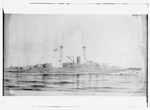 | 82k | U.S. Battleship California (BB-44). Note that there is only one funnel in this drawing. | Digital ID # ggbain 20144v, LC-B2-3635-1. Source: Library of Congress Prints and Photographs Division, from the George Grantham Bain Collection. | ||||||||||||||||||||||||||||||||||||||||||||||||||||||||||||||||||||||||||||||||||||||||||||||||||||||||||||||||||||||||||||||||||||||||||||||||||||||||||||||||||||||||||||||||||||||||||||||||||||||||||||||||||||||||||||||||||||||||||||||||||||||||||||||||||||||||||||||||||||||||||||||||||||||||||||||||||||||||||||||||||||||||||||||||||||||||||||||||||||||||||||||||||||||||||||||||||||||||||||||||||||||||||||||||||||||||||||||||||||||||||||||||||||||||||||||||||||||||||||||||||||||||||||||||||||||||||||||||||||||||||||||||||||||||||||||||||||||||||||||||||||||||||||||||||||||||||
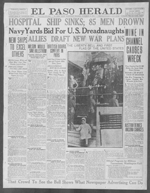 | 950k | Navy Yards Bid For U.S. Dreadnoughts. | Image and text provided by University of North Texas; Denton, TX. Photo from El Paso Herald.(El Paso, Tex.) 1901-1931, 17 November 1915, HOME EDITION, Image 1, via chroniclingamerica.loc.gov. 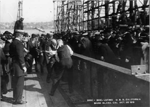 44k | Mayors James Roney of Vallejo & George Drussel of Napa wielded the hammers & Congressman Charles F. Curry and Mayor W. L. Crooks of Benicia heated and held the first rivets to be driven on the keel of the California (BB-44) at Mare Island Navy Yard on 25 October 1916.
| USN photo # 2890, courtesy of Darryl L. Baker. |
 604k | Hats off to Gov. W. D. Stephens as California's (BB-44) keel is laid. | Photo courtesy of Ron Reeves (of blessed memory). |
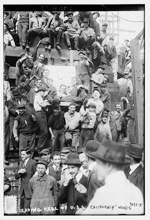 546k | Happy faces abound as California's (BB-44) keel is laid. | Photo courtesy of Ron Reeves (of blessed memory). |
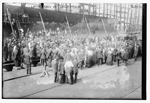 589k | Part of the spectator's witnessing the California's (BB-44) keel laying. | Photo courtesy of Ron Reeves (of blessed memory). |
 102k | Yard Commandant Capt. Frank M. Bennett (left) and Naval Constructor Capt. Henry M. Gleason driving one to the first rivets of California's (BB-44) keel at Mare Island on 25 October 1916.
| USN photo from the 5 May 2002 edition of the Vallejo Times-Herald, courtesy of Vallejo Naval and Historical Museum, submitted by
Darryl L. Baker. |
 3.78k | Start Work On Uncle Sam's New Sea Terror. | Image and text provided by Washington State Library; Olympia, WA. | Photo from The Tacoma Times. (Tacoma, Wash.) 1903-1949, 11 November 1916, Image 2, via chroniclingamerica.loc.gov. 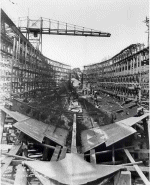 95k | Photo shown the progress on the hull from the stern of the California (BB-44) at Mare Island Navy Yard on 31 March 1917. Most of the double bottom and some bulkhead are in place.
| USN photo # 3096, courtesy of Darryl L. Baker. |
 522k | One of the four 28" all bronze pumps for condenser circulation aboard Battleship New Mexico (BB-40) and California (BB-44) to be driven by electric motors. | Photographer: Alberger Pump & Condenser Co. Newburg, N.Y. |
National Archives Identifier: 45512012 Local Identifier: 165-WW-331F-5 Photo courtesy of catalog.archives.gov 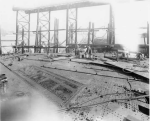 52k | Work on the stern deck plating system is in progress in this April 1919 photo at Mare Island aboard the California (BB-44) on the building ways. On the lower left portion of the picture is a deck area with a pattern of wicking laid out on the deck. This is a process called "stop waters" where wicking soaked in red or white lead is laid out to form a gasket on mutli-ply riveted deck systems. The stern of the US Army Transport Dix is just visible through the staging just right and above the workers. Dix was in dry dock #1 at the yard at the time.
| USN photo courtesy of Darryl L. Baker. |
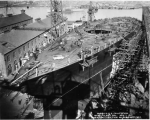 69k | The California (BB-44) is seen under construction on 11/1/1919, 19 days before her launching at Mare Island. Two of the ten 2" wire rope reels designed to brake the launching of the ship can be seen to the left of the bow. The system didn't work, California ended up in the mud on the Vallejo side of the Mare Island channel when she was launched.
| USN photo # 5098, courtesy of Darryl L. Baker. |
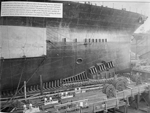 014422 2.65k |
In a general view of the California (BB-44) before the launching, the four starboard brake cable reels and brakes are in view. In the foreground is the starboard hydraulic pump stand by which the brakes were powered. The poppets and wooden shoring referred to as packing supported the massive weight of the ship and were carefully designed to conform to the contours of the hull. The poppets and the packing slid down the greased slipway along with the hull when it was launched. |
Image and text provided by NARA via Bill Stauffer.
| 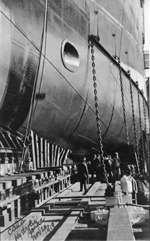 014421s 1.01k |
4 photo PDF of the California's (BB-44) hydraulic launching brakes. |
USN photos courtesy of Darryl L. Baker.
|  153k | Possible artwork by F. Muller depicting the California (BB-44) "as she will appear" following her launching at Mare Island Navy Yard on 20 November 1919.
| USN photo courtesy of Robert M. Cieri. | Text courtesy of DANFS. 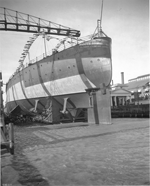 1.90k | Port side stern view of the California (BB-44) on the morning of launching at Mare Island. | USN photo #5252, courtesy of Darryl L. Baker. | 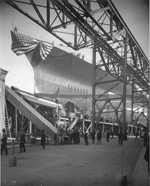 1.80k | Port side bow view of the California (BB-44) on the morning of launching at Mare Island. | USN photo #5429, courtesy of Darryl L. Baker. | 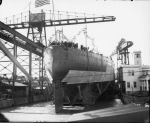 219k | The stern of the California (BB-44) just prior to her launching at Mare Island Navy Yard on 20 November 1919. Note that her screws have not been installed.
| USN photo courtesy of Darryl L. Baker. | 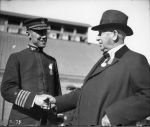 187k | Capt Henry M. Gleason, Naval Constructor, Head of Hull Division and California Governor William Stephens shake hands during the launching ceremonies for the California (BB-44) at Mare Island Navy Yard on 20 November 1919. | USN photo courtesy of Darryl L. Baker. |  58k | Admiral Rodman & California Governor William Stephens shake hands during the launching ceremonies. | USN photo courtesy of Robert M. Cieri. |  61k | Admiral Rodman, who commanded the American Battle Fleet while it was attached to the British Grand Fleet during WW I & Sec/Navy Daniels share a smile during the launching ceremonies. | USN photo courtesy of Robert M. Cieri. | 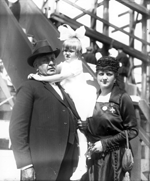 500k | California Governor William Stephens is seen with his grand daughter Marjorie Zane and daughter Barbara Stephens Zane (Ship's Sponsor) at the launching of the California (BB-44) at Mare Island on 20 November 1919. | USN photo courtesy of Darryl L. Baker. |
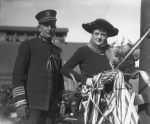 170k | Mrs. Barbara Stephens Zane, daughter of Governor William Stephens (California) was the sponsor when the California (BB-44) was launched at Mare Island Navy Yard on 20 November 1919. With her is Capt. Frank M. Clark, USN, who was serving as aide.
| USN photo courtesy of Darryl L. Baker. | 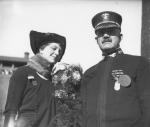 139k | Sponsor Mrs. Barbara Stephens Zane, daughter of Governor William Stephens(California) was sponsor when the California (BB-44) was launched at Mare Island Navy Yard on 20 November 1919. With her is Capt. Edward L. Beach, USN, Commandant, Mare Island Navy Yard. | USN photo courtesy of Darryl L. Baker. | 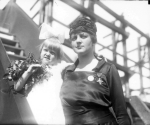 154k | Young Marjorie Zane was Maid of Honor when her mother, Mrs. Barbara Stephens Zane, daughter of Governor William Stephens(California) was sponsor when the California (BB-44) was launched at Mare Island Navy Yard on 20 November 1919. The roles had been reversed on 12 August 1919 when the daughter christened the Zane (DD-337) named for her late father.
| USN photo courtesy of Darryl L. Baker. | 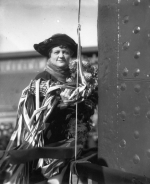 168k | Mrs. Barbara Stephens Zane, daughter of Governor William Stephens (California) was sponsor when the California (BB-44) was launched at Mare Island Navy Yard on 20 November 1919.
| USN photo courtesy of Darryl L. Baker. | 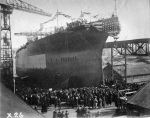 121k | The California (BB-44) is ready to be christened on 20 November 1919 at Mare Island Navy Yard.
| USN photo courtesy of Darryl L. Baker. | 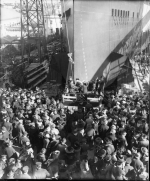 302k | Sponsor, Mrs. Barbara Stephens Zane is preparing to christen the California (BB-44) at Mare Island Navy Yard on 20 November 1919.
| USN photo courtesy of Darryl L. Baker. | 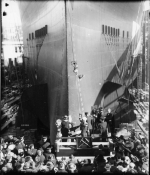 217k | Mrs. Barbara Stephens Zane crashes a bottle of Hetch-Hetchy water to christen the California (BB-44) at Mare Island Navy Yard on 20 November 1919. The sailor in the center playing the trumpet is most likely playing "Anchors Aweigh".
| Partial text courtesy of David Johnston, USNR. | USN photo courtesy of Darryl L. Baker. 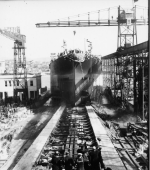 213k | Sliding down the building ways during her launching, at the Mare Island Navy Yard, California, 20 November 1919. The ship's sponsor, Mrs. R.T. Zane is on the left). | USN photo courtesy of Darryl L. Baker. |
 245k | Waterborn after sliding down the building ways during her launching, at the Mare Island Navy Yard, California, 20 November 1919. | USN photo courtesy of Darryl L. Baker. |
 172k | California (BB-44) as she enters the water during launching at Mare Island Navy Yard on 20 November 1919. | USN photo courtesy of Darryl L. Baker. |  163k | Close-up of California is about to hit the Vallejo side of the channel. | USN photo courtesy of Darryl L. Baker. |  152k | With flags flying, the stern of California is on the mud on Vallejo side of the channel after her launching. | USN photo courtesy of Darryl L. Baker. |  229k | Not exactly as imagined: The bow view of California on the mud on Vallejo side of the channel after her launching at Mare Island Navy Yard on 20 November 1919. | USN photo courtesy of Darryl L. Baker. |  410k | The California is seen on the mud on the Vallejo side. | Photo from the book "Sidewheelers to Nuclear Power" written by by Sue Lemmon & E. D. Wichels, submitted by Darryl L. Baker. |  134k | Tugs are seen pulling the California off the mud on Vallejo side of the channel. The boat in the foreground to the left is Mare Island built Ambulance Boat (YH-1).
| USN photo courtesy of Darryl L. Baker. |  118k | Tugs are seen moving the California to her berth at Mare Island after her launching. The large double stack tug is the Navigator YT-39, and there is one of the yards motor tugs along side her.
| USN photo courtesy of Darryl L. Baker. | 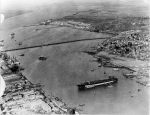 141k | Aerial view of the California (BB-44) in mid stream after her launching at Mare Island on 20 November 1919. Other ships on the yard's waterfront on that date include from the top to bottom are: Tacoma (C-18) & Denver (C-14); below the cruisers are the battleships Nebraska (BB-14) & Georgia (BB-15); below the battleships and partially hiden by smoke are the destroyers Hamilton (DD-141), Litchfield (DD-336), Zane (DD-337) & Kennison (DD-138); below the destroyers is the outfitting berth for California; in dry dock #1 are H-7 (SS-150) & Lamberton (DD-119); and finally the bottom ship is the USAT Madawaska.
| USN photo courtesy of Darryl L. Baker. |
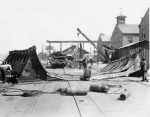 61k | The stern launch cradle of the California (BB-44) being cutup for scrap after its recovery from the Vallejo side of the Mare Island Channel after the ship went aground on her launching. | USN photo courtesy of Darryl L. Baker. | 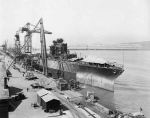 73k | Bow photo of the California (BB-44) at her outfitting dock at Mare Island Navy Yard circa February - March 1920. | USN photo courtesy of Darryl L. Baker. |
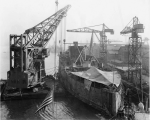 614k | Stern photo of the California (BB-44) at her outfitting dock at Mare Island Navy Yard sometime between 7 February & 24 February 1920. This timeframe established by the dry docking dates of the Rhode Island (BB-17); her masts and stacks are just visible to the right of the California superstructure. Also, USAT Grant & the Comfort are aft of the California. YD-33 is along side of the California. | USN photo courtesy of Darryl L. Baker. |
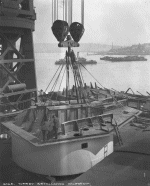 251k | Caption reads: "Turret installation, California (BB-44), Mare Island, California." Circa March - April 1920. | Seattle NARA photo # 6065. 13th Naval District,
Records of the Naval District & Shore Establishments,courtesy of Tracy White @ researcheratlarge.com |
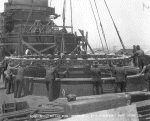 105k | Caption reads: "Installing live ring on turret # 1, California (BB-44), Mare Island, California." Circa May 1920. A number of 4 stack destroyers are visible moored to the Mare Island to Vallejo causeway. | There were a large number of the destroyers at the yard in this berthing area in the 1919-1921 years. Seattle NARA photo # 6060. 13th Naval District,
Records of the Naval District & Shore Establishments, courtesy of . |
Text courtesy of Darryl L. Baker. 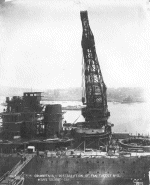 103k | Caption reads: "Installation of fan turret # 2, California (BB-44), Mare Island, California." Circa May 1920. | The crane is YD-33 (150 tons) purchased in 1918 by Mare Island. Vallejo Yacht Club is just visible to the right of the crane. Seattle NARA photo # 6063. 13th Naval District,
Records of the Naval District & Shore Establishments, . |
Text courtesy of Darryl L. Baker. 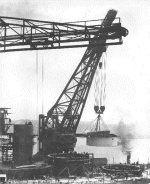 76k | Caption reads: "Installation of fan turret # 2, California (BB-44), Mare Island, California." Circa May 1920. | The bell tower of St. Vincent church (on the hill) can just be seen between the crane's boom and the turret. Seattle NARA photo # 6069. 13th Naval District,
Records of the Naval District & Shore Establishments, courtesy of Tracy White @ researcheratlarge.com |
Text courtesy of Darryl L. Baker. 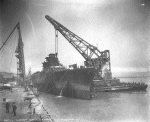 82k | Caption reads: "Turret installation, California (BB-44), Mare Island, California." Circa May 1920. | Stiff leg crane(Left) was used at the yard for launching small tugs and lifting boilers and engines. Used to install the diesel engine in Maumee (AO-2). Seattle NARA photo # 6071. 13th Naval District,
Records of the Naval District & Shore Establishments,courtesy of Tracy White @ researcheratlarge.com |
Text courtesy of Darryl L. Baker. 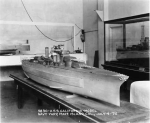 40k | Model of the California (BB-44) made at Mare Island 9 July 1920 to aid in her construction.
| USN photo # 5830, courtesy of Darryl L. Baker. |
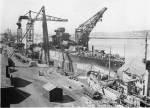 71k | Bow photo of the California (BB-44) at her outfitting dock at Mare Island Navy Yard on 2 August 1920. The US Army Corps Dredge San Pablo is the ship berthed next to the seawall forward of the California.
| USN photo # 5148, courtesy of Darryl L. Baker. |
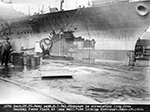 689k | Water collects on the pier in front of the California (BB-44) due to a stoppage in the central power plant on 27 September 1920. Note the old cannon being used as a bollard at the bow of the ship. | USN photo # MINSY 3775-9-20, courtesy of Darryl L. Baker.
| 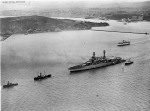 85k | The California (BB-44) is seen on the South end of Mare Island on 29 November 1920. She is under tow to Hunters Point Shipyard for dry docking for removal of launching cradle. The ferry to the right of California is the General Frisbie.
| USN photo courtesy of Darryl L. Baker. |
 478k | The California (BB-44) is under tow in San Francisco bay by several tugs including the steam tug Hercules. | Photo courtesy of the SF Maritime NHP, Maritime Research Center, # B5.39,460n, courtesy of Christopher Edwards. |
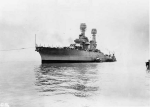 62k | Bows on view of the California (BB-44) in the Mare Island channel on 29 November 1920. She is under tow to Hunters Point Shipyard for dry docking for removal of launching cradle. Note the main battery has not yet been installed. | USN photo courtesy of Darryl L. Baker. |
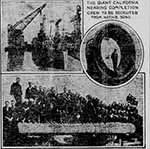 NR | THE GIANT CALIFORNIA (BB-44) NEARING COMPLETION. CREW TO BE RECRUITED FROM NATIVE S0NS.
| Image and text provided by Oklahoma Historical Society. | Photo from The Daily Ardmoreite. (Ardmore, Okla.) 1893-current, 12 December 1920, FINAL EDITION, Image 5, via chroniclingamerica.loc.gov. 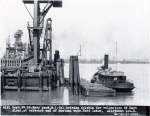 133k | Caption reads: "4131 Dept. PW. US Navy yard, M.I. Cal. Driving dolphins for relocation of Dart (Yard Ferry on the right) at outboard end of Montana (BB-51) ways. Yard Labor, allotment 124-3." Note: The two gauged masts of the California (BB-44) being outfitted at Mare Island at the time can be seen in the background (left). A large number of four pipe destroyers can also be seen in the background. Shipyard log of 3/17/21 indicates that there were 24 destroyers at the yard at this time.
| USN photo # 4131, courtesy of Darryl L. Baker. | 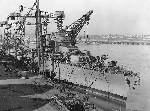 475k | Bow photo of the California (BB-44) at her outfitting dock at Mare Island Navy Yard circa late March 1921. | There are 3 four pipe Destroyers moored in the background. Shipyard log of 3/17/21 indicates that there were 24 destroyers at the yard at this time. Photo courtesy of the Vallejo Naval and Historical Museum & battleshipiowa.org. & submitted by Bill Gonyo. |
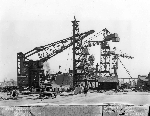 715k | Bow view of the California (BB-44) at her outfitting berth with YD 33 alongside on 30 March 1921. Note: One of her forward 14" guns has been installed. | USN photo courtesy of Darryl L. Baker. |
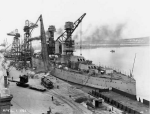 81k | California (BB-44) at her outfitting berth at Mare Island on 1 April 1921. This photo has a rare view of one of the shipyard steam locomotives (She is pulling a tank car).
| USN photo courtesy of Darryl L. Baker. |
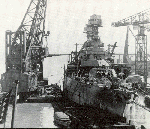 142k | Fitting out at Mare Island Navy Yard, The crane at left is swinging one of her 14"/50 guns onto the ship for mounting, circa June 1921. | NHC / USN. | 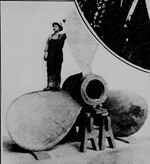 783k | SOME PROPELLOR! | One of the four huge bronze screws, measuring 13 feet 6 inches in diameter and weighing 13,900 pounds apiece which, revolving at 170 turns a minute will drive Uncle Sam's newest dreadnought, the mighty California (BB-44) now nearing completion on the Pacific Coast. Image and text provided by Library of Congress, Washington, DC. |
Photo from New-York Tribune. (New York [N.Y.]) 1866-1924, 17 July 1921, Graphic Section, Image 61, courtesy of chroniclingamerica.loc.gov. 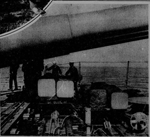 593k | TESTING A BATTLESHIP'S DECKS. | Before the big guns and superstructure of the mighty California (BB-44) were put in place, tracks were laid and huge steel blocks weighing some twenty thousand tons were run from side to side in order to make sure that the dreadnought's deck measured up to specifications as far as strength was concerned. Image and text provided by Library of Congress, Washington, DC. |
Photo from New-York Tribune. (New York [N.Y.]) 1866-1924, 18 September 1921, Graphic Section, Image 63, via chroniclingamerica.loc.gov.  01445h 345k |
In this photograph we can see the twelve guns at the Mare Island Naval Shipyard. The shed-like structure may be to protect the breech mechanism. The barrel was just over 18 metres long and weighed 80 metric tons. |
Photo courtesy of Yu Chu. | 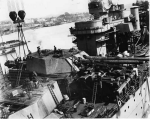 124k | The California (BB-44) at her outfitting berth at Mare Island Navy Yard circa 1921. Workers are installing one of California's 14 inch guns into turret number 2.
| USN photo courtesy of Darryl L. Baker. |
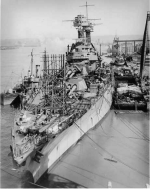 105k | The California (BB-44) at her outfitting berth at Mare Island Navy Yard circa 1921.
Structure forward of turrets 1 and 2 appear to be alignment battens for the 14 inch guns.
| USN photo courtesy of Darryl L. Baker. |
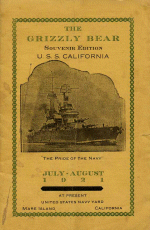 1.14k | Thirty One page PDF - July 1921 - Launching Program - Mare Island History. | The front over of the magazine "The Grizzly Bear", July-August 1921, published by the California (BB-44) prior to her commissioning. It appears that it was printed by the California on an annual basis. Printing cost was covered by advertisements. The ship on the cover is not likely to be California since she didn't have screws installed until late August 1921 and didn't leave dry dock at Hunters Point until September 1921. Courtesy of Darryl L. Baker. |
 2.44k | California (BB-44) on her commissioning day at Mare Island Navy Yard on 10 August 1921.
| USN photo courtesy of Darryl L. Baker. | 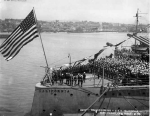 85k | The commissioning ceremony aboard California (BB-44), at Mare Island Navy Yard on 10 August 1921. The Avocet (AM-19) is alongside the California's port side.
| USN photo # 6627, courtesy of Darryl L. Baker. |
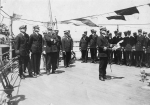 93k | Capt. Henry J. Ziegemeier, Commanding Officer, of the California (BB-44) address those gather to watch the commissioning of the ship at Mare Island Navy Yard on 10 August 1921. The three officers to the left are from Mare Island and they are Capt Henry M. Gleason, Capt. Milton E. Reed, and Capt Edward L. Beach, Commandant of the shipyard.
| USN photo courtesy of Darryl L. Baker. |  130k | The California (BB-44) and Avocet (AM-19) in the Mare Island Channel in August 1921. I'm not sure why California was in the channel; changing berth, battery alignment, etc, but she (California ) had no screw at the time so Avocet was being used as a tug.
| USN photo courtesy of Darryl L. Baker. |
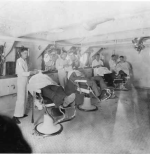 31k | The barber shop aboard the California (BB-44), circa 1921.
| USN photo courtesy of Darryl L. Baker. |
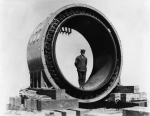 37k | The field coil of California's (BB-44) 4 main motors prior to installation.
| USN photo courtesy of Darryl L. Baker. |
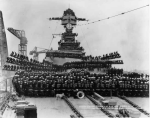 53k | The commissioning crew of the California (BB-44) is pictured shortly after her commissioning at Mare Island Navy Yard on 10 August 1921. Ship's mascots are seen in front of the crew; goat to the left was named William or Billy Vallejo, a dog (unknown) and the 5 week old cinnamon bear Yosemite Prunes. There are reports that there were numerous additional dogs and cats not pictured. | USN photo courtesy of Darryl L. Baker. |
Image and text provided by Oklahoma Historical Society. Photo from The Beaver Herald. (Beaver, O.T. [Okla.]) 1895-1923, 25 May 1921, Image 6, via chroniclingamerica.loc.gov. |
||||||||||||||||||||||||||||||||||||||||||||||||||||||||||||||||||||||||||||||||||||||||||||||||||||||||||||||||||||||||||||||||||||||||||||||||||||||||||||||||||||||||||||||||||||||||||||||||||||||||||||||||||||||||||||||||||||||||||||||||||||||||||||||||||||||||||||||||||||||||||||||||||||||||||||||||||||||||||||||||||||||||||||||||||||||||||||||||||||||||||||||||||||||||
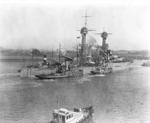 | 3.25k | California (BB-44) shortly after commissioning 20 August 1921 departing Mare Island for the last time. She is on her way to Hunters Point Shipyard in San Francisco for installation of her screws and bottom paint job. The tugs assisting California are Unadilla (YT-4) (forward) and Undaunted (AT-58) (rear) on the starboard side. | Text courtesy of Darryl L. Baker. Photo courtesy of David Buell. | ||||||||||||||||||||||||||||||||||||||||||||||||||||||||||||||||||||||||||||||||||||||||||||||||||||||||||||||||||||||||||||||||||||||||||||||||||||||||||||||||||||||||||||||||||||||||||||||||||||||||||||||||||||||||||||||||||||||||||||||||||||||||||||||||||||||||||||||||||||||||||||||||||||||||||||||||||||||||||||||||||||||||||||||||||||||||||||||||||||||||||||||||||||||||||||||||||||||||||||||||||||||||||||||||||||||||||||||||||||||||||||||||||||||||||||||||||||||||||||||||||||||||||||||||||||||||||||||||||||||||||||||||||||||||||||||||||||||||||||||||||||||||||||||||||||||||||
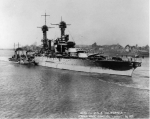 | 77k | Bow view of the California (BB-44) shortly after commissioning 20 August 1921 departing Mare Island for the last time. She is on her way to Hunters Point Shipyard in San Francisco for installation of her screws and bottom paint job. The tugs assisting California are Unadilla (YT-4) (rear) and Undaunted (AT-58) (forward) on the starboard side. | USN photo # 6628, courtesy of Darryl L. Baker. | ||||||||||||||||||||||||||||||||||||||||||||||||||||||||||||||||||||||||||||||||||||||||||||||||||||||||||||||||||||||||||||||||||||||||||||||||||||||||||||||||||||||||||||||||||||||||||||||||||||||||||||||||||||||||||||||||||||||||||||||||||||||||||||||||||||||||||||||||||||||||||||||||||||||||||||||||||||||||||||||||||||||||||||||||||||||||||||||||||||||||||||||||||||||||||||||||||||||||||||||||||||||||||||||||||||||||||||||||||||||||||||||||||||||||||||||||||||||||||||||||||||||||||||||||||||||||||||||||||||||||||||||||||||||||||||||||||||||||||||||||||||||||||||||||||||||||||
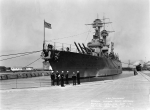 | 79k | The California (BB-44) has just entered dry dock at Hunters Point, Bethlehem Shipbuilding Corp on 22 August 1921 at Union Plant, San Francisco, Calif. It appears that the dry dock caisson is being placed to seal the dry dock. | USN photo courtesy of Darryl L. Baker. | ||||||||||||||||||||||||||||||||||||||||||||||||||||||||||||||||||||||||||||||||||||||||||||||||||||||||||||||||||||||||||||||||||||||||||||||||||||||||||||||||||||||||||||||||||||||||||||||||||||||||||||||||||||||||||||||||||||||||||||||||||||||||||||||||||||||||||||||||||||||||||||||||||||||||||||||||||||||||||||||||||||||||||||||||||||||||||||||||||||||||||||||||||||||||||||||||||||||||||||||||||||||||||||||||||||||||||||||||||||||||||||||||||||||||||||||||||||||||||||||||||||||||||||||||||||||||||||||||||||||||||||||||||||||||||||||||||||||||||||||||||||||||||||||||||||||||||
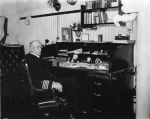 | 39k | Photo of Capt. Henry J. Ziegemeier, USN, California (BB-44) first commanding officer at his desk aboard the battleship on 27 August 1921. | USN photo # 9031, courtesy of Darryl L. Baker. | ||||||||||||||||||||||||||||||||||||||||||||||||||||||||||||||||||||||||||||||||||||||||||||||||||||||||||||||||||||||||||||||||||||||||||||||||||||||||||||||||||||||||||||||||||||||||||||||||||||||||||||||||||||||||||||||||||||||||||||||||||||||||||||||||||||||||||||||||||||||||||||||||||||||||||||||||||||||||||||||||||||||||||||||||||||||||||||||||||||||||||||||||||||||||||||||||||||||||||||||||||||||||||||||||||||||||||||||||||||||||||||||||||||||||||||||||||||||||||||||||||||||||||||||||||||||||||||||||||||||||||||||||||||||||||||||||||||||||||||||||||||||||||||||||||||||||||
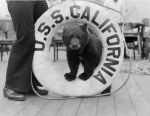 | 39k | The California's (BB-44) mascot bear Yosemite Prunes. | USN photo courtesy of Darryl L. Baker. | ||||||||||||||||||||||||||||||||||||||||||||||||||||||||||||||||||||||||||||||||||||||||||||||||||||||||||||||||||||||||||||||||||||||||||||||||||||||||||||||||||||||||||||||||||||||||||||||||||||||||||||||||||||||||||||||||||||||||||||||||||||||||||||||||||||||||||||||||||||||||||||||||||||||||||||||||||||||||||||||||||||||||||||||||||||||||||||||||||||||||||||||||||||||||||||||||||||||||||||||||||||||||||||||||||||||||||||||||||||||||||||||||||||||||||||||||||||||||||||||||||||||||||||||||||||||||||||||||||||||||||||||||||||||||||||||||||||||||||||||||||||||||||||||||||||||||||
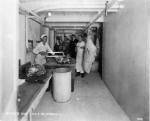 | 36k | The butcher shop aboard the California (BB-44), August 1921. | USN photo # 9098, courtesy of Darryl L. Baker. | ||||||||||||||||||||||||||||||||||||||||||||||||||||||||||||||||||||||||||||||||||||||||||||||||||||||||||||||||||||||||||||||||||||||||||||||||||||||||||||||||||||||||||||||||||||||||||||||||||||||||||||||||||||||||||||||||||||||||||||||||||||||||||||||||||||||||||||||||||||||||||||||||||||||||||||||||||||||||||||||||||||||||||||||||||||||||||||||||||||||||||||||||||||||||||||||||||||||||||||||||||||||||||||||||||||||||||||||||||||||||||||||||||||||||||||||||||||||||||||||||||||||||||||||||||||||||||||||||||||||||||||||||||||||||||||||||||||||||||||||||||||||||||||||||||||||||||
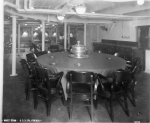 | 40k | Commanding Officer and Flag dining table in the ward room of the California (BB-44) as seen in August 1921. Note the large punchbowl which was part of the ship's silver services. | USN photo # 9035, courtesy of Darryl L. Baker. | ||||||||||||||||||||||||||||||||||||||||||||||||||||||||||||||||||||||||||||||||||||||||||||||||||||||||||||||||||||||||||||||||||||||||||||||||||||||||||||||||||||||||||||||||||||||||||||||||||||||||||||||||||||||||||||||||||||||||||||||||||||||||||||||||||||||||||||||||||||||||||||||||||||||||||||||||||||||||||||||||||||||||||||||||||||||||||||||||||||||||||||||||||||||||||||||||||||||||||||||||||||||||||||||||||||||||||||||||||||||||||||||||||||||||||||||||||||||||||||||||||||||||||||||||||||||||||||||||||||||||||||||||||||||||||||||||||||||||||||||||||||||||||||||||||||||||||
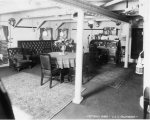 | 51k | View of the Captain's Cabin aboard California (BB-44), on 27 August 1921. Note electric lights and oriental rugs. | USN photo courtesy of Darryl L. Baker. | ||||||||||||||||||||||||||||||||||||||||||||||||||||||||||||||||||||||||||||||||||||||||||||||||||||||||||||||||||||||||||||||||||||||||||||||||||||||||||||||||||||||||||||||||||||||||||||||||||||||||||||||||||||||||||||||||||||||||||||||||||||||||||||||||||||||||||||||||||||||||||||||||||||||||||||||||||||||||||||||||||||||||||||||||||||||||||||||||||||||||||||||||||||||||||||||||||||||||||||||||||||||||||||||||||||||||||||||||||||||||||||||||||||||||||||||||||||||||||||||||||||||||||||||||||||||||||||||||||||||||||||||||||||||||||||||||||||||||||||||||||||||||||||||||||||||||||
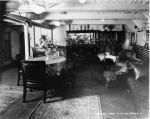 | 51k | View of the other side of the Captain's Cabin aboard California (BB-44) on 27 August 1921. Note the wooden furniture and the steam heating piping on the bulkhead on the right. | USN photo courtesy of Darryl L. Baker. | ||||||||||||||||||||||||||||||||||||||||||||||||||||||||||||||||||||||||||||||||||||||||||||||||||||||||||||||||||||||||||||||||||||||||||||||||||||||||||||||||||||||||||||||||||||||||||||||||||||||||||||||||||||||||||||||||||||||||||||||||||||||||||||||||||||||||||||||||||||||||||||||||||||||||||||||||||||||||||||||||||||||||||||||||||||||||||||||||||||||||||||||||||||||||||||||||||||||||||||||||||||||||||||||||||||||||||||||||||||||||||||||||||||||||||||||||||||||||||||||||||||||||||||||||||||||||||||||||||||||||||||||||||||||||||||||||||||||||||||||||||||||||||||||||||||||||||
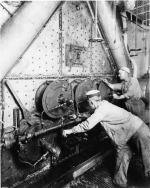 | 63k | Burners for the boilers aboard California (BB-44) circa August 1921. | USN photo # 9090, courtesy of Darryl L. Baker. | ||||||||||||||||||||||||||||||||||||||||||||||||||||||||||||||||||||||||||||||||||||||||||||||||||||||||||||||||||||||||||||||||||||||||||||||||||||||||||||||||||||||||||||||||||||||||||||||||||||||||||||||||||||||||||||||||||||||||||||||||||||||||||||||||||||||||||||||||||||||||||||||||||||||||||||||||||||||||||||||||||||||||||||||||||||||||||||||||||||||||||||||||||||||||||||||||||||||||||||||||||||||||||||||||||||||||||||||||||||||||||||||||||||||||||||||||||||||||||||||||||||||||||||||||||||||||||||||||||||||||||||||||||||||||||||||||||||||||||||||||||||||||||||||||||||||||||
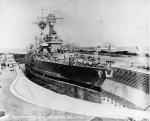 | 88k | The California (BB-44) in dry dock at Hunters Point Shipyard on 27 August 1921. She was in dry dock for installation of her screws and to get a bottom paint job. | USN photo # 9742A, courtesy of Darryl L. Baker. | ||||||||||||||||||||||||||||||||||||||||||||||||||||||||||||||||||||||||||||||||||||||||||||||||||||||||||||||||||||||||||||||||||||||||||||||||||||||||||||||||||||||||||||||||||||||||||||||||||||||||||||||||||||||||||||||||||||||||||||||||||||||||||||||||||||||||||||||||||||||||||||||||||||||||||||||||||||||||||||||||||||||||||||||||||||||||||||||||||||||||||||||||||||||||||||||||||||||||||||||||||||||||||||||||||||||||||||||||||||||||||||||||||||||||||||||||||||||||||||||||||||||||||||||||||||||||||||||||||||||||||||||||||||||||||||||||||||||||||||||||||||||||||||||||||||||||||
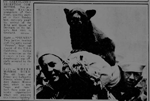 | 699k | Right "PRUNES." Two jackies bearing aloft the aptly named "Prunes", bear cub mascot of the California (BB-44) during the cermonies on the Coast when the dreadnought was officially accepted by the Navy. | Image and text provided by Library of Congress, Washington, DC. Photo from New-York Tribune. (New York [N.Y.]) 1866-1924, 28 August 1921, Image 67, via chroniclingamerica.loc.gov. |
||||||||||||||||||||||||||||||||||||||||||||||||||||||||||||||||||||||||||||||||||||||||||||||||||||||||||||||||||||||||||||||||||||||||||||||||||||||||||||||||||||||||||||||||||||||||||||||||||||||||||||||||||||||||||||||||||||||||||||||||||||||||||||||||||||||||||||||||||||||||||||||||||||||||||||||||||||||||||||||||||||||||||||||||||||||||||||||||||||||||||||||||||||||||||||||||||||||||||||||||||||||||||||||||||||||||||||||||||||||||||||||||||||||||||||||||||||||||||||||||||||||||||||||||||||||||||||||||||||||||||||||||||||||||||||||||||||||||||||||||||||||||||||||||||||||||||
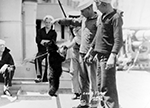 | 495k | Bear Cub Mascot. U.S. Navy Personnel with their bear cub mascot on board a U.S. Navy ship, (I am guessing California (BB-44)) circa 1920s. | USN photo # NH 72955, courtesy of the Library of Congress, from the National Museum of the U.S. Navy, courtesy of flickr.com. | ||||||||||||||||||||||||||||||||||||||||||||||||||||||||||||||||||||||||||||||||||||||||||||||||||||||||||||||||||||||||||||||||||||||||||||||||||||||||||||||||||||||||||||||||||||||||||||||||||||||||||||||||||||||||||||||||||||||||||||||||||||||||||||||||||||||||||||||||||||||||||||||||||||||||||||||||||||||||||||||||||||||||||||||||||||||||||||||||||||||||||||||||||||||||||||||||||||||||||||||||||||||||||||||||||||||||||||||||||||||||||||||||||||||||||||||||||||||||||||||||||||||||||||||||||||||||||||||||||||||||||||||||||||||||||||||||||||||||||||||||||||||||||||||||||||||||||
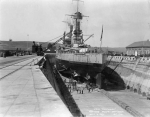 | 67k | The California (BB-44) is seen in dry dock at Hunters Point, Bethlehem Shipbuilding Corp in San Francisco on 6 September 1921. Good photo of her screws and rudder. Note the new paint job to the hull. | USN photo courtesy of Darryl L. Baker. | ||||||||||||||||||||||||||||||||||||||||||||||||||||||||||||||||||||||||||||||||||||||||||||||||||||||||||||||||||||||||||||||||||||||||||||||||||||||||||||||||||||||||||||||||||||||||||||||||||||||||||||||||||||||||||||||||||||||||||||||||||||||||||||||||||||||||||||||||||||||||||||||||||||||||||||||||||||||||||||||||||||||||||||||||||||||||||||||||||||||||||||||||||||||||||||||||||||||||||||||||||||||||||||||||||||||||||||||||||||||||||||||||||||||||||||||||||||||||||||||||||||||||||||||||||||||||||||||||||||||||||||||||||||||||||||||||||||||||||||||||||||||||||||||||||||||||||
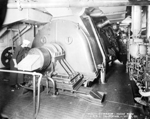 | 1.84k | Generator in the engine room aboard California (BB-44) on 6 September 1921. | USN photo AL 288 MI-058 from the files of the Vallejo Naval & Historical Museum via Darryl L. Baker. | ||||||||||||||||||||||||||||||||||||||||||||||||||||||||||||||||||||||||||||||||||||||||||||||||||||||||||||||||||||||||||||||||||||||||||||||||||||||||||||||||||||||||||||||||||||||||||||||||||||||||||||||||||||||||||||||||||||||||||||||||||||||||||||||||||||||||||||||||||||||||||||||||||||||||||||||||||||||||||||||||||||||||||||||||||||||||||||||||||||||||||||||||||||||||||||||||||||||||||||||||||||||||||||||||||||||||||||||||||||||||||||||||||||||||||||||||||||||||||||||||||||||||||||||||||||||||||||||||||||||||||||||||||||||||||||||||||||||||||||||||||||||||||||||||||||||||||
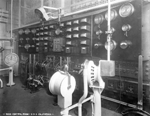 | 1.68k | Main Control Room (Engine room) aboard California (BB-44) circa 1921-22. | USN photo AL 288 MI-059 from the files of the Vallejo Naval & Historical Museum via Darryl L. Baker. | ||||||||||||||||||||||||||||||||||||||||||||||||||||||||||||||||||||||||||||||||||||||||||||||||||||||||||||||||||||||||||||||||||||||||||||||||||||||||||||||||||||||||||||||||||||||||||||||||||||||||||||||||||||||||||||||||||||||||||||||||||||||||||||||||||||||||||||||||||||||||||||||||||||||||||||||||||||||||||||||||||||||||||||||||||||||||||||||||||||||||||||||||||||||||||||||||||||||||||||||||||||||||||||||||||||||||||||||||||||||||||||||||||||||||||||||||||||||||||||||||||||||||||||||||||||||||||||||||||||||||||||||||||||||||||||||||||||||||||||||||||||||||||||||||||||||||||
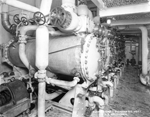 | 1.82k | Evaporators aboard California (BB-44) circa 1921-22. | USN photo AL 288 MI-060 from the files of the Vallejo Naval & Historical Museum via Darryl L. Baker. | ||||||||||||||||||||||||||||||||||||||||||||||||||||||||||||||||||||||||||||||||||||||||||||||||||||||||||||||||||||||||||||||||||||||||||||||||||||||||||||||||||||||||||||||||||||||||||||||||||||||||||||||||||||||||||||||||||||||||||||||||||||||||||||||||||||||||||||||||||||||||||||||||||||||||||||||||||||||||||||||||||||||||||||||||||||||||||||||||||||||||||||||||||||||||||||||||||||||||||||||||||||||||||||||||||||||||||||||||||||||||||||||||||||||||||||||||||||||||||||||||||||||||||||||||||||||||||||||||||||||||||||||||||||||||||||||||||||||||||||||||||||||||||||||||||||||||||
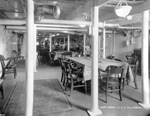 | 1.54k | Ward room aboard the California (BB-44) circa 1921-22. | USN photo AL 288 MI-062 from the files of the Vallejo Naval & Historical Museum via Darryl L. Baker. | ||||||||||||||||||||||||||||||||||||||||||||||||||||||||||||||||||||||||||||||||||||||||||||||||||||||||||||||||||||||||||||||||||||||||||||||||||||||||||||||||||||||||||||||||||||||||||||||||||||||||||||||||||||||||||||||||||||||||||||||||||||||||||||||||||||||||||||||||||||||||||||||||||||||||||||||||||||||||||||||||||||||||||||||||||||||||||||||||||||||||||||||||||||||||||||||||||||||||||||||||||||||||||||||||||||||||||||||||||||||||||||||||||||||||||||||||||||||||||||||||||||||||||||||||||||||||||||||||||||||||||||||||||||||||||||||||||||||||||||||||||||||||||||||||||||||||||
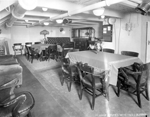 | 1.63k | Junior officer's mess aboard California (BB-44) circa 1921-22. | USN photo AL 288 MI-063 from the files of the Vallejo Naval & Historical Museum via Darryl L. Baker. | ||||||||||||||||||||||||||||||||||||||||||||||||||||||||||||||||||||||||||||||||||||||||||||||||||||||||||||||||||||||||||||||||||||||||||||||||||||||||||||||||||||||||||||||||||||||||||||||||||||||||||||||||||||||||||||||||||||||||||||||||||||||||||||||||||||||||||||||||||||||||||||||||||||||||||||||||||||||||||||||||||||||||||||||||||||||||||||||||||||||||||||||||||||||||||||||||||||||||||||||||||||||||||||||||||||||||||||||||||||||||||||||||||||||||||||||||||||||||||||||||||||||||||||||||||||||||||||||||||||||||||||||||||||||||||||||||||||||||||||||||||||||||||||||||||||||||||
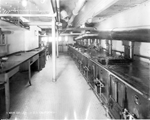 | 1.76k | Main galley aboard California (BB-44) circa 1921-22. | USN photo AL 288 MI-064 from the files of the Vallejo Naval & Historical Museum via Darryl L. Baker. | ||||||||||||||||||||||||||||||||||||||||||||||||||||||||||||||||||||||||||||||||||||||||||||||||||||||||||||||||||||||||||||||||||||||||||||||||||||||||||||||||||||||||||||||||||||||||||||||||||||||||||||||||||||||||||||||||||||||||||||||||||||||||||||||||||||||||||||||||||||||||||||||||||||||||||||||||||||||||||||||||||||||||||||||||||||||||||||||||||||||||||||||||||||||||||||||||||||||||||||||||||||||||||||||||||||||||||||||||||||||||||||||||||||||||||||||||||||||||||||||||||||||||||||||||||||||||||||||||||||||||||||||||||||||||||||||||||||||||||||||||||||||||||||||||||||||||||
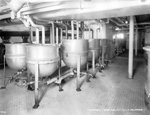 | 1.83k | Main galley Coppers aboard California (BB-44) circa 1921-22. | USN photo AL 288 MI-065 from the files of the Vallejo Naval & Historical Museum via Darryl L. Baker. | ||||||||||||||||||||||||||||||||||||||||||||||||||||||||||||||||||||||||||||||||||||||||||||||||||||||||||||||||||||||||||||||||||||||||||||||||||||||||||||||||||||||||||||||||||||||||||||||||||||||||||||||||||||||||||||||||||||||||||||||||||||||||||||||||||||||||||||||||||||||||||||||||||||||||||||||||||||||||||||||||||||||||||||||||||||||||||||||||||||||||||||||||||||||||||||||||||||||||||||||||||||||||||||||||||||||||||||||||||||||||||||||||||||||||||||||||||||||||||||||||||||||||||||||||||||||||||||||||||||||||||||||||||||||||||||||||||||||||||||||||||||||||||||||||||||||||||
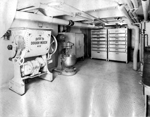 | 2.30k | Bake shop aboard California (BB-44) circa 1921-22. | USN photo AL 288 MI-066 from the files of the Vallejo Naval & Historical Museum via Darryl L. Baker. | ||||||||||||||||||||||||||||||||||||||||||||||||||||||||||||||||||||||||||||||||||||||||||||||||||||||||||||||||||||||||||||||||||||||||||||||||||||||||||||||||||||||||||||||||||||||||||||||||||||||||||||||||||||||||||||||||||||||||||||||||||||||||||||||||||||||||||||||||||||||||||||||||||||||||||||||||||||||||||||||||||||||||||||||||||||||||||||||||||||||||||||||||||||||||||||||||||||||||||||||||||||||||||||||||||||||||||||||||||||||||||||||||||||||||||||||||||||||||||||||||||||||||||||||||||||||||||||||||||||||||||||||||||||||||||||||||||||||||||||||||||||||||||||||||||||||||||
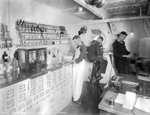 | 2.78k | Medical dispensary aboard California (BB-44) circa 1921-22. | USN photo AL 288 MI-067 from the files of the Vallejo Naval & Historical Museum via Darryl L. Baker. | ||||||||||||||||||||||||||||||||||||||||||||||||||||||||||||||||||||||||||||||||||||||||||||||||||||||||||||||||||||||||||||||||||||||||||||||||||||||||||||||||||||||||||||||||||||||||||||||||||||||||||||||||||||||||||||||||||||||||||||||||||||||||||||||||||||||||||||||||||||||||||||||||||||||||||||||||||||||||||||||||||||||||||||||||||||||||||||||||||||||||||||||||||||||||||||||||||||||||||||||||||||||||||||||||||||||||||||||||||||||||||||||||||||||||||||||||||||||||||||||||||||||||||||||||||||||||||||||||||||||||||||||||||||||||||||||||||||||||||||||||||||||||||||||||||||||||||
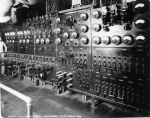 | 64k | Photo of the California's (BB-44) switchboard in the after engine room, date - unknown. | USN photo # 6523, courtesy of Darryl L. Baker. | ||||||||||||||||||||||||||||||||||||||||||||||||||||||||||||||||||||||||||||||||||||||||||||||||||||||||||||||||||||||||||||||||||||||||||||||||||||||||||||||||||||||||||||||||||||||||||||||||||||||||||||||||||||||||||||||||||||||||||||||||||||||||||||||||||||||||||||||||||||||||||||||||||||||||||||||||||||||||||||||||||||||||||||||||||||||||||||||||||||||||||||||||||||||||||||||||||||||||||||||||||||||||||||||||||||||||||||||||||||||||||||||||||||||||||||||||||||||||||||||||||||||||||||||||||||||||||||||||||||||||||||||||||||||||||||||||||||||||||||||||||||||||||||||||||||||||||
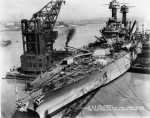 | 102k | The California (BB-44) at her outfitting berth at Mare Island Navy Yard circa 1921. The 150 ton floating crane is on the outboard side. | USN photo courtesy of Darryl L. Baker. | ||||||||||||||||||||||||||||||||||||||||||||||||||||||||||||||||||||||||||||||||||||||||||||||||||||||||||||||||||||||||||||||||||||||||||||||||||||||||||||||||||||||||||||||||||||||||||||||||||||||||||||||||||||||||||||||||||||||||||||||||||||||||||||||||||||||||||||||||||||||||||||||||||||||||||||||||||||||||||||||||||||||||||||||||||||||||||||||||||||||||||||||||||||||||||||||||||||||||||||||||||||||||||||||||||||||||||||||||||||||||||||||||||||||||||||||||||||||||||||||||||||||||||||||||||||||||||||||||||||||||||||||||||||||||||||||||||||||||||||||||||||||||||||||||||||||||||
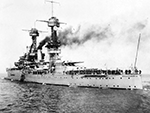 | 548k | Stern view of the California (BB-44) is seen leaving San Francisco Bay in September 1921. | USN photo # 80-G-42637 courtesy of National Museum of the U.S. Navy via flickr.com. | ||||||||||||||||||||||||||||||||||||||||||||||||||||||||||||||||||||||||||||||||||||||||||||||||||||||||||||||||||||||||||||||||||||||||||||||||||||||||||||||||||||||||||||||||||||||||||||||||||||||||||||||||||||||||||||||||||||||||||||||||||||||||||||||||||||||||||||||||||||||||||||||||||||||||||||||||||||||||||||||||||||||||||||||||||||||||||||||||||||||||||||||||||||||||||||||||||||||||||||||||||||||||||||||||||||||||||||||||||||||||||||||||||||||||||||||||||||||||||||||||||||||||||||||||||||||||||||||||||||||||||||||||||||||||||||||||||||||||||||||||||||||||||||||||||||||||||
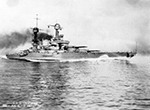 | 1.63k | California (BB-44) on builders trials in October 1921. This is a photo of her Run 18 at 21 knots running East. | Photo courtesy of the Vallejo Naval & Historical Museum via Darryl L. Baker. | ||||||||||||||||||||||||||||||||||||||||||||||||||||||||||||||||||||||||||||||||||||||||||||||||||||||||||||||||||||||||||||||||||||||||||||||||||||||||||||||||||||||||||||||||||||||||||||||||||||||||||||||||||||||||||||||||||||||||||||||||||||||||||||||||||||||||||||||||||||||||||||||||||||||||||||||||||||||||||||||||||||||||||||||||||||||||||||||||||||||||||||||||||||||||||||||||||||||||||||||||||||||||||||||||||||||||||||||||||||||||||||||||||||||||||||||||||||||||||||||||||||||||||||||||||||||||||||||||||||||||||||||||||||||||||||||||||||||||||||||||||||||||||||||||||||||||||
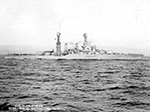 | 764k | California (BB-44) on builders trials in October 1921. This is a photo of her Run 25 backing down running West. The 5-inch directors were incorporated into the large two-storey tops, served by small unarmored range-finders at the navigating bridge level. The main battery was served by a 20-foot range finder atop the pilot house. Note also the squared-off shield on the forward open-mounted 5in/51 gun on her 01 level. Note that, unlike earlier U.S. battleships, she carried no searchlight at all on her foremast. | Text courtesy of U.S. Battleships: An Illustrated Design History by Norman Friedman. Photo courtesy of the Vallejo Naval & Historical Museum via Darryl L. Baker. | ||||||||||||||||||||||||||||||||||||||||||||||||||||||||||||||||||||||||||||||||||||||||||||||||||||||||||||||||||||||||||||||||||||||||||||||||||||||||||||||||||||||||||||||||||||||||||||||||||||||||||||||||||||||||||||||||||||||||||||||||||||||||||||||||||||||||||||||||||||||||||||||||||||||||||||||||||||||||||||||||||||||||||||||||||||||||||||||||||||||||||||||||||||||||||||||||||||||||||||||||||||||||||||||||||||||||||||||||||||||||||||||||||||||||||||||||||||||||||||||||||||||||||||||||||||||||||||||||||||||||||||||||||||||||||||||||||||||||||||||||||||||||||||||||||||||||||
 | 103k | California (BB-44) firing long range. | Courtesy Recruiting Bureau, New York, submitted by Darryl L. Baker. | ||||||||||||||||||||||||||||||||||||||||||||||||||||||||||||||||||||||||||||||||||||||||||||||||||||||||||||||||||||||||||||||||||||||||||||||||||||||||||||||||||||||||||||||||||||||||||||||||||||||||||||||||||||||||||||||||||||||||||||||||||||||||||||||||||||||||||||||||||||||||||||||||||||||||||||||||||||||||||||||||||||||||||||||||||||||||||||||||||||||||||||||||||||||||||||||||||||||||||||||||||||||||||||||||||||||||||||||||||||||||||||||||||||||||||||||||||||||||||||||||||||||||||||||||||||||||||||||||||||||||||||||||||||||||||||||||||||||||||||||||||||||||||||||||||||||||||
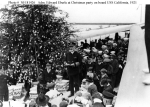 | 100k | Admiral Edward W. Eberle, USN, Commander in Chief, Pacific Fleet, speaking at a Christmas party for local children held on board California (BB-44), off San Pedro, California, in December 1921. | Official USN photo Naval History and Heritage Command # NH 81426, from the collections of the Naval Historical Center. Collection of Rear Admiral B.F. Hutchison, courtesy of Mrs. Worth Sprunt, 1974. | ||||||||||||||||||||||||||||||||||||||||||||||||||||||||||||||||||||||||||||||||||||||||||||||||||||||||||||||||||||||||||||||||||||||||||||||||||||||||||||||||||||||||||||||||||||||||||||||||||||||||||||||||||||||||||||||||||||||||||||||||||||||||||||||||||||||||||||||||||||||||||||||||||||||||||||||||||||||||||||||||||||||||||||||||||||||||||||||||||||||||||||||||||||||||||||||||||||||||||||||||||||||||||||||||||||||||||||||||||||||||||||||||||||||||||||||||||||||||||||||||||||||||||||||||||||||||||||||||||||||||||||||||||||||||||||||||||||||||||||||||||||||||||||||||||||||||||
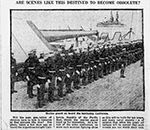 |
NR | ARE SCENES LIKE THIS DESTINED TO BECOME OBSOLETE? Marine guard on board the battleship California (BB-44). Will the next generation of children have to look in histories to find pictures like this? The photo, taken a few days ago on board the superdreadnaught California, flagship of the Pacific fleet, shows the marine guard lined up for inspection. As a result of the arms conference, no more such monster fighting ships as this will be built for ten years, and many naval experts are of opinion that after ten years all nations will be agreed that such vessels are not worth their cost. |
Image and text provided by Indiana State Library. Photo & text by The Richmond Palladium and Sun-Telegram. (Richmond, Ind.) 1907-1939, 31 December 1921, Image 10, via chroniclingamerica.loc.gov. | ||||||||||||||||||||||||||||||||||||||||||||||||||||||||||||||||||||||||||||||||||||||||||||||||||||||||||||||||||||||||||||||||||||||||||||||||||||||||||||||||||||||||||||||||||||||||||||||||||||||||||||||||||||||||||||||||||||||||||||||||||||||||||||||||||||||||||||||||||||||||||||||||||||||||||||||||||||||||||||||||||||||||||||||||||||||||||||||||||||||||||||||||||||||||||||||||||||||||||||||||||||||||||||||||||||||||||||||||||||||||||||||||||||||||||||||||||||||||||||||||||||||||||||||||||||||||||||||||||||||||||||||||||||||||||||||||||||||||||||||||||||||||||||||||||||||||||
| 1922 - 1930 |
|||||||||||||||||||||||||||||||||||||||||||||||||||||||||||||||||||||||||||||||||||||||||||||||||||||||||||||||||||||||||||||||||||||||||||||||||||||||||||||||||||||||||||||||||||||||||||||||||||||||||||||||||||||||||||||||||||||||||||||||||||||||||||||||||||||||||||||||||||||||||||||||||||||||||||||||||||||||||||||||||||||||||||||||||||||||||||||||||||||||||||||||||||||||||||||||||||||||||||||||||||||||||||||||||||||||||||||||||||||||||||||||||||||||||||||||||||||||||||||||||||||||||||||||||||||||||||||||||||||||||||||||||||||||||||||||||||||||||||||||||||||||||||||||||||||||||||||
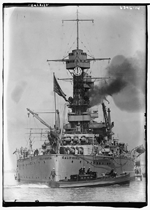 | 122k | One of the California's (BB-44) gigs moves alongside her stern. | Digital ID # ggbain 37966v, LC-B2-6346-14. Source: Library of Congress Prints and Photographs Division. | ||||||||||||||||||||||||||||||||||||||||||||||||||||||||||||||||||||||||||||||||||||||||||||||||||||||||||||||||||||||||||||||||||||||||||||||||||||||||||||||||||||||||||||||||||||||||||||||||||||||||||||||||||||||||||||||||||||||||||||||||||||||||||||||||||||||||||||||||||||||||||||||||||||||||||||||||||||||||||||||||||||||||||||||||||||||||||||||||||||||||||||||||||||||||||||||||||||||||||||||||||||||||||||||||||||||||||||||||||||||||||||||||||||||||||||||||||||||||||||||||||||||||||||||||||||||||||||||||||||||||||||||||||||||||||||||||||||||||||||||||||||||||||||||||||||||||||
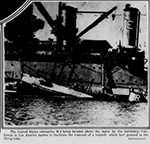 | NR | THE AIR SUBMARINE could be the title of this photo of the R-4 (SS-81) being hoisted above water in the Los Angeles harbor by the battleship California (BB-44) so that workmen could remove a torpedo jammed in the firing tube. | Image and text provided by Library of Congress, Washington, DC. Photo from The Washington Times. (Washington [D.C.]) 1902-1939, 31 October 1922, HOME FINAL EDITION, Image 17, courtesy of chroniclingamerica.loc.gov. |
||||||||||||||||||||||||||||||||||||||||||||||||||||||||||||||||||||||||||||||||||||||||||||||||||||||||||||||||||||||||||||||||||||||||||||||||||||||||||||||||||||||||||||||||||||||||||||||||||||||||||||||||||||||||||||||||||||||||||||||||||||||||||||||||||||||||||||||||||||||||||||||||||||||||||||||||||||||||||||||||||||||||||||||||||||||||||||||||||||||||||||||||||||||||||||||||||||||||||||||||||||||||||||||||||||||||||||||||||||||||||||||||||||||||||||||||||||||||||||||||||||||||||||||||||||||||||||||||||||||||||||||||||||||||||||||||||||||||||||||||||||||||||||||||||||||||||
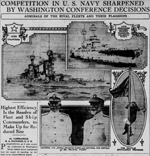 01441z |
NR | COMPETETION IN THE U.S. NAVY SHARPENED BY WASHINGTON CONFERENCE DECISIONS Highest Efficiency Is the Resolve of Fleet and Ship Commanders, to Make Up for Reduced Size ....The better the engineering the greater the speed and steaming radius; and the more accurate the shooting the greater the offensive and defensive power of the fleet. So the two are combined under the heading of "battle efficiency" and each year a little red triangular pennant with a black circle in the center is hoisted on the foremast of the battleship having the highest combined score. Some one has said that the things the human being values most are things that have usually no intrinsic value. This small pennant costs about 50 cents, but, oh, how each year every battleship strains its utmost to capture it! ......Efficiency pennant resulted in the ships standing as follows;. 1. California (BB-44). 2. New Mexico (BB-40). 3. Tennessee (BB-43). In engineering alone the result is as follows: 1. California 2. New Mexico 3. Tennessee | Image and text provided by Library of Congress, Washington, DC. Photo from The New York Herald. [volume] (New York, N.Y.) 1920-1924, 12 November 1922, SECTION TWO, Image 26, courtesy of chroniclingamerica.loc.gov. | ||||||||||||||||||||||||||||||||||||||||||||||||||||||||||||||||||||||||||||||||||||||||||||||||||||||||||||||||||||||||||||||||||||||||||||||||||||||||||||||||||||||||||||||||||||||||||||||||||||||||||||||||||||||||||||||||||||||||||||||||||||||||||||||||||||||||||||||||||||||||||||||||||||||||||||||||||||||||||||||||||||||||||||||||||||||||||||||||||||||||||||||||||||||||||||||||||||||||||||||||||||||||||||||||||||||||||||||||||||||||||||||||||||||||||||||||||||||||||||||||||||||||||||||||||||||||||||||||||||||||||||||||||||||||||||||||||||||||||||||||||||||||||||||||||||||||||
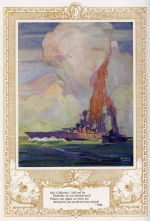 | 308k | Water color of the California (BB-44) and a destroyer underway by the famous California artist Maurice Logan. | Courtesy of Darryl L. Baker. | ||||||||||||||||||||||||||||||||||||||||||||||||||||||||||||||||||||||||||||||||||||||||||||||||||||||||||||||||||||||||||||||||||||||||||||||||||||||||||||||||||||||||||||||||||||||||||||||||||||||||||||||||||||||||||||||||||||||||||||||||||||||||||||||||||||||||||||||||||||||||||||||||||||||||||||||||||||||||||||||||||||||||||||||||||||||||||||||||||||||||||||||||||||||||||||||||||||||||||||||||||||||||||||||||||||||||||||||||||||||||||||||||||||||||||||||||||||||||||||||||||||||||||||||||||||||||||||||||||||||||||||||||||||||||||||||||||||||||||||||||||||||||||||||||||||||||||
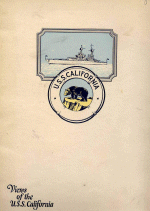 | 3.92k | Front cover from a booklet published for the California's (BB-44) Welfare Fund in 1922 by Schwabacher - Frey Stationery Co. in San Francisco, detailing the early history of the California. All the photos on this 27 page PDF are from this source. | Courtesy of Darryl L. Baker. | ||||||||||||||||||||||||||||||||||||||||||||||||||||||||||||||||||||||||||||||||||||||||||||||||||||||||||||||||||||||||||||||||||||||||||||||||||||||||||||||||||||||||||||||||||||||||||||||||||||||||||||||||||||||||||||||||||||||||||||||||||||||||||||||||||||||||||||||||||||||||||||||||||||||||||||||||||||||||||||||||||||||||||||||||||||||||||||||||||||||||||||||||||||||||||||||||||||||||||||||||||||||||||||||||||||||||||||||||||||||||||||||||||||||||||||||||||||||||||||||||||||||||||||||||||||||||||||||||||||||||||||||||||||||||||||||||||||||||||||||||||||||||||||||||||||||||||
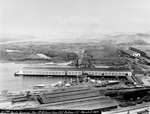 014621 |
1.63k | Pacific Terminal Pier No 18 from Sosa Hill, Balboa, CZ. 8 March 1923. Maryland (BB-46) appears in the lower portion of the photo & California (BB-44) in the upper. |
Record Group 185:Records of the Panama Canal, 1848 - 1999 Series: Photographs of the Construction of the Panama Canal, 1887 - 1940 File Unit: Construction of the Panama Canal - Volume 4 National Archives Identifier: 100995186 Local Identifier: 185-G-304 Photo courtesy of catalog.archives.gov | ||||||||||||||||||||||||||||||||||||||||||||||||||||||||||||||||||||||||||||||||||||||||||||||||||||||||||||||||||||||||||||||||||||||||||||||||||||||||||||||||||||||||||||||||||||||||||||||||||||||||||||||||||||||||||||||||||||||||||||||||||||||||||||||||||||||||||||||||||||||||||||||||||||||||||||||||||||||||||||||||||||||||||||||||||||||||||||||||||||||||||||||||||||||||||||||||||||||||||||||||||||||||||||||||||||||||||||||||||||||||||||||||||||||||||||||||||||||||||||||||||||||||||||||||||||||||||||||||||||||||||||||||||||||||||||||||||||||||||||||||||||||||||||||||||||||||||
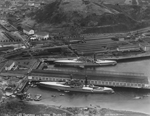 | 1.93k | The California (BB-44) & West Virginia (BB-48), Balboa, C.Z., 10 March 1923. | Panama Canal Zone - Balboa Record Group 18:Records of the Army Air Forces, ca. 1902 - 1964 Series: "Airscapes" of American and Foreign Areas, 1917 - 1964 National Archives Identifier: 68147540 Photo courtesy of catalog.archives.gov | ||||||||||||||||||||||||||||||||||||||||||||||||||||||||||||||||||||||||||||||||||||||||||||||||||||||||||||||||||||||||||||||||||||||||||||||||||||||||||||||||||||||||||||||||||||||||||||||||||||||||||||||||||||||||||||||||||||||||||||||||||||||||||||||||||||||||||||||||||||||||||||||||||||||||||||||||||||||||||||||||||||||||||||||||||||||||||||||||||||||||||||||||||||||||||||||||||||||||||||||||||||||||||||||||||||||||||||||||||||||||||||||||||||||||||||||||||||||||||||||||||||||||||||||||||||||||||||||||||||||||||||||||||||||||||||||||||||||||||||||||||||||||||||||||||||||||||
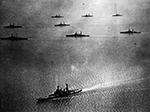 | 1.60k | U.S. Navy Battle fleet steaming into Panama Bay to join scouting fleet for combined fleet maneuvers, probably 1923. The irony of this photo is that the ship with the least certain ID is the one closest to the camera! The probability is that she is the California (BB-44) based on the fact that the 3 Colorado class (BB-45 / 48) operated for such a short time without catapults and the ship in the photo has a bare quarterdeck). The photo is not clear enough to show twin or triple turrets. However, the ships in the background show enough unique characteristics to give more certainty about an ID. The nearest column are, left to right, Mississippi (BB-41) (uneven lookout station heights on the cagemasts), Tennessee (BB-43), (unique searchlight towers on after stack), and Idaho (BB-42) (lower bridge than New Mexico (BB-40)). The two ships in the second column are New York (BB-34) (bridge does not extend out far enough to be Texas (BB-35)) and Nevada (BB-36) (no enclosed lookout stations on the cagemasts and she has a catapult on her quarterdeck). The farthest column has (again left to right) Arizona (BB-39) (lower bridge), Pennsylvania (BB-38) (higher bridge) and New Mexico (again, the higher bridge). It is interesting that the only apparent catapult is the one on the Nevada. This would place the photo in the 1922-24 time frame. | Ernest La Rue Collection, Gift of the U.S. Army. Courtesy of the Library of Congress. USN photo # Lot-11952-VI-37, courtesy of the National Museum of the U.S. Navy, courtesy of flickr.com. Photo & text i.d. courtesy of Richard M. Jensen. | ||||||||||||||||||||||||||||||||||||||||||||||||||||||||||||||||||||||||||||||||||||||||||||||||||||||||||||||||||||||||||||||||||||||||||||||||||||||||||||||||||||||||||||||||||||||||||||||||||||||||||||||||||||||||||||||||||||||||||||||||||||||||||||||||||||||||||||||||||||||||||||||||||||||||||||||||||||||||||||||||||||||||||||||||||||||||||||||||||||||||||||||||||||||||||||||||||||||||||||||||||||||||||||||||||||||||||||||||||||||||||||||||||||||||||||||||||||||||||||||||||||||||||||||||||||||||||||||||||||||||||||||||||||||||||||||||||||||||||||||||||||||||||||||||||||||||||
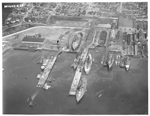 013416 | 609k | Two photographs of Puget Sound, Navy Yard, Bremerton, Washington, 21 August 1923. The nearest BB bow on, is the Texas (BB-35), identified by her distinctive pilot house. New York (BB-34) is next, with all the awnings, and the Tennessee class ship in the drydock is most likely California (BB-44). At the time of the photos, Tennessee (BB-43) had a unique searchlight structure around the second stack which is not apparent here, but neither of the shots is clear enough to be absolutely certain. The 4 stacked partially canvassed ship at the end of the pier on the right is the Charleston (Cruiser No. 22). |
Photo i.d. courtesy of Chuck Haberlein & Richard M. Jensen. National Archives Identifier: 148728434 & 148728436 Local Identifier: 71-CA-428A-2 & 71-CA-428A-3 Photos courtesy of catalog.archives.gov & catalog.archives.gov | ||||||||||||||||||||||||||||||||||||||||||||||||||||||||||||||||||||||||||||||||||||||||||||||||||||||||||||||||||||||||||||||||||||||||||||||||||||||||||||||||||||||||||||||||||||||||||||||||||||||||||||||||||||||||||||||||||||||||||||||||||||||||||||||||||||||||||||||||||||||||||||||||||||||||||||||||||||||||||||||||||||||||||||||||||||||||||||||||||||||||||||||||||||||||||||||||||||||||||||||||||||||||||||||||||||||||||||||||||||||||||||||||||||||||||||||||||||||||||||||||||||||||||||||||||||||||||||||||||||||||||||||||||||||||||||||||||||||||||||||||||||||||||||||||||||||||||
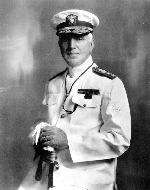 | 44k | Captain Harley Hannibal Christy was in command of the Battleship California (BB-44) having replaced Captain Lucius A. Bostwick on 23 May 1923. In December of 1924 he was promoted to Rear Admiral. Upon returning from the Pacific coast on 26 July 1924 he reported to his new assignment at the Naval War College. | Naval History and Heritage Command photo # NH 51638. | ||||||||||||||||||||||||||||||||||||||||||||||||||||||||||||||||||||||||||||||||||||||||||||||||||||||||||||||||||||||||||||||||||||||||||||||||||||||||||||||||||||||||||||||||||||||||||||||||||||||||||||||||||||||||||||||||||||||||||||||||||||||||||||||||||||||||||||||||||||||||||||||||||||||||||||||||||||||||||||||||||||||||||||||||||||||||||||||||||||||||||||||||||||||||||||||||||||||||||||||||||||||||||||||||||||||||||||||||||||||||||||||||||||||||||||||||||||||||||||||||||||||||||||||||||||||||||||||||||||||||||||||||||||||||||||||||||||||||||||||||||||||||||||||||||||||||||
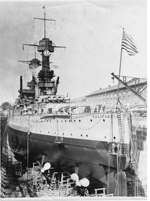 | 769k | Stern view of the California (BB-44) in Dry Dock, early 1920's image. Note the concentration dial, or "Clock". The practice of gunnery at the beginning of the 20th century put a lot of emphasis on shooting first. Radio communications was still in diapers (cumbersome, morse code, slow) and visual signals, light, flaghoist or semaphore, were not much better. When an enemy was detected it also took time to train and elevate the guns to shoot at him. In poor visibility this might give him the first shot. The range clocks, and their companion, the deflection markers, were developed to shorten the time needed to get off the first salvo. Concentration of fire was also a major consideration, and usually all ships of a division would fire on the same target. Fire control was based on mechanical analog devices that incorporated input from the optical range finders located at several places on the ship. In USN ships this included the top of the cage mast. Long range visibility under battle conditions was often poor. The heavy black smoke from burning coal just made it worse. But individual ships could be expected to have a reasonably clear view of the next ship ahead in the division line. The flagship was almost always in the lead, and could direct concentration of fire by passing range and deflection data to the other ships. This process was made much faster by simply training the flagships own guns in the direction of the enemy and displaying the ships own average rangefinder results on a circular display. Trailing ships often did not have as good a view f the enemy as the leader, but could observe where the leaders guns were aimed (and read numbers from the range clock) in order to set initial values for aiming their own guns. That is enough of the background theory. There was no CIC as we know it today, but there was a central fire control plot on each ship. This plot included a MECHANICAL device for determining and transmitting refined settings for azimuth and elevation of the guns. Initial inputs were often set manually. Communications between the plot and the gun turrets (and the range clocks) included up to 4 separate and parallel methods. First, there was a mechanical connection, usually a bicycle chain and sprocket drive to ensure equivalent movement. Second, voice tubes connected the plot with rangefinder positions and guns. Third, when they became available, there were internal communications telephones matching the above circuits. Finally, if other means failed, you could write a note and send it by messenger. There is an excellent series of articles on battleship gunnery fire control in this era in WARSHIP INTERNATIONAL. vol 38 numbers 1,2,3 (2001) and also vol 41. It is devoted to the plotting instruments, not range clocks. As a final note, I'm sure you already noticed that the range "clocks" are numbered from 1 to 10, not 1 to 12. The figures were usually given in thousands of yards. | USN photo courtesy of Jim Millholland via Alan Cole. Text courtesy of Aryeh Wetherhorn, (USN & Israeli Navy, Retired). | ||||||||||||||||||||||||||||||||||||||||||||||||||||||||||||||||||||||||||||||||||||||||||||||||||||||||||||||||||||||||||||||||||||||||||||||||||||||||||||||||||||||||||||||||||||||||||||||||||||||||||||||||||||||||||||||||||||||||||||||||||||||||||||||||||||||||||||||||||||||||||||||||||||||||||||||||||||||||||||||||||||||||||||||||||||||||||||||||||||||||||||||||||||||||||||||||||||||||||||||||||||||||||||||||||||||||||||||||||||||||||||||||||||||||||||||||||||||||||||||||||||||||||||||||||||||||||||||||||||||||||||||||||||||||||||||||||||||||||||||||||||||||||||||||||||||||||
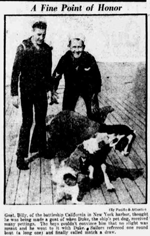 | NR | A Fine Point of Honor Goat, Billy, of the battleship California (BB-44) in New York harbor, thought he was being made a goat of when Duke, the ship's pet dog, received many pettings. The boys couldn't convince bim that no slight was meant and he went to it with Duke. Sailors refereed one round bout (a long one) and finally called match a draw. | Image and text provided by Connecticut State Library, Hartford, CT. Photo from New Britain Herald. [volume] (New Britain, Conn.) 1890-1976, 07 March 1924, Second Section, Image 23, via chroniclingamerica.loc.gov. |
||||||||||||||||||||||||||||||||||||||||||||||||||||||||||||||||||||||||||||||||||||||||||||||||||||||||||||||||||||||||||||||||||||||||||||||||||||||||||||||||||||||||||||||||||||||||||||||||||||||||||||||||||||||||||||||||||||||||||||||||||||||||||||||||||||||||||||||||||||||||||||||||||||||||||||||||||||||||||||||||||||||||||||||||||||||||||||||||||||||||||||||||||||||||||||||||||||||||||||||||||||||||||||||||||||||||||||||||||||||||||||||||||||||||||||||||||||||||||||||||||||||||||||||||||||||||||||||||||||||||||||||||||||||||||||||||||||||||||||||||||||||||||||||||||||||||||
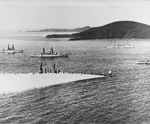 014508 |
1.69k | A naval scouting plane lays a protective smokescreen during maneuvers in the Caribbean Sea, 21 March 1924. Left to right: New York (BB-34/35) class battleship; Pennsylvania (BB-38/39) class battleship; Tennessee (BB-43/44) class battleship (behind smoke); Omaha (CL-4/13) class cruiser; Tennessee or Colorado (BB-45/48) class battleship (stern only visible). | Photo NH-69203 courtesy of history.navy.mil | ||||||||||||||||||||||||||||||||||||||||||||||||||||||||||||||||||||||||||||||||||||||||||||||||||||||||||||||||||||||||||||||||||||||||||||||||||||||||||||||||||||||||||||||||||||||||||||||||||||||||||||||||||||||||||||||||||||||||||||||||||||||||||||||||||||||||||||||||||||||||||||||||||||||||||||||||||||||||||||||||||||||||||||||||||||||||||||||||||||||||||||||||||||||||||||||||||||||||||||||||||||||||||||||||||||||||||||||||||||||||||||||||||||||||||||||||||||||||||||||||||||||||||||||||||||||||||||||||||||||||||||||||||||||||||||||||||||||||||||||||||||||||||||||||||||||||||
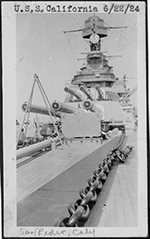 | 591k | California (BB-44) anchor chain and all at San Pedro on 22 June 1924. | Photo courtesy of Brad Purinton. | ||||||||||||||||||||||||||||||||||||||||||||||||||||||||||||||||||||||||||||||||||||||||||||||||||||||||||||||||||||||||||||||||||||||||||||||||||||||||||||||||||||||||||||||||||||||||||||||||||||||||||||||||||||||||||||||||||||||||||||||||||||||||||||||||||||||||||||||||||||||||||||||||||||||||||||||||||||||||||||||||||||||||||||||||||||||||||||||||||||||||||||||||||||||||||||||||||||||||||||||||||||||||||||||||||||||||||||||||||||||||||||||||||||||||||||||||||||||||||||||||||||||||||||||||||||||||||||||||||||||||||||||||||||||||||||||||||||||||||||||||||||||||||||||||||||||||||
 01445o |
776k | (RPPC) California (BB-44) officers, 1924. According to the San Pedro Pilot News, the incident might be this 21 October 1924. |
Insert photo courtesy of Darryl L. Baker. USN photo courtesy of David Wright. |
||||||||||||||||||||||||||||||||||||||||||||||||||||||||||||||||||||||||||||||||||||||||||||||||||||||||||||||||||||||||||||||||||||||||||||||||||||||||||||||||||||||||||||||||||||||||||||||||||||||||||||||||||||||||||||||||||||||||||||||||||||||||||||||||||||||||||||||||||||||||||||||||||||||||||||||||||||||||||||||||||||||||||||||||||||||||||||||||||||||||||||||||||||||||||||||||||||||||||||||||||||||||||||||||||||||||||||||||||||||||||||||||||||||||||||||||||||||||||||||||||||||||||||||||||||||||||||||||||||||||||||||||||||||||||||||||||||||||||||||||||||||||||||||||||||||||||
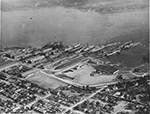 | 918k | View of the U.S. Puget Sound Navy Yard, Bremerton, Washington, in September 1924. Two battleships are visible, a Colorado-class (BB-45 / 48), left, and Tennessee class (BB-43 / 44). | National Archives Identifier: 6036982 Photo courtesy of catalog.archives.gov |
||||||||||||||||||||||||||||||||||||||||||||||||||||||||||||||||||||||||||||||||||||||||||||||||||||||||||||||||||||||||||||||||||||||||||||||||||||||||||||||||||||||||||||||||||||||||||||||||||||||||||||||||||||||||||||||||||||||||||||||||||||||||||||||||||||||||||||||||||||||||||||||||||||||||||||||||||||||||||||||||||||||||||||||||||||||||||||||||||||||||||||||||||||||||||||||||||||||||||||||||||||||||||||||||||||||||||||||||||||||||||||||||||||||||||||||||||||||||||||||||||||||||||||||||||||||||||||||||||||||||||||||||||||||||||||||||||||||||||||||||||||||||||||||||||||||||||
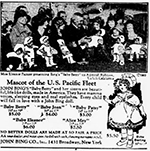 | 37k | Mascot of the U. S. Pacific Fleet. Mrs Eleanor Painter presenting Bing's "Baby Betty" to Admiral Robinson aboard California (BB-44). | Image and text provided by Library of Congress, Washington, DC. Photo from Evening Star. (Washington, D.C.) 1854-1972, 19 September 1924, Image 43, courtesy of chroniclingamerica.loc.gov. | ||||||||||||||||||||||||||||||||||||||||||||||||||||||||||||||||||||||||||||||||||||||||||||||||||||||||||||||||||||||||||||||||||||||||||||||||||||||||||||||||||||||||||||||||||||||||||||||||||||||||||||||||||||||||||||||||||||||||||||||||||||||||||||||||||||||||||||||||||||||||||||||||||||||||||||||||||||||||||||||||||||||||||||||||||||||||||||||||||||||||||||||||||||||||||||||||||||||||||||||||||||||||||||||||||||||||||||||||||||||||||||||||||||||||||||||||||||||||||||||||||||||||||||||||||||||||||||||||||||||||||||||||||||||||||||||||||||||||||||||||||||||||||||||||||||||||||
 | 167k | Flags flying from California's (BB-44) masts fore and aft on "Decoration Day", 1924. | USN photo courtesy of Robert M. Cieri. | ||||||||||||||||||||||||||||||||||||||||||||||||||||||||||||||||||||||||||||||||||||||||||||||||||||||||||||||||||||||||||||||||||||||||||||||||||||||||||||||||||||||||||||||||||||||||||||||||||||||||||||||||||||||||||||||||||||||||||||||||||||||||||||||||||||||||||||||||||||||||||||||||||||||||||||||||||||||||||||||||||||||||||||||||||||||||||||||||||||||||||||||||||||||||||||||||||||||||||||||||||||||||||||||||||||||||||||||||||||||||||||||||||||||||||||||||||||||||||||||||||||||||||||||||||||||||||||||||||||||||||||||||||||||||||||||||||||||||||||||||||||||||||||||||||||||||||
 |
1.90k | Port Angeles Washington: The lack of turret bearing markings places the photo post 1924 while the already noted presence of the Kidder (DD-319) places it before 1930. The front row of battleships are, left to right, Colorado (BB-45) based on the turret two rangefinder, West Virginia (BB-48) based on the lack of a turret two rangefinder, and probably California (BB-44) based on the bridge configuration. The back row, left to right, are New Mexico (BB-40) based on the higher bridge configuration, Mississippi (BB-41), based on the lower bridge and the fact that the searchlights and lookout station on the main mast are lower than those on the foremast (BB-42 had them at the same height), and Maryland (BB-46) based on the configuration of the turret two rangefinder. | Photo courtesy of Curtis Nicolaisen. Photo & text i.d. courtesy of Richard Jensen. | ||||||||||||||||||||||||||||||||||||||||||||||||||||||||||||||||||||||||||||||||||||||||||||||||||||||||||||||||||||||||||||||||||||||||||||||||||||||||||||||||||||||||||||||||||||||||||||||||||||||||||||||||||||||||||||||||||||||||||||||||||||||||||||||||||||||||||||||||||||||||||||||||||||||||||||||||||||||||||||||||||||||||||||||||||||||||||||||||||||||||||||||||||||||||||||||||||||||||||||||||||||||||||||||||||||||||||||||||||||||||||||||||||||||||||||||||||||||||||||||||||||||||||||||||||||||||||||||||||||||||||||||||||||||||||||||||||||||||||||||||||||||||||||||||||||||||||
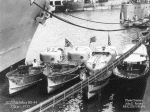 | 39k | Admiral's gigs tied up alongside the California (BB-44), circa 1925. | Courtesy of John D. Fielden, MM2, USN (ssb) Northridge, CA. | ||||||||||||||||||||||||||||||||||||||||||||||||||||||||||||||||||||||||||||||||||||||||||||||||||||||||||||||||||||||||||||||||||||||||||||||||||||||||||||||||||||||||||||||||||||||||||||||||||||||||||||||||||||||||||||||||||||||||||||||||||||||||||||||||||||||||||||||||||||||||||||||||||||||||||||||||||||||||||||||||||||||||||||||||||||||||||||||||||||||||||||||||||||||||||||||||||||||||||||||||||||||||||||||||||||||||||||||||||||||||||||||||||||||||||||||||||||||||||||||||||||||||||||||||||||||||||||||||||||||||||||||||||||||||||||||||||||||||||||||||||||||||||||||||||||||||||
 | NR | Battleships on Way to Try to "Capture" Hawaii. The California (BB-44), at left, and other vessels of the battleship fleet on their way from the California coast to attempt to "capture" Hawaii, after which they will visit Australia and New Zealand. | Image and text provided by Arizona State Library, Archives and Public Records; Phoenix, AZ. Photo from the The Winslow Mail. (Winslow, Ariz.) 1893-1926, 01 May 1925, Image 1, courtesy of chroniclingamerica.loc.gov. | ||||||||||||||||||||||||||||||||||||||||||||||||||||||||||||||||||||||||||||||||||||||||||||||||||||||||||||||||||||||||||||||||||||||||||||||||||||||||||||||||||||||||||||||||||||||||||||||||||||||||||||||||||||||||||||||||||||||||||||||||||||||||||||||||||||||||||||||||||||||||||||||||||||||||||||||||||||||||||||||||||||||||||||||||||||||||||||||||||||||||||||||||||||||||||||||||||||||||||||||||||||||||||||||||||||||||||||||||||||||||||||||||||||||||||||||||||||||||||||||||||||||||||||||||||||||||||||||||||||||||||||||||||||||||||||||||||||||||||||||||||||||||||||||||||||||||||
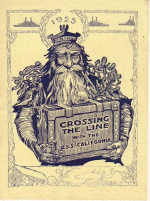 | 11meg | In the summer of 1925, California (BB-44) led the Battle Fleet and a division of cruisers from the Scouting Fleet on a very successful good-will cruise to Australia and New Zealand. This is a PDF of the voyage. It includes 41 pages & is entitled "Crossing the Line with the U.S.S. California". | USN photo courtesy of Robert M. Cieri. Text courtesy of DANFS. | ||||||||||||||||||||||||||||||||||||||||||||||||||||||||||||||||||||||||||||||||||||||||||||||||||||||||||||||||||||||||||||||||||||||||||||||||||||||||||||||||||||||||||||||||||||||||||||||||||||||||||||||||||||||||||||||||||||||||||||||||||||||||||||||||||||||||||||||||||||||||||||||||||||||||||||||||||||||||||||||||||||||||||||||||||||||||||||||||||||||||||||||||||||||||||||||||||||||||||||||||||||||||||||||||||||||||||||||||||||||||||||||||||||||||||||||||||||||||||||||||||||||||||||||||||||||||||||||||||||||||||||||||||||||||||||||||||||||||||||||||||||||||||||||||||||||||||
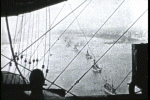 | 56k | View of the U.S. Battlefleet from above, possibly from the airship Los Angeles (ZR-3). | Photo courtesy of periscopefilm.com. | ||||||||||||||||||||||||||||||||||||||||||||||||||||||||||||||||||||||||||||||||||||||||||||||||||||||||||||||||||||||||||||||||||||||||||||||||||||||||||||||||||||||||||||||||||||||||||||||||||||||||||||||||||||||||||||||||||||||||||||||||||||||||||||||||||||||||||||||||||||||||||||||||||||||||||||||||||||||||||||||||||||||||||||||||||||||||||||||||||||||||||||||||||||||||||||||||||||||||||||||||||||||||||||||||||||||||||||||||||||||||||||||||||||||||||||||||||||||||||||||||||||||||||||||||||||||||||||||||||||||||||||||||||||||||||||||||||||||||||||||||||||||||||||||||||||||||||
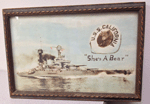 | 433k | California (BB-44) & cub. | Photo courtesy of Karin Wittenberg. | ||||||||||||||||||||||||||||||||||||||||||||||||||||||||||||||||||||||||||||||||||||||||||||||||||||||||||||||||||||||||||||||||||||||||||||||||||||||||||||||||||||||||||||||||||||||||||||||||||||||||||||||||||||||||||||||||||||||||||||||||||||||||||||||||||||||||||||||||||||||||||||||||||||||||||||||||||||||||||||||||||||||||||||||||||||||||||||||||||||||||||||||||||||||||||||||||||||||||||||||||||||||||||||||||||||||||||||||||||||||||||||||||||||||||||||||||||||||||||||||||||||||||||||||||||||||||||||||||||||||||||||||||||||||||||||||||||||||||||||||||||||||||||||||||||||||||||
 | 89k | In the summer of 1925, the California (BB-44) led the Battle Fleet and a division of cruisers from the Scouting Fleet on a very successful good-will cruise to Australia and New Zealand. New Mexico (BB-40) is clearly the ship at the head of the column. Photograph probably taken from the California. | Partial text courtesy of DANFS. Photo i.d. courtesy of Richard Jensen. USN photo courtesy of Robert M. Cieri. | ||||||||||||||||||||||||||||||||||||||||||||||||||||||||||||||||||||||||||||||||||||||||||||||||||||||||||||||||||||||||||||||||||||||||||||||||||||||||||||||||||||||||||||||||||||||||||||||||||||||||||||||||||||||||||||||||||||||||||||||||||||||||||||||||||||||||||||||||||||||||||||||||||||||||||||||||||||||||||||||||||||||||||||||||||||||||||||||||||||||||||||||||||||||||||||||||||||||||||||||||||||||||||||||||||||||||||||||||||||||||||||||||||||||||||||||||||||||||||||||||||||||||||||||||||||||||||||||||||||||||||||||||||||||||||||||||||||||||||||||||||||||||||||||||||||||||||
 |
37k | Night time stern view of the Tennessee (BB-43), Mississippi (BB-41), California (BB-44) and or Idaho (BB-42) in Port Jackson, Sydney, Australia, 1925. | This photo is part of the Australian National Maritime Museum's Samuel J. Hood Studio Collection in Flicker. Sam Hood (1870-1956) was a Sydney photographer with a passion for ships. His 72-year career spanned the romantic age of sail and two world wars. The photos in the collection were taken mainly in Sydney and Newcastle during the first half of the 20th century and submitted via Pieter Bakkels & Bill Gonyo. | ||||||||||||||||||||||||||||||||||||||||||||||||||||||||||||||||||||||||||||||||||||||||||||||||||||||||||||||||||||||||||||||||||||||||||||||||||||||||||||||||||||||||||||||||||||||||||||||||||||||||||||||||||||||||||||||||||||||||||||||||||||||||||||||||||||||||||||||||||||||||||||||||||||||||||||||||||||||||||||||||||||||||||||||||||||||||||||||||||||||||||||||||||||||||||||||||||||||||||||||||||||||||||||||||||||||||||||||||||||||||||||||||||||||||||||||||||||||||||||||||||||||||||||||||||||||||||||||||||||||||||||||||||||||||||||||||||||||||||||||||||||||||||||||||||||||||||
 014295 |
548k | Panorama of Sydney Harbour during the United States Navy's goodwill tour. On 23 July 1925, Sydney hosted eight of the US Navy Battle Fleet's largest ships, including California (BB-44), Colorado (BB-45),Tennessee (BB-43), Maryland (BB-46), West Virginia (BB-48), New Mexico (BB-40), Mississippi (BB-41) and Idaho (BB-42). The fleet departed for New Zealand on 6 August. This photograph was probably taken at Georges Head Battery, in Georges Heights in the Sydney suburb of Mosman. This photo is part of the Australian National Maritime Museum’s Samuel J. Hood Studio collection. Sam Hood (1872-1953) was a Sydney photographer with a passion for ships. His 60-year career spanned the romantic age of sail and two world wars. The photos in the collection were taken mainly in Sydney and Newcastle during the first half of the 20th century. The ANMM undertakes research and accepts public comments that enhance the information we hold about images in our collection. This record has been updated accordingly. |
Image and text provided by flickr.com | ||||||||||||||||||||||||||||||||||||||||||||||||||||||||||||||||||||||||||||||||||||||||||||||||||||||||||||||||||||||||||||||||||||||||||||||||||||||||||||||||||||||||||||||||||||||||||||||||||||||||||||||||||||||||||||||||||||||||||||||||||||||||||||||||||||||||||||||||||||||||||||||||||||||||||||||||||||||||||||||||||||||||||||||||||||||||||||||||||||||||||||||||||||||||||||||||||||||||||||||||||||||||||||||||||||||||||||||||||||||||||||||||||||||||||||||||||||||||||||||||||||||||||||||||||||||||||||||||||||||||||||||||||||||||||||||||||||||||||||||||||||||||||||||||||||||||||
 | 67k | Starboard view of the California (BB-44), 27 July 1925 in Sydney Harbor, Austraila. | Courtesy of George Weir. |  | 146k | Port side view transiting the Panama Canal, circa 1925. | Courtesy of Manuel D. Tafoya Sr. | ||||||||||||||||||||||||||||||||||||||||||||||||||||||||||||||||||||||||||||||||||||||||||||||||||||||||||||||||||||||||||||||||||||||||||||||||||||||||||||||||||||||||||||||||||||||||||||||||||||||||||||||||||||||||||||||||||||||||||||||||||||||||||||||||||||||||||||||||||||||||||||||||||||||||||||||||||||||||||||||||||||||||||||||||||||||||||||||||||||||||||||||||||||||||||||||||||||||||||||||||||||||||||||||||||||||||||||||||||||||||||||||||||||||||||||||||||||||||||||||||||||||||||||||||||||||||||||||||||||||||||||||||||||||||||||||||||||||||||||||||||||||||||||||||||||||
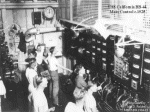 | 43k | Main control room of the California (BB-44), circa 1925. BTW, one of the men has been identified as Ernest C Dodge. He was a WW1 Army artilleryman. They were conducting an efficiency exercise. He was controlling the current to the propulsion motors. They were in the process of maintaining as much speed possible with the least amount of energy to do so. He is the tall skinny man to the left of the throttle-man with his arm reaching down at about a 45 degree angle. He appears to be looking at what appears to be a clock and the horizontal instruments. For a description of the room (see also John D. Goebel's explanation below) John D. Fielden writes: "From my personal experience working as a Machinist Mate in an Engine Room on an auxiliary ship San Jose (AFS-7), I was qualified Machinist Mate of the Watch (MMOW) the engine room supervisor, junior only to the Engineering Officer of the Watch (EEOW) this is what I see: Diagonally across the bottom are the Engine Order Telegraphs connected to the Conn on the bridge. The sailor with his hand on the wheel is the Throttle man. He has his hand on the AHEAD turbine throttle to the High Pressure Turbine. The wheel to the right is the ASTERN throttle to the Low Pressure Turbine. The main electric travels through the HP Turbine thru a crossover pipe to the ahead element in the LP turbine. It is probable that this is one of FOUR control rooms, for four "main engines". I served on three ships, but I am not familiar with the BB configurations. The gauges in the very center of the picture are the Main Engine Gauge Board where all pressure and remote thermometers readings are displayed. I speculate that the older looking gentleman with the bald spot is the EEOW (usually a CPO or higher in rank, rarely higher than a Lt.), the senior watch position in main control. I do not know if the fire room and engine room were separate on this class of ship. I do know that in most conventional steam plants had separate rooms, but a good number of ships could have both in one space/compartment. If this class has both in one space, the sailor in the arm extended on a lever could be the Boiler Technician of the Watch (BTOW). The BTOW is in charge of all the Boilers and responsible for the proper operation of those boilers. The BTOW is Junior to the MMOW. I'd also speculate the younger looking sailor with the whitecap on is the Messenger. The messenger was required to roam the space to record other equipment reading from gauges not found on the Mn. Engine Gauge Bd. The "CLOCK" is what is known as a "REPEATER" of the engine order telegraph. The engine order telegraph at the top of the picture indicates STOP, and in respects to the group of pictures I have (although not certain) this would imply the ship is in the "999" (Niner-Niner-Niner) Maneuvering mode or "Prepare for all possible bells from the Conn" which would be indicative that they are in and maneuvering through the Lochs at that exact time. An added indicator of this is the sailor with the sound-powered phones, a station that is required during Maneuvering evolutions, but I'm not sure if they had "Squawk Boxes" or what we called "Bitch Boxes" in this era. The horizontal indicators (white with black stripe) appear to be liquid level indicators, but I have my doubts. The square box that is taller than it is wide appears the RPM Indicator. This displays the revolutions per minute of the shafts turning the propellers. Normally in Main Control there is also an Electrician of the watch responsible for the Electrical Load on the Main Switchboard and Ship Service Turbo-Generators, and to alert the EEOW and MMOW when it becomes unstable. I speculate that this main control space is in the open atmosphere of the engine room. My clue is that all but one are in there t-shirts indicating HEAT from the boilers and Mn. Turbines. In a conventional steam plant standard/operational atmosphere temperatures exceeded 110 degrees Fahrenheit. The ship I was on was documented at 117 degrees. Again, I am only analyzing the picture with my limited experience (3 ships/7 yrs at sea in engineering 1984-1991)". John D. Goebel, who served in a similar position aboard the New Jersey(BB-62), but with more experience, adds: " 1. California was a turbo electric propulsion system. This system was an experimental system that was used during the 1920's.The steam powered the SPTG Ship's Propulsion Turbo Generators, which in turn generated electricity for the propulsion motors. In other words, the propellers were driven by electric motors. This was to provide better control over the engineering plant and eliminated the reduction gears. 2. Having served in the engine-room on the New Jersey, the steam pressure was considered high and that was a 600 psi plant. 1200 psi was brought in during the fifties as a way to improve acceleration. It would be extremely unlikely that it would have steam pressure above 600 psi. Therefore, the controls that are being handled in this picture are electrical not steam." V/RGSCM(SW) Goebel | Courtesy of John D. Fielden, MM2, USN (ssb)Northridge, CA. Photo I.d. courtesy of Francis D. Dodge, USAF, Msgt retired, USN MR2 USS Oakhill, LSD 7, USS Skagit. AKA 105, 1961-1965. | ||||||||||||||||||||||||||||||||||||||||||||||||||||||||||||||||||||||||||||||||||||||||||||||||||||||||||||||||||||||||||||||||||||||||||||||||||||||||||||||||||||||||||||||||||||||||||||||||||||||||||||||||||||||||||||||||||||||||||||||||||||||||||||||||||||||||||||||||||||||||||||||||||||||||||||||||||||||||||||||||||||||||||||||||||||||||||||||||||||||||||||||||||||||||||||||||||||||||||||||||||||||||||||||||||||||||||||||||||||||||||||||||||||||||||||||||||||||||||||||||||||||||||||||||||||||||||||||||||||||||||||||||||||||||||||||||||||||||||||||||||||||||||||||||||||||||||
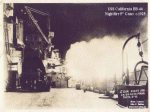 | 31k | California (BB-44) firing her 5" secondary battery at night, circa 1925. | Courtesy of John D. Fielden, MM2, USN (ssb)Northridge, CA | ||||||||||||||||||||||||||||||||||||||||||||||||||||||||||||||||||||||||||||||||||||||||||||||||||||||||||||||||||||||||||||||||||||||||||||||||||||||||||||||||||||||||||||||||||||||||||||||||||||||||||||||||||||||||||||||||||||||||||||||||||||||||||||||||||||||||||||||||||||||||||||||||||||||||||||||||||||||||||||||||||||||||||||||||||||||||||||||||||||||||||||||||||||||||||||||||||||||||||||||||||||||||||||||||||||||||||||||||||||||||||||||||||||||||||||||||||||||||||||||||||||||||||||||||||||||||||||||||||||||||||||||||||||||||||||||||||||||||||||||||||||||||||||||||||||||||||
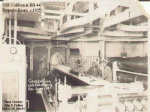 | 34k | Torpedo room of the California (BB-44), circa 1925. | Courtesy of John D. Fielden, MM2, USN (ssb)Northridge, CA | ||||||||||||||||||||||||||||||||||||||||||||||||||||||||||||||||||||||||||||||||||||||||||||||||||||||||||||||||||||||||||||||||||||||||||||||||||||||||||||||||||||||||||||||||||||||||||||||||||||||||||||||||||||||||||||||||||||||||||||||||||||||||||||||||||||||||||||||||||||||||||||||||||||||||||||||||||||||||||||||||||||||||||||||||||||||||||||||||||||||||||||||||||||||||||||||||||||||||||||||||||||||||||||||||||||||||||||||||||||||||||||||||||||||||||||||||||||||||||||||||||||||||||||||||||||||||||||||||||||||||||||||||||||||||||||||||||||||||||||||||||||||||||||||||||||||||||
 |
1.24k | California (BB-44) meets the Panama Canal zone. | USN photo courtesy of Pieter Bakels. | ||||||||||||||||||||||||||||||||||||||||||||||||||||||||||||||||||||||||||||||||||||||||||||||||||||||||||||||||||||||||||||||||||||||||||||||||||||||||||||||||||||||||||||||||||||||||||||||||||||||||||||||||||||||||||||||||||||||||||||||||||||||||||||||||||||||||||||||||||||||||||||||||||||||||||||||||||||||||||||||||||||||||||||||||||||||||||||||||||||||||||||||||||||||||||||||||||||||||||||||||||||||||||||||||||||||||||||||||||||||||||||||||||||||||||||||||||||||||||||||||||||||||||||||||||||||||||||||||||||||||||||||||||||||||||||||||||||||||||||||||||||||||||||||||||||||||||
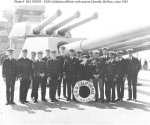 | 61k | The California's (BB-44) officers pose with silent-film actress Dorothy DeVore, on board the ship at San Pedro, California, 1925. Lieutenant Abraham DeSomer is third from right. | Naval History and Heritage Command photo # NH 103839, from the collection of Lieutenant Commander Abraham DeSomer, USN. Donated by Lieutenant Colonel Russell DeSomer, U.S. Air Force (Retired), 1975. | ||||||||||||||||||||||||||||||||||||||||||||||||||||||||||||||||||||||||||||||||||||||||||||||||||||||||||||||||||||||||||||||||||||||||||||||||||||||||||||||||||||||||||||||||||||||||||||||||||||||||||||||||||||||||||||||||||||||||||||||||||||||||||||||||||||||||||||||||||||||||||||||||||||||||||||||||||||||||||||||||||||||||||||||||||||||||||||||||||||||||||||||||||||||||||||||||||||||||||||||||||||||||||||||||||||||||||||||||||||||||||||||||||||||||||||||||||||||||||||||||||||||||||||||||||||||||||||||||||||||||||||||||||||||||||||||||||||||||||||||||||||||||||||||||||||||||||
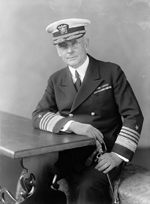 | 54k | ADM. William H. Standley commanded the battleship California (BB-44) from 15 February 1926 to 11 October 1927. Appointed vice admiral, on 20 January 1932 while in command of the Battle Force's cruisers, Standley was placed in command of the Battle Force, U.S. Fleet, with the rank of admiral, on 20 May 1933. Breaking his flag in his former command, California, the admiral remained at sea until 1 July 1933, when President Franklin D. Roosevelt appointed him CNO. | Photo courtesy of the Library of Congress via Bill Gonyo. | ||||||||||||||||||||||||||||||||||||||||||||||||||||||||||||||||||||||||||||||||||||||||||||||||||||||||||||||||||||||||||||||||||||||||||||||||||||||||||||||||||||||||||||||||||||||||||||||||||||||||||||||||||||||||||||||||||||||||||||||||||||||||||||||||||||||||||||||||||||||||||||||||||||||||||||||||||||||||||||||||||||||||||||||||||||||||||||||||||||||||||||||||||||||||||||||||||||||||||||||||||||||||||||||||||||||||||||||||||||||||||||||||||||||||||||||||||||||||||||||||||||||||||||||||||||||||||||||||||||||||||||||||||||||||||||||||||||||||||||||||||||||||||||||||||||||||||
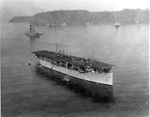 |
2.44k | Langley (CV-1) with Vought VE-7 aircraft on deck, at anchor off Culebra Island, Puerto Rico on 18 March 1926. In the background are 4 four-stack destroyers and a Tennessee class (BB-43 /44) battleship on the left,and two New Mexico (BB-40 /42) class battleships (center and right). At the time, the Tennessee's are hard to tell apart. A few years later, Tennessee (BB-43) had the open bridge added around her pilothouse, and even later, California (BB-44) added the enlarged flag bridge. But in the 1922 (or so) period, they were close in config. The New Mexico's appear to be Mississippi (BB-41) on the left (or in the center) and New Mexico (BB-40) (nearly bow-on) on the right. The original photo was labeled "Harbinger" to show symbolically how the unimposing Langley was the first of a line of ships which eventually drove the battleship from its primary place into the background. |
Photo i.d. & text in italics courtesy of Richard Jensen. USN photo via collections.naval.aviation.museum. | ||||||||||||||||||||||||||||||||||||||||||||||||||||||||||||||||||||||||||||||||||||||||||||||||||||||||||||||||||||||||||||||||||||||||||||||||||||||||||||||||||||||||||||||||||||||||||||||||||||||||||||||||||||||||||||||||||||||||||||||||||||||||||||||||||||||||||||||||||||||||||||||||||||||||||||||||||||||||||||||||||||||||||||||||||||||||||||||||||||||||||||||||||||||||||||||||||||||||||||||||||||||||||||||||||||||||||||||||||||||||||||||||||||||||||||||||||||||||||||||||||||||||||||||||||||||||||||||||||||||||||||||||||||||||||||||||||||||||||||||||||||||||||||||||||||||||||
 | 709k | Different angle of the above photo: Langley (CV-1) & Battleships at anchor off Culebra Island, Puerto Rico 18 March 1926. | USN photo NARA II 80-G-185902 via courtesy of Tracy White @ Researcher @ Large. | ||||||||||||||||||||||||||||||||||||||||||||||||||||||||||||||||||||||||||||||||||||||||||||||||||||||||||||||||||||||||||||||||||||||||||||||||||||||||||||||||||||||||||||||||||||||||||||||||||||||||||||||||||||||||||||||||||||||||||||||||||||||||||||||||||||||||||||||||||||||||||||||||||||||||||||||||||||||||||||||||||||||||||||||||||||||||||||||||||||||||||||||||||||||||||||||||||||||||||||||||||||||||||||||||||||||||||||||||||||||||||||||||||||||||||||||||||||||||||||||||||||||||||||||||||||||||||||||||||||||||||||||||||||||||||||||||||||||||||||||||||||||||||||||||||||||||||
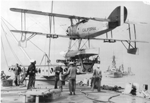 | 684k | A Vought UO-1 on the California (BB-44) off San Diego during Fleet maneuvers on January 1927. Note bombracks under wings. | Photo courtesy of Pieter Bakels. | ||||||||||||||||||||||||||||||||||||||||||||||||||||||||||||||||||||||||||||||||||||||||||||||||||||||||||||||||||||||||||||||||||||||||||||||||||||||||||||||||||||||||||||||||||||||||||||||||||||||||||||||||||||||||||||||||||||||||||||||||||||||||||||||||||||||||||||||||||||||||||||||||||||||||||||||||||||||||||||||||||||||||||||||||||||||||||||||||||||||||||||||||||||||||||||||||||||||||||||||||||||||||||||||||||||||||||||||||||||||||||||||||||||||||||||||||||||||||||||||||||||||||||||||||||||||||||||||||||||||||||||||||||||||||||||||||||||||||||||||||||||||||||||||||||||||||||
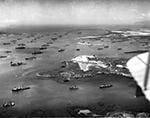 |
2.60k | Ships of the U.S. Fleet pictured at anchor at Guantanamo Bay, Cuba, during winter exercises in 1927. The "center" row has Mississippi (BB-41) then Langley (CV-1) , Oklahoma (BB-37), Pennsylvania (BB-38) and Arizona (BB-39) in that order. The next row to the left has Idaho (BB-42) then New Mexico (BB-40), followed by 3 of the Tennessee/Colorado class (hard to pick out distinguishing features in this photo), with Nevada (BB-36) as tail-end-Charlie. Further to the left are another Tennessee/Colorado class BB and a Memphis (formerly Tennessee) class armored cruiser. Two unidentified Omaha class cruisers are in the foreground. There are at least 17 destroyers, identifiable (bottom, right) is Mahan (DD-102), converted to a minelayer and redesignated DM-7, but still wearing her old DD hull number (102) and two submarine tenders in the foreground with about 10 smaller and two large submarines. The peninsula in the right foreground is South Toro Cay, where the drydock is still visible that was begun in 1904, but cancelled two years later. |
Photo i.d. courtesy of Richard Jensen & wikipedia.org. Photo courtesy of wikipedia.org via Branden Deschaine & Fabio Pena. | ||||||||||||||||||||||||||||||||||||||||||||||||||||||||||||||||||||||||||||||||||||||||||||||||||||||||||||||||||||||||||||||||||||||||||||||||||||||||||||||||||||||||||||||||||||||||||||||||||||||||||||||||||||||||||||||||||||||||||||||||||||||||||||||||||||||||||||||||||||||||||||||||||||||||||||||||||||||||||||||||||||||||||||||||||||||||||||||||||||||||||||||||||||||||||||||||||||||||||||||||||||||||||||||||||||||||||||||||||||||||||||||||||||||||||||||||||||||||||||||||||||||||||||||||||||||||||||||||||||||||||||||||||||||||||||||||||||||||||||||||||||||||||||||||||||||||||
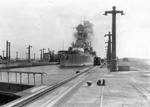 | 694k | The battleship California (BB-44) in the Gatun Locks during her passage through the Panama Canal on 3/8/1927. | Photo courtesy of the National Naval Aviation Museum via Bill Gonyo. | ||||||||||||||||||||||||||||||||||||||||||||||||||||||||||||||||||||||||||||||||||||||||||||||||||||||||||||||||||||||||||||||||||||||||||||||||||||||||||||||||||||||||||||||||||||||||||||||||||||||||||||||||||||||||||||||||||||||||||||||||||||||||||||||||||||||||||||||||||||||||||||||||||||||||||||||||||||||||||||||||||||||||||||||||||||||||||||||||||||||||||||||||||||||||||||||||||||||||||||||||||||||||||||||||||||||||||||||||||||||||||||||||||||||||||||||||||||||||||||||||||||||||||||||||||||||||||||||||||||||||||||||||||||||||||||||||||||||||||||||||||||||||||||||||||||||||||
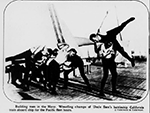 | NR | Building men in the Navy. Wrestling champs of Uncle Sam's battleship California (BB-44) train aboard ship for the Pacific fleet bouts. | Photo by Underwood & Underwood ©. Image and text provided by Library of Congress, Washington, DC. via Evening Star. [volume] (Washington, D.C.) 1854-1972, 13 March 1927, Image 109, courtesy of chroniclingamerica.loc.gov. |
||||||||||||||||||||||||||||||||||||||||||||||||||||||||||||||||||||||||||||||||||||||||||||||||||||||||||||||||||||||||||||||||||||||||||||||||||||||||||||||||||||||||||||||||||||||||||||||||||||||||||||||||||||||||||||||||||||||||||||||||||||||||||||||||||||||||||||||||||||||||||||||||||||||||||||||||||||||||||||||||||||||||||||||||||||||||||||||||||||||||||||||||||||||||||||||||||||||||||||||||||||||||||||||||||||||||||||||||||||||||||||||||||||||||||||||||||||||||||||||||||||||||||||||||||||||||||||||||||||||||||||||||||||||||||||||||||||||||||||||||||||||||||||||||||||||||||
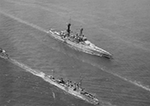 | 782k | An aerial view of the battleship California (BB-44) during a presidential naval review in Hampton Roads, Virginia, 4 June 1927. The destroyer Sloat (DD-316) is at the bottom, and the bow of the destroyer Shirk (DD-318) is visible on the far left. | Photo courtesy of U.S. National Archives and Records Administration, ARC Identifier (National Archives Identifier) 512913, Box 19-LC-19, Folder C, College Park, Maryland, courtesy of Robert Hurst. | ||||||||||||||||||||||||||||||||||||||||||||||||||||||||||||||||||||||||||||||||||||||||||||||||||||||||||||||||||||||||||||||||||||||||||||||||||||||||||||||||||||||||||||||||||||||||||||||||||||||||||||||||||||||||||||||||||||||||||||||||||||||||||||||||||||||||||||||||||||||||||||||||||||||||||||||||||||||||||||||||||||||||||||||||||||||||||||||||||||||||||||||||||||||||||||||||||||||||||||||||||||||||||||||||||||||||||||||||||||||||||||||||||||||||||||||||||||||||||||||||||||||||||||||||||||||||||||||||||||||||||||||||||||||||||||||||||||||||||||||||||||||||||||||||||||||||||
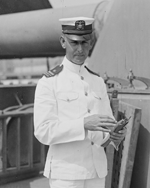 | 248k | Captain Claude Charles Bloch commanded the battleship California (BB-44) from from 1927 to 1929. | Photo courtesy of the Library of Congress via Bill Gonyo. | ||||||||||||||||||||||||||||||||||||||||||||||||||||||||||||||||||||||||||||||||||||||||||||||||||||||||||||||||||||||||||||||||||||||||||||||||||||||||||||||||||||||||||||||||||||||||||||||||||||||||||||||||||||||||||||||||||||||||||||||||||||||||||||||||||||||||||||||||||||||||||||||||||||||||||||||||||||||||||||||||||||||||||||||||||||||||||||||||||||||||||||||||||||||||||||||||||||||||||||||||||||||||||||||||||||||||||||||||||||||||||||||||||||||||||||||||||||||||||||||||||||||||||||||||||||||||||||||||||||||||||||||||||||||||||||||||||||||||||||||||||||||||||||||||||||||||||
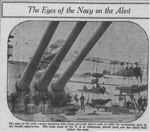 014428e |
NR | The Eyes of the Navy on the Alert The eyes of the navy—great seaplanes like those pictured above—are to take an interesting part in the Pacific maneuvers. The huge guns of the California (BB-44), shown here, are the hands that follow the eyes. |
Image and text provided by Arizona State Library, Archives and Public Records; Phoenix, AZ. Photo from Douglas Daily Dispatch. [volume] (Douglas, Ariz.) 1903-1961, 05 January 1928, Image 1, via chroniclingamerica.loc.gov. | ||||||||||||||||||||||||||||||||||||||||||||||||||||||||||||||||||||||||||||||||||||||||||||||||||||||||||||||||||||||||||||||||||||||||||||||||||||||||||||||||||||||||||||||||||||||||||||||||||||||||||||||||||||||||||||||||||||||||||||||||||||||||||||||||||||||||||||||||||||||||||||||||||||||||||||||||||||||||||||||||||||||||||||||||||||||||||||||||||||||||||||||||||||||||||||||||||||||||||||||||||||||||||||||||||||||||||||||||||||||||||||||||||||||||||||||||||||||||||||||||||||||||||||||||||||||||||||||||||||||||||||||||||||||||||||||||||||||||||||||||||||||||||||||||||||||||||
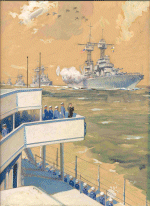 | 122k | Watercolor of a Presidential review during President Hoover's term of office, 1928-32. Crews line the rails of a Colorado class (BB-45 / 48) battleship as the ships pass in line astern of the reviewing stand with the airship Los Angeles (ZR-3) piercing the clouds accompanied by 9 biplanes. | Courtesy of Michael Schwarz. | ||||||||||||||||||||||||||||||||||||||||||||||||||||||||||||||||||||||||||||||||||||||||||||||||||||||||||||||||||||||||||||||||||||||||||||||||||||||||||||||||||||||||||||||||||||||||||||||||||||||||||||||||||||||||||||||||||||||||||||||||||||||||||||||||||||||||||||||||||||||||||||||||||||||||||||||||||||||||||||||||||||||||||||||||||||||||||||||||||||||||||||||||||||||||||||||||||||||||||||||||||||||||||||||||||||||||||||||||||||||||||||||||||||||||||||||||||||||||||||||||||||||||||||||||||||||||||||||||||||||||||||||||||||||||||||||||||||||||||||||||||||||||||||||||||||||||||
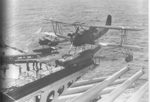 | 180k | View showing Vought O3U-1s scout-observation float planes & their disposition of the two catapults, one on the quarterdeck and the other atop X turret, circa 1928. | US National Archives photo from "Catapult Aircraft" by Leo Marriott courtesy of Robert Hurst. Photo i.d. courtesy of Alan Moore. | ||||||||||||||||||||||||||||||||||||||||||||||||||||||||||||||||||||||||||||||||||||||||||||||||||||||||||||||||||||||||||||||||||||||||||||||||||||||||||||||||||||||||||||||||||||||||||||||||||||||||||||||||||||||||||||||||||||||||||||||||||||||||||||||||||||||||||||||||||||||||||||||||||||||||||||||||||||||||||||||||||||||||||||||||||||||||||||||||||||||||||||||||||||||||||||||||||||||||||||||||||||||||||||||||||||||||||||||||||||||||||||||||||||||||||||||||||||||||||||||||||||||||||||||||||||||||||||||||||||||||||||||||||||||||||||||||||||||||||||||||||||||||||||||||||||||||||
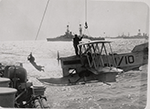 | 1.08k | Hoisting plane aboard Battleship California (BB-44) during battle practice in Pacific, 24 February 1928. Image shows pilot using zip wire to board ship from hoisted plane. | Paramount News from AP via University of Massachusetts Amherst Libraries Special Collections and University Archives, Alton H. Blackington Photograph Collection. | ||||||||||||||||||||||||||||||||||||||||||||||||||||||||||||||||||||||||||||||||||||||||||||||||||||||||||||||||||||||||||||||||||||||||||||||||||||||||||||||||||||||||||||||||||||||||||||||||||||||||||||||||||||||||||||||||||||||||||||||||||||||||||||||||||||||||||||||||||||||||||||||||||||||||||||||||||||||||||||||||||||||||||||||||||||||||||||||||||||||||||||||||||||||||||||||||||||||||||||||||||||||||||||||||||||||||||||||||||||||||||||||||||||||||||||||||||||||||||||||||||||||||||||||||||||||||||||||||||||||||||||||||||||||||||||||||||||||||||||||||||||||||||||||||||||||||||
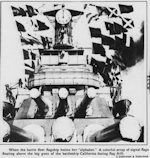 | NR | When the battle fleet flagship hoists her "alphabet." A colorful array of signal flags floating above the big guns of the battleship California (BB-44) during flag drill. | Photo by Underwood & Underwood.© Image provided by: Library of Congress, Washington, DC. Photo & text by Evening Star. [volume] (Washington, D.C.) 1854-1972, 09 December 1928, Image 115 courtesy of chroniclingamerica.loc.gov. | ||||||||||||||||||||||||||||||||||||||||||||||||||||||||||||||||||||||||||||||||||||||||||||||||||||||||||||||||||||||||||||||||||||||||||||||||||||||||||||||||||||||||||||||||||||||||||||||||||||||||||||||||||||||||||||||||||||||||||||||||||||||||||||||||||||||||||||||||||||||||||||||||||||||||||||||||||||||||||||||||||||||||||||||||||||||||||||||||||||||||||||||||||||||||||||||||||||||||||||||||||||||||||||||||||||||||||||||||||||||||||||||||||||||||||||||||||||||||||||||||||||||||||||||||||||||||||||||||||||||||||||||||||||||||||||||||||||||||||||||||||||||||||||||||||||||||||
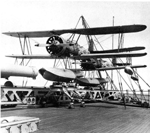 | 205k | Two Vought O2U's on the California (BB-44) in 1929. Note the handling truck that could be raised and lowered to the catapult level and securing lines for heavy weather storage. | Photo courtesy of Pieter Bakels. | ||||||||||||||||||||||||||||||||||||||||||||||||||||||||||||||||||||||||||||||||||||||||||||||||||||||||||||||||||||||||||||||||||||||||||||||||||||||||||||||||||||||||||||||||||||||||||||||||||||||||||||||||||||||||||||||||||||||||||||||||||||||||||||||||||||||||||||||||||||||||||||||||||||||||||||||||||||||||||||||||||||||||||||||||||||||||||||||||||||||||||||||||||||||||||||||||||||||||||||||||||||||||||||||||||||||||||||||||||||||||||||||||||||||||||||||||||||||||||||||||||||||||||||||||||||||||||||||||||||||||||||||||||||||||||||||||||||||||||||||||||||||||||||||||||||||||||
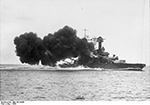 | 261k | California (BB-44) during gunnery exercises off the coast of Los Angeles, 1 January 1930. The original German caption for this image which was retained by the German Federal Archives is as follows: Amerika setzt f?r den Ausbau seiner Flotte im Bauprogramm 1930 bis 1932 1 Milliarde Dollars fest ! Unser Bild zeigt den amerikanischen Schlachtkreuzer "Kalifornia" beim Feuern anl?sslich eines Man?vers an der K?ste Los Angelos (America spends 1 billion dollars for the development of its fleet in the 1930 to 1932 building program! Our picture shows the American battle cruiser California firing on the occasion of a maneuver of the coast of Los Angelos. | Image from the German Federal Archives, Koblenz, Germany. Aktuelle-Bilder-Centrale, Georg Pahl. Bild 102-10189 via Robert Hurst. | ||||||||||||||||||||||||||||||||||||||||||||||||||||||||||||||||||||||||||||||||||||||||||||||||||||||||||||||||||||||||||||||||||||||||||||||||||||||||||||||||||||||||||||||||||||||||||||||||||||||||||||||||||||||||||||||||||||||||||||||||||||||||||||||||||||||||||||||||||||||||||||||||||||||||||||||||||||||||||||||||||||||||||||||||||||||||||||||||||||||||||||||||||||||||||||||||||||||||||||||||||||||||||||||||||||||||||||||||||||||||||||||||||||||||||||||||||||||||||||||||||||||||||||||||||||||||||||||||||||||||||||||||||||||||||||||||||||||||||||||||||||||||||||||||||||||||||
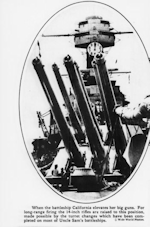 | NR | When the battleship California (BB-44) elevates her big guns for long-range firing the 14-inch rifles are raised to this position, made possible by the turret changes which have been completed on most of Uncle Sam's battleships. | Image provided by: Library of Congress, Washington, DC. Photo & text by Evening star. [volume] (Washington, D.C.) 1854-1972, 20 April 1930, Image 106, courtesy of chroniclingamerica.loc.gov. | ||||||||||||||||||||||||||||||||||||||||||||||||||||||||||||||||||||||||||||||||||||||||||||||||||||||||||||||||||||||||||||||||||||||||||||||||||||||||||||||||||||||||||||||||||||||||||||||||||||||||||||||||||||||||||||||||||||||||||||||||||||||||||||||||||||||||||||||||||||||||||||||||||||||||||||||||||||||||||||||||||||||||||||||||||||||||||||||||||||||||||||||||||||||||||||||||||||||||||||||||||||||||||||||||||||||||||||||||||||||||||||||||||||||||||||||||||||||||||||||||||||||||||||||||||||||||||||||||||||||||||||||||||||||||||||||||||||||||||||||||||||||||||||||||||||||||||
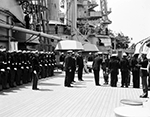 | 1.43k | 21 May 1930 photograph of meetings between the United States Battle Fleet Commander, Adrmiral L. M. Nulton and Norfolk city official and other dignitaries on the Fleet flagship, the California (BB-44) in Norfolk, Virginia. | Photo from The Virginian-Pilot Photograph Collection / SMC Photograph Collection from the Norfolk Public Library (Va.) via Andrew Payne. | ||||||||||||||||||||||||||||||||||||||||||||||||||||||||||||||||||||||||||||||||||||||||||||||||||||||||||||||||||||||||||||||||||||||||||||||||||||||||||||||||||||||||||||||||||||||||||||||||||||||||||||||||||||||||||||||||||||||||||||||||||||||||||||||||||||||||||||||||||||||||||||||||||||||||||||||||||||||||||||||||||||||||||||||||||||||||||||||||||||||||||||||||||||||||||||||||||||||||||||||||||||||||||||||||||||||||||||||||||||||||||||||||||||||||||||||||||||||||||||||||||||||||||||||||||||||||||||||||||||||||||||||||||||||||||||||||||||||||||||||||||||||||||||||||||||||||||
 | 233k | California (BB-44) in the Pacific side of the Panama Canal Zone. | Photo # 80-G-1025057 from the U.S. National Archives, courtesy of Bill Gonyo. | ||||||||||||||||||||||||||||||||||||||||||||||||||||||||||||||||||||||||||||||||||||||||||||||||||||||||||||||||||||||||||||||||||||||||||||||||||||||||||||||||||||||||||||||||||||||||||||||||||||||||||||||||||||||||||||||||||||||||||||||||||||||||||||||||||||||||||||||||||||||||||||||||||||||||||||||||||||||||||||||||||||||||||||||||||||||||||||||||||||||||||||||||||||||||||||||||||||||||||||||||||||||||||||||||||||||||||||||||||||||||||||||||||||||||||||||||||||||||||||||||||||||||||||||||||||||||||||||||||||||||||||||||||||||||||||||||||||||||||||||||||||||||||||||||||||||||||
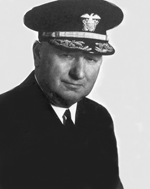 | 67k | Captain Edward Clifford 'Old Dutch' Kalbfus left the Naval War College in 1929 to serve as captain of the battleship California (BB-44). Promoted to rear admiral, he was assigned as chief of staff to Commander Battleships, Battle Fleet in 1930, then went ashore as director of war plans in the Navy Department for six months in 1931 before returning to sea as Commander Destroyers, Battle Force, United States Fleet from 1931 to 1934. | USN photo via Bill Gonyo. | ||||||||||||||||||||||||||||||||||||||||||||||||||||||||||||||||||||||||||||||||||||||||||||||||||||||||||||||||||||||||||||||||||||||||||||||||||||||||||||||||||||||||||||||||||||||||||||||||||||||||||||||||||||||||||||||||||||||||||||||||||||||||||||||||||||||||||||||||||||||||||||||||||||||||||||||||||||||||||||||||||||||||||||||||||||||||||||||||||||||||||||||||||||||||||||||||||||||||||||||||||||||||||||||||||||||||||||||||||||||||||||||||||||||||||||||||||||||||||||||||||||||||||||||||||||||||||||||||||||||||||||||||||||||||||||||||||||||||||||||||||||||||||||||||||||||||||
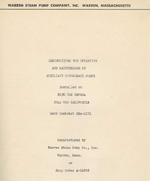 | 2.44k | Instructions For Operation & Maintenance of Auxillary Condensate Pumps for the Nevada (BB-36) & California (BB-44). | Photo fix courtesy of Tom Kermen. Photo courtesy of Ed Zajkowski. | ||||||||||||||||||||||||||||||||||||||||||||||||||||||||||||||||||||||||||||||||||||||||||||||||||||||||||||||||||||||||||||||||||||||||||||||||||||||||||||||||||||||||||||||||||||||||||||||||||||||||||||||||||||||||||||||||||||||||||||||||||||||||||||||||||||||||||||||||||||||||||||||||||||||||||||||||||||||||||||||||||||||||||||||||||||||||||||||||||||||||||||||||||||||||||||||||||||||||||||||||||||||||||||||||||||||||||||||||||||||||||||||||||||||||||||||||||||||||||||||||||||||||||||||||||||||||||||||||||||||||||||||||||||||||||||||||||||||||||||||||||||||||||||||||||||||||||
| 1931 - Pre Pearl Harbor |
|||||||||||||||||||||||||||||||||||||||||||||||||||||||||||||||||||||||||||||||||||||||||||||||||||||||||||||||||||||||||||||||||||||||||||||||||||||||||||||||||||||||||||||||||||||||||||||||||||||||||||||||||||||||||||||||||||||||||||||||||||||||||||||||||||||||||||||||||||||||||||||||||||||||||||||||||||||||||||||||||||||||||||||||||||||||||||||||||||||||||||||||||||||||||||||||||||||||||||||||||||||||||||||||||||||||||||||||||||||||||||||||||||||||||||||||||||||||||||||||||||||||||||||||||||||||||||||||||||||||||||||||||||||||||||||||||||||||||||||||||||||||||||||||||||||||||||||
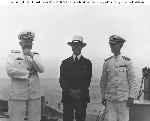 | 50k | Admiral William V. Pratt, USN, Chief of Naval Operations; Charles F. Adams, Secretary of the Navy; and Admiral Frank H. Schofield, USN, Commander, Battle Force, United States Fleet (listed from left to right)enjoy a humorous moment on board California (BB-44), circa February 1931. | Naval History and Heritage Command # NH 75863. Courtesy of the Naval Historical Foundation. Collection of Admiral William V. Pratt. | ||||||||||||||||||||||||||||||||||||||||||||||||||||||||||||||||||||||||||||||||||||||||||||||||||||||||||||||||||||||||||||||||||||||||||||||||||||||||||||||||||||||||||||||||||||||||||||||||||||||||||||||||||||||||||||||||||||||||||||||||||||||||||||||||||||||||||||||||||||||||||||||||||||||||||||||||||||||||||||||||||||||||||||||||||||||||||||||||||||||||||||||||||||||||||||||||||||||||||||||||||||||||||||||||||||||||||||||||||||||||||||||||||||||||||||||||||||||||||||||||||||||||||||||||||||||||||||||||||||||||||||||||||||||||||||||||||||||||||||||||||||||||||||||||||||||||||
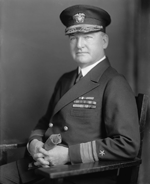 | 106k | Admiral Luke McNamee flew his pennant on his flagship the California (BB-44) during his tenure as Commander Battle Force Pacific from 11 August 1932 to 20 May 1933. | Photo from the Library of Congress & via Bill Gonyo. | ||||||||||||||||||||||||||||||||||||||||||||||||||||||||||||||||||||||||||||||||||||||||||||||||||||||||||||||||||||||||||||||||||||||||||||||||||||||||||||||||||||||||||||||||||||||||||||||||||||||||||||||||||||||||||||||||||||||||||||||||||||||||||||||||||||||||||||||||||||||||||||||||||||||||||||||||||||||||||||||||||||||||||||||||||||||||||||||||||||||||||||||||||||||||||||||||||||||||||||||||||||||||||||||||||||||||||||||||||||||||||||||||||||||||||||||||||||||||||||||||||||||||||||||||||||||||||||||||||||||||||||||||||||||||||||||||||||||||||||||||||||||||||||||||||||||||||
 | 413k | New York (BB-34) ahead of Pennsylvania (BB-38). The next ship ahead is a Tennessee class (BB-43 /44) based on the slope of the turret roofs. (Uniform slope back to front - no kink like the twin 16" mounts on the Colorado's (BB-45). Based on the relatively full appearance of the forward superstructure, I am leaning toward California (BB-44) which had an enlarged flag bridge as Battle Force Flagship. The other three are obviously Tennessee (BB-43) and/or Colorado class (BB-45 / 48) but are too indistinct to ID specifically. Because of the boom cranes on the sterns, the photo was taken between 1931 and 1934. | Photo courtesy of Kerry Garrett. Photo & text i.d. courtesy of Richard M. Jensen. | ||||||||||||||||||||||||||||||||||||||||||||||||||||||||||||||||||||||||||||||||||||||||||||||||||||||||||||||||||||||||||||||||||||||||||||||||||||||||||||||||||||||||||||||||||||||||||||||||||||||||||||||||||||||||||||||||||||||||||||||||||||||||||||||||||||||||||||||||||||||||||||||||||||||||||||||||||||||||||||||||||||||||||||||||||||||||||||||||||||||||||||||||||||||||||||||||||||||||||||||||||||||||||||||||||||||||||||||||||||||||||||||||||||||||||||||||||||||||||||||||||||||||||||||||||||||||||||||||||||||||||||||||||||||||||||||||||||||||||||||||||||||||||||||||||||||||||
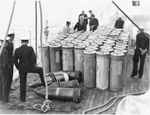 | 247k | Turret gun shells and powder coming aboard California (BB-44) prior to maneuvers and target practice in Pacific waters. | Photo courtesy of Jim Geldert. | ||||||||||||||||||||||||||||||||||||||||||||||||||||||||||||||||||||||||||||||||||||||||||||||||||||||||||||||||||||||||||||||||||||||||||||||||||||||||||||||||||||||||||||||||||||||||||||||||||||||||||||||||||||||||||||||||||||||||||||||||||||||||||||||||||||||||||||||||||||||||||||||||||||||||||||||||||||||||||||||||||||||||||||||||||||||||||||||||||||||||||||||||||||||||||||||||||||||||||||||||||||||||||||||||||||||||||||||||||||||||||||||||||||||||||||||||||||||||||||||||||||||||||||||||||||||||||||||||||||||||||||||||||||||||||||||||||||||||||||||||||||||||||||||||||||||||||
 | 1.60k | The crew is evenly spaced along the deck of the California (BB-44) with three Vought O2U's on her catapults in this early 1930's circa photo. | USN photo courtesy of Pieter Bakels. | ||||||||||||||||||||||||||||||||||||||||||||||||||||||||||||||||||||||||||||||||||||||||||||||||||||||||||||||||||||||||||||||||||||||||||||||||||||||||||||||||||||||||||||||||||||||||||||||||||||||||||||||||||||||||||||||||||||||||||||||||||||||||||||||||||||||||||||||||||||||||||||||||||||||||||||||||||||||||||||||||||||||||||||||||||||||||||||||||||||||||||||||||||||||||||||||||||||||||||||||||||||||||||||||||||||||||||||||||||||||||||||||||||||||||||||||||||||||||||||||||||||||||||||||||||||||||||||||||||||||||||||||||||||||||||||||||||||||||||||||||||||||||||||||||||||||||||
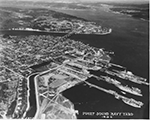 | 638k | View of the U.S. Puget Sound Navy Yard, Bremerton, Washington, in 1932, Identifiable ships include (front to back): the crane ship Kearsarge (AB-1); (probably) a Tennessee class (BB-43 / 44), two Eagle-class patrol craft; Arkansas (BB-33); three Clemson/Wilkes-class destroyers; & Lexington (CV-2). | Photo i.d. via commons.wikimedia.org. National Archives Identifier: 6036984 Photo courtesy of catalog.archives.gov |
||||||||||||||||||||||||||||||||||||||||||||||||||||||||||||||||||||||||||||||||||||||||||||||||||||||||||||||||||||||||||||||||||||||||||||||||||||||||||||||||||||||||||||||||||||||||||||||||||||||||||||||||||||||||||||||||||||||||||||||||||||||||||||||||||||||||||||||||||||||||||||||||||||||||||||||||||||||||||||||||||||||||||||||||||||||||||||||||||||||||||||||||||||||||||||||||||||||||||||||||||||||||||||||||||||||||||||||||||||||||||||||||||||||||||||||||||||||||||||||||||||||||||||||||||||||||||||||||||||||||||||||||||||||||||||||||||||||||||||||||||||||||||||||||||||||||||
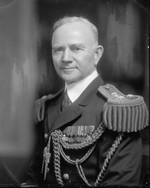 |
141k | Admiral Richard Henry Leigh, was Commander in Chief, U.S. Fleet from 15 September 1931 to 11 August 1932. His pennant flew above his flagship California (BB-44) during his tenure. | Photo courtesy of the Library of Congress via Bill Gonyo. | ||||||||||||||||||||||||||||||||||||||||||||||||||||||||||||||||||||||||||||||||||||||||||||||||||||||||||||||||||||||||||||||||||||||||||||||||||||||||||||||||||||||||||||||||||||||||||||||||||||||||||||||||||||||||||||||||||||||||||||||||||||||||||||||||||||||||||||||||||||||||||||||||||||||||||||||||||||||||||||||||||||||||||||||||||||||||||||||||||||||||||||||||||||||||||||||||||||||||||||||||||||||||||||||||||||||||||||||||||||||||||||||||||||||||||||||||||||||||||||||||||||||||||||||||||||||||||||||||||||||||||||||||||||||||||||||||||||||||||||||||||||||||||||||||||||||||||
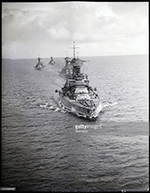 | 671k | (Original Caption) 2/5/1932-Los Angeles, CA. Here is an aerial view of 4 of Uncle Sam's Battleships as they left LA Harbor with the rest of the US Battle fleet, for the manuevers of the Hawaiian islands. (Left to Right) The ships are: Flagship California (BB-44), Maryland (BB-46), Colorado (BB-45), and West Virginia(BB-48). | Photo by Bettmann, via Getty Images, courtesy of gettyimages.com. | ||||||||||||||||||||||||||||||||||||||||||||||||||||||||||||||||||||||||||||||||||||||||||||||||||||||||||||||||||||||||||||||||||||||||||||||||||||||||||||||||||||||||||||||||||||||||||||||||||||||||||||||||||||||||||||||||||||||||||||||||||||||||||||||||||||||||||||||||||||||||||||||||||||||||||||||||||||||||||||||||||||||||||||||||||||||||||||||||||||||||||||||||||||||||||||||||||||||||||||||||||||||||||||||||||||||||||||||||||||||||||||||||||||||||||||||||||||||||||||||||||||||||||||||||||||||||||||||||||||||||||||||||||||||||||||||||||||||||||||||||||||||||||||||||||||||||||
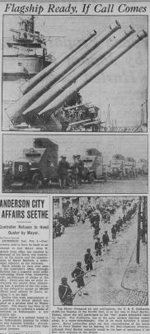 014453 |
NR | Flagship Ready, If Call Comes Top Photo—Prepared for any contingency, the California (BB-44), 32,600-ton flagship of the Pacific fleet, is on her way to Pearl Harbor, Hawaii, where she will participate in the "war" games scheduled there for March. The California, one of the most modern fighting vessels afloat, is a super-dreadnaught. One of its main batteries is shown above. Naval authorities point out that concentration of the battle fleet at Pearl Harbor has no bearing on the Sino-Japanese situation, although Pearl Harbor naturally would be the base of operations if the fleet were engaged in the Orient. |
Image and text provided by Indiana State Library. Photo from The Indianapolis Times. [volume] (Indianapolis [Ind.]) 1922-1965, 03 February 1932, Home Edition, Image 2, via chroniclingamerica.loc.gov. | ||||||||||||||||||||||||||||||||||||||||||||||||||||||||||||||||||||||||||||||||||||||||||||||||||||||||||||||||||||||||||||||||||||||||||||||||||||||||||||||||||||||||||||||||||||||||||||||||||||||||||||||||||||||||||||||||||||||||||||||||||||||||||||||||||||||||||||||||||||||||||||||||||||||||||||||||||||||||||||||||||||||||||||||||||||||||||||||||||||||||||||||||||||||||||||||||||||||||||||||||||||||||||||||||||||||||||||||||||||||||||||||||||||||||||||||||||||||||||||||||||||||||||||||||||||||||||||||||||||||||||||||||||||||||||||||||||||||||||||||||||||||||||||||||||||||||||
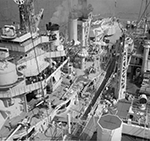 |
1.26k | The US fleet repair ship Medusa (AR-1) alongside the California (BB-44) on 25 September 1932 in Elliott Bay, Seattle. | USN photo courtesy of Pieter Bakels. | ||||||||||||||||||||||||||||||||||||||||||||||||||||||||||||||||||||||||||||||||||||||||||||||||||||||||||||||||||||||||||||||||||||||||||||||||||||||||||||||||||||||||||||||||||||||||||||||||||||||||||||||||||||||||||||||||||||||||||||||||||||||||||||||||||||||||||||||||||||||||||||||||||||||||||||||||||||||||||||||||||||||||||||||||||||||||||||||||||||||||||||||||||||||||||||||||||||||||||||||||||||||||||||||||||||||||||||||||||||||||||||||||||||||||||||||||||||||||||||||||||||||||||||||||||||||||||||||||||||||||||||||||||||||||||||||||||||||||||||||||||||||||||||||||||||||||||
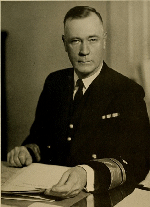 | 73k | Wilson Brown Jr., CAPT of the California (BB-44) from 01.1932 to 07.1933. He appears here as a Rear Admiral in 1939. | Image from the Lucky Bag Yearbook 1939, courtesy of Bill Gonyo. Text info courtesy of Wolfgang Hechler. | ||||||||||||||||||||||||||||||||||||||||||||||||||||||||||||||||||||||||||||||||||||||||||||||||||||||||||||||||||||||||||||||||||||||||||||||||||||||||||||||||||||||||||||||||||||||||||||||||||||||||||||||||||||||||||||||||||||||||||||||||||||||||||||||||||||||||||||||||||||||||||||||||||||||||||||||||||||||||||||||||||||||||||||||||||||||||||||||||||||||||||||||||||||||||||||||||||||||||||||||||||||||||||||||||||||||||||||||||||||||||||||||||||||||||||||||||||||||||||||||||||||||||||||||||||||||||||||||||||||||||||||||||||||||||||||||||||||||||||||||||||||||||||||||||||||||||||
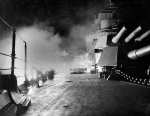 | 87k | Firing her starboard 5"/51 secondary battery, during night battle practice in 1933. View looks aft from the forecastle, with the ship's forward 14" triple gun turrets at right. | Official USN photo Naval History and Heritage Command # NH 55030, from the collections of the Naval Historical Center. | ||||||||||||||||||||||||||||||||||||||||||||||||||||||||||||||||||||||||||||||||||||||||||||||||||||||||||||||||||||||||||||||||||||||||||||||||||||||||||||||||||||||||||||||||||||||||||||||||||||||||||||||||||||||||||||||||||||||||||||||||||||||||||||||||||||||||||||||||||||||||||||||||||||||||||||||||||||||||||||||||||||||||||||||||||||||||||||||||||||||||||||||||||||||||||||||||||||||||||||||||||||||||||||||||||||||||||||||||||||||||||||||||||||||||||||||||||||||||||||||||||||||||||||||||||||||||||||||||||||||||||||||||||||||||||||||||||||||||||||||||||||||||||||||||||||||||||
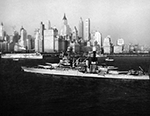 | 535k | Aerial oblique view of California (BB-44) off the port quarter while off New York, 31 May 1934. | Official USN photograph, # 80-G-463936 now in the collections of the National Archives, from the National Museum of the U.S. Navy via flickr.com. | ||||||||||||||||||||||||||||||||||||||||||||||||||||||||||||||||||||||||||||||||||||||||||||||||||||||||||||||||||||||||||||||||||||||||||||||||||||||||||||||||||||||||||||||||||||||||||||||||||||||||||||||||||||||||||||||||||||||||||||||||||||||||||||||||||||||||||||||||||||||||||||||||||||||||||||||||||||||||||||||||||||||||||||||||||||||||||||||||||||||||||||||||||||||||||||||||||||||||||||||||||||||||||||||||||||||||||||||||||||||||||||||||||||||||||||||||||||||||||||||||||||||||||||||||||||||||||||||||||||||||||||||||||||||||||||||||||||||||||||||||||||||||||||||||||||||||||
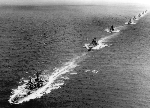 | 272k | The West Virginia (BB-48) as flagship for the Commander, Battleship Divisions, Battle Fleet, followed by other battleships steaming in line ahead during the middle through later 1920's. The aircraft on the turret catapult appears to be a Curtiss SOC (I can't make out the stern aircraft.), so the date has to be mid-to-later 1930s. The four leading ships behind her are (in no particular order) Colorado (BB-45), Maryland (BB-46), California (BB-44) & Tennessee (BB-43). | Text i.d. courtesy of Alan Moore. Photo courtesy of Pieter Bakels. |
||||||||||||||||||||||||||||||||||||||||||||||||||||||||||||||||||||||||||||||||||||||||||||||||||||||||||||||||||||||||||||||||||||||||||||||||||||||||||||||||||||||||||||||||||||||||||||||||||||||||||||||||||||||||||||||||||||||||||||||||||||||||||||||||||||||||||||||||||||||||||||||||||||||||||||||||||||||||||||||||||||||||||||||||||||||||||||||||||||||||||||||||||||||||||||||||||||||||||||||||||||||||||||||||||||||||||||||||||||||||||||||||||||||||||||||||||||||||||||||||||||||||||||||||||||||||||||||||||||||||||||||||||||||||||||||||||||||||||||||||||||||||||||||||||||||||||
 | 575k | Battleships at Balboa, Panama, on 6 May 1934 passing through for fleet exercises in the Atlantic. The stern at left belongs to Pennsylvania (BB-38). California (BB-44) is in center/right. | Photo courtesy of Ric Hedman. Photo & text i.d. courtesy of Richard M. Jensen. | ||||||||||||||||||||||||||||||||||||||||||||||||||||||||||||||||||||||||||||||||||||||||||||||||||||||||||||||||||||||||||||||||||||||||||||||||||||||||||||||||||||||||||||||||||||||||||||||||||||||||||||||||||||||||||||||||||||||||||||||||||||||||||||||||||||||||||||||||||||||||||||||||||||||||||||||||||||||||||||||||||||||||||||||||||||||||||||||||||||||||||||||||||||||||||||||||||||||||||||||||||||||||||||||||||||||||||||||||||||||||||||||||||||||||||||||||||||||||||||||||||||||||||||||||||||||||||||||||||||||||||||||||||||||||||||||||||||||||||||||||||||||||||||||||||||||||||
 | NR | BULWARK OF THE NATIONS INDEPENDENCE—the big guns of its first line of defense. Scene aboard the battleship Pennsylvania (BB-38) as Admiral Joseph Mason Reeves recently assumed command of the fleet, and a Hudson River view of the battleship California (BB-44) framed by the guns of the Pennsylvania. | Wide World and © Associated Press Photo Image provided by: Library of Congress, Washington, DC. Photo & text by Evening star. [volume] (Washington, D.C.) 1854-1972, 01 July 1934, Image 85, courtesy of chroniclingamerica.loc.gov. | ||||||||||||||||||||||||||||||||||||||||||||||||||||||||||||||||||||||||||||||||||||||||||||||||||||||||||||||||||||||||||||||||||||||||||||||||||||||||||||||||||||||||||||||||||||||||||||||||||||||||||||||||||||||||||||||||||||||||||||||||||||||||||||||||||||||||||||||||||||||||||||||||||||||||||||||||||||||||||||||||||||||||||||||||||||||||||||||||||||||||||||||||||||||||||||||||||||||||||||||||||||||||||||||||||||||||||||||||||||||||||||||||||||||||||||||||||||||||||||||||||||||||||||||||||||||||||||||||||||||||||||||||||||||||||||||||||||||||||||||||||||||||||||||||||||||||||
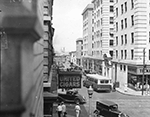 | 911k | Your local down-town battleship. 10 August 1934 photograph of the battleship California (BB-44) down West Plume Street from the Granby Street intersection in downtown Norfolk, Virginia. Businesses identified in the photograph include: W. M. Bott and Company Insurance (116 West Plume Street), Gibson Rental Bureau (100 West Plume Street), and Chesapeake Steamship Company (141 Granby Street). | Photo from The Virginian-PilotPhotograph Collection / SMC Photograph Collection from the Norfolk Public Library (Va.) | ||||||||||||||||||||||||||||||||||||||||||||||||||||||||||||||||||||||||||||||||||||||||||||||||||||||||||||||||||||||||||||||||||||||||||||||||||||||||||||||||||||||||||||||||||||||||||||||||||||||||||||||||||||||||||||||||||||||||||||||||||||||||||||||||||||||||||||||||||||||||||||||||||||||||||||||||||||||||||||||||||||||||||||||||||||||||||||||||||||||||||||||||||||||||||||||||||||||||||||||||||||||||||||||||||||||||||||||||||||||||||||||||||||||||||||||||||||||||||||||||||||||||||||||||||||||||||||||||||||||||||||||||||||||||||||||||||||||||||||||||||||||||||||||||||||||||||
 | 763k | California (BB-44) as Flagship US Navy Battle Force off San Pedro, Ca. in the 1930's. | USN photo courtesy of Pieter Bakels. | ||||||||||||||||||||||||||||||||||||||||||||||||||||||||||||||||||||||||||||||||||||||||||||||||||||||||||||||||||||||||||||||||||||||||||||||||||||||||||||||||||||||||||||||||||||||||||||||||||||||||||||||||||||||||||||||||||||||||||||||||||||||||||||||||||||||||||||||||||||||||||||||||||||||||||||||||||||||||||||||||||||||||||||||||||||||||||||||||||||||||||||||||||||||||||||||||||||||||||||||||||||||||||||||||||||||||||||||||||||||||||||||||||||||||||||||||||||||||||||||||||||||||||||||||||||||||||||||||||||||||||||||||||||||||||||||||||||||||||||||||||||||||||||||||||||||||||
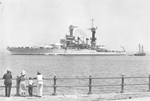 |
475k | California (BB-44) or Tennessee (BB-43) visits the Boston Navy yard, circa mid 1930's. | Photo 08_06_022495 courtesy of the Boston Public Library, Leslie Jones Collection via Sean Hert & flickr.com. | ||||||||||||||||||||||||||||||||||||||||||||||||||||||||||||||||||||||||||||||||||||||||||||||||||||||||||||||||||||||||||||||||||||||||||||||||||||||||||||||||||||||||||||||||||||||||||||||||||||||||||||||||||||||||||||||||||||||||||||||||||||||||||||||||||||||||||||||||||||||||||||||||||||||||||||||||||||||||||||||||||||||||||||||||||||||||||||||||||||||||||||||||||||||||||||||||||||||||||||||||||||||||||||||||||||||||||||||||||||||||||||||||||||||||||||||||||||||||||||||||||||||||||||||||||||||||||||||||||||||||||||||||||||||||||||||||||||||||||||||||||||||||||||||||||||||||||
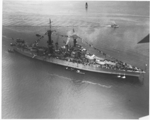 | 899k | Flags fly from fantail to fore on California (BB-44), circa 1935. | Photo courtesy of Thomas Doll. | ||||||||||||||||||||||||||||||||||||||||||||||||||||||||||||||||||||||||||||||||||||||||||||||||||||||||||||||||||||||||||||||||||||||||||||||||||||||||||||||||||||||||||||||||||||||||||||||||||||||||||||||||||||||||||||||||||||||||||||||||||||||||||||||||||||||||||||||||||||||||||||||||||||||||||||||||||||||||||||||||||||||||||||||||||||||||||||||||||||||||||||||||||||||||||||||||||||||||||||||||||||||||||||||||||||||||||||||||||||||||||||||||||||||||||||||||||||||||||||||||||||||||||||||||||||||||||||||||||||||||||||||||||||||||||||||||||||||||||||||||||||||||||||||||||||||||||
 | 101k | California (BB-44) transiting the Panama Canal, circa 1935. | Photo i.d. courtesy of Richard Jensen. Photo courtesy of Floyd Proffitt via Brad Proffitt. | ||||||||||||||||||||||||||||||||||||||||||||||||||||||||||||||||||||||||||||||||||||||||||||||||||||||||||||||||||||||||||||||||||||||||||||||||||||||||||||||||||||||||||||||||||||||||||||||||||||||||||||||||||||||||||||||||||||||||||||||||||||||||||||||||||||||||||||||||||||||||||||||||||||||||||||||||||||||||||||||||||||||||||||||||||||||||||||||||||||||||||||||||||||||||||||||||||||||||||||||||||||||||||||||||||||||||||||||||||||||||||||||||||||||||||||||||||||||||||||||||||||||||||||||||||||||||||||||||||||||||||||||||||||||||||||||||||||||||||||||||||||||||||||||||||||||||||
 014451k | 1.40k | US Navy Fleet at Balboa in the Panama Canal Zone in 1935. At the Balboa pier in the foreground is the battleship California (BB-44). The cruiser at the far left is the Indianapolis(CA-35), with an Omaha class CL to port and one of the 3 fleet flagship Northamptons (CA-29/30/31) aft. |
Photo courtesy of flickr.com via Harley Flowers. ID courtesy of Richard M. Jensen. | ||||||||||||||||||||||||||||||||||||||||||||||||||||||||||||||||||||||||||||||||||||||||||||||||||||||||||||||||||||||||||||||||||||||||||||||||||||||||||||||||||||||||||||||||||||||||||||||||||||||||||||||||||||||||||||||||||||||||||||||||||||||||||||||||||||||||||||||||||||||||||||||||||||||||||||||||||||||||||||||||||||||||||||||||||||||||||||||||||||||||||||||||||||||||||||||||||||||||||||||||||||||||||||||||||||||||||||||||||||||||||||||||||||||||||||||||||||||||||||||||||||||||||||||||||||||||||||||||||||||||||||||||||||||||||||||||||||||||||||||||||||||||||||||||||||||||||
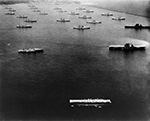 | 2.44k | Ships of the United States Fleet pictured at anchor inside the breakwater at Colon, Canal Zone, 1935. The carriers are, front to back, Langley (CV-1), Saratoga (CV-3) and Lexington (CV-2). The two battleships beyond Lexington are the New York (BB-34) with Texas (BB-35) behind. The nearest battleship, straight up from the Langley is Pennsylvania (BB-38). The BB immediately beyond and to the left of Pennsylvania (BB-38) is California (BB-44). The remaining battleships include two New Mexico's: Mississippi (BB-41) and Idaho (BB-42), but even this higher rez shot is not clear enough to tell which is which. Also are the rest of the "Big Five" and what is probably one of the Nevada's, but that is not certain. The photo is not clear enough for positive identifications. The cruisers to the left are three Northampton's (CA-26 / 31) and the two Pensacola's (CA-24 & 25) (the pair furthest from the camera) and six Omaha's. | Photo & text i.d. courtesy of Richard M. Jensen. Photo courtesy of National Naval Aviation Museum (NNAM) photo (# 1996.488.001.006) courtesy of Fabio Pena. | ||||||||||||||||||||||||||||||||||||||||||||||||||||||||||||||||||||||||||||||||||||||||||||||||||||||||||||||||||||||||||||||||||||||||||||||||||||||||||||||||||||||||||||||||||||||||||||||||||||||||||||||||||||||||||||||||||||||||||||||||||||||||||||||||||||||||||||||||||||||||||||||||||||||||||||||||||||||||||||||||||||||||||||||||||||||||||||||||||||||||||||||||||||||||||||||||||||||||||||||||||||||||||||||||||||||||||||||||||||||||||||||||||||||||||||||||||||||||||||||||||||||||||||||||||||||||||||||||||||||||||||||||||||||||||||||||||||||||||||||||||||||||||||||||||||||||||
 080000w |
1.81 | Many ships at inner Balboa Harbor, Panama. Likely taken 1935-1940. The California (BB-44) is the battleship on the left, the Indianapolis (CA-35) is behind her, along with one of the Omaha class cruisers interspersed with various destroyers & other craft. 6 submarines are at the right end of picture alongside their tender Holland (AS-3). Regarding a positive i.d. it is hard to tell. The photo seems to indicate that they are: Narwhal (SS-167), Barracuda (SS-163), Bass (SS-164), Bonita (SS-165), Dolphin (SS-169). The outer boat is Cachalot (SS-170). After May - June 1937 the boats 163 - 165 were decommissioned at Philadelphia until September 1940. They all seem to be part of SUBDIV12. Unfortunately the only data I have found so far is from 1939. |
Photo i.d. courtesy of David Johnston, Ric Hedman & Richard M. Jensen. Photo courtesy of Walter Fish via Steve Hatchett & Fabio Pena. | ||||||||||||||||||||||||||||||||||||||||||||||||||||||||||||||||||||||||||||||||||||||||||||||||||||||||||||||||||||||||||||||||||||||||||||||||||||||||||||||||||||||||||||||||||||||||||||||||||||||||||||||||||||||||||||||||||||||||||||||||||||||||||||||||||||||||||||||||||||||||||||||||||||||||||||||||||||||||||||||||||||||||||||||||||||||||||||||||||||||||||||||||||||||||||||||||||||||||||||||||||||||||||||||||||||||||||||||||||||||||||||||||||||||||||||||||||||||||||||||||||||||||||||||||||||||||||||||||||||||||||||||||||||||||||||||||||||||||||||||||||||||||||||||||||||||||||
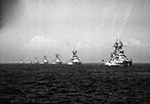 | 274k | US Navy battleships in parade formation in San Diego, California, 23 August 1935. Pennsylvania (BB-38) in the lead followed by West Virginia (BB-48), Colorado (BB-45), Maryland (BB-46), California (BB-44) and Texas (BB-35). The ship behind the Texas appears to be the New York (BB-34). You can see a shadow on the forward fighting top consistent with the forward-facing bathtub that New York had, plus you can barely make out the double turrets. | Photo i.d. courtesy of Richard Jensen with an assit from Richard McSlick. USN photo # 80-G-462946 from the National Museum of the U.S. Navy via flickr.com. | ||||||||||||||||||||||||||||||||||||||||||||||||||||||||||||||||||||||||||||||||||||||||||||||||||||||||||||||||||||||||||||||||||||||||||||||||||||||||||||||||||||||||||||||||||||||||||||||||||||||||||||||||||||||||||||||||||||||||||||||||||||||||||||||||||||||||||||||||||||||||||||||||||||||||||||||||||||||||||||||||||||||||||||||||||||||||||||||||||||||||||||||||||||||||||||||||||||||||||||||||||||||||||||||||||||||||||||||||||||||||||||||||||||||||||||||||||||||||||||||||||||||||||||||||||||||||||||||||||||||||||||||||||||||||||||||||||||||||||||||||||||||||||||||||||||||||||
 | 1.80k | 1936 photo of Battleship Row, Pearl Harbor. Among the ships in the harbor are: Front and center a Northampton class CA, most likely the Chester (CA-27). The two New Orleans (CA-32) class cruisers on the far left are the Minneapolis (CA-36) nearer the camera with New Orleans (CA-32) behind. Both have the curved-faced turrets, limiting them to the CA-32/34/36 group. Within that group, only New Orleans lacked the glassed-in navigation bridge (below the pilothouse), and minor superstructure variations point to the other being Minneapolis rather than Astoria (CA-34). The battleships from left to right: Colorado (BB-45), or West Virginia (BB-48), outboard of Idaho (BB-42), Nevada (BB-36), outboard of Mississippi (BB-41), New Mexico (BB-40), outboard of Maryland (BB-46) or California (BB-44). On the far right is the Hospital ship Relief (AH-1) with two unidentified ships ahead and to her port side.
| Text courtesy of David Johnston, (USNR), Aryeh Wetherhorn (USNR) & Richard Jensen. Photo courtesy of Edward Cwalinski, submitted by Barry Litchfield. | ||||||||||||||||||||||||||||||||||||||||||||||||||||||||||||||||||||||||||||||||||||||||||||||||||||||||||||||||||||||||||||||||||||||||||||||||||||||||||||||||||||||||||||||||||||||||||||||||||||||||||||||||||||||||||||||||||||||||||||||||||||||||||||||||||||||||||||||||||||||||||||||||||||||||||||||||||||||||||||||||||||||||||||||||||||||||||||||||||||||||||||||||||||||||||||||||||||||||||||||||||||||||||||||||||||||||||||||||||||||||||||||||||||||||||||||||||||||||||||||||||||||||||||||||||||||||||||||||||||||||||||||||||||||||||||||||||||||||||||||||||||||||||||||||||||||||||
 014443c | 674k | US battleships at anchor, Long Beach. | Photo courtesy of meisterdrucke.uk | ||||||||||||||||||||||||||||||||||||||||||||||||||||||||||||||||||||||||||||||||||||||||||||||||||||||||||||||||||||||||||||||||||||||||||||||||||||||||||||||||||||||||||||||||||||||||||||||||||||||||||||||||||||||||||||||||||||||||||||||||||||||||||||||||||||||||||||||||||||||||||||||||||||||||||||||||||||||||||||||||||||||||||||||||||||||||||||||||||||||||||||||||||||||||||||||||||||||||||||||||||||||||||||||||||||||||||||||||||||||||||||||||||||||||||||||||||||||||||||||||||||||||||||||||||||||||||||||||||||||||||||||||||||||||||||||||||||||||||||||||||||||||||||||||||||||||||
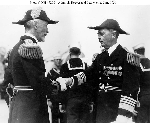 | 70k | Admiral William D. Leahy (right) shakes hands with Admiral Joseph M. Reeves during change of command ceremonies in which Admiral Leahy relieved Admiral Reeves as Commander, Battle Force, U.S. Fleet, circa June 1936. Probably taken on board California (BB-44). | U.S. Naval Historical Center Photograph NH 47298 & via Bill Gonyo. | ||||||||||||||||||||||||||||||||||||||||||||||||||||||||||||||||||||||||||||||||||||||||||||||||||||||||||||||||||||||||||||||||||||||||||||||||||||||||||||||||||||||||||||||||||||||||||||||||||||||||||||||||||||||||||||||||||||||||||||||||||||||||||||||||||||||||||||||||||||||||||||||||||||||||||||||||||||||||||||||||||||||||||||||||||||||||||||||||||||||||||||||||||||||||||||||||||||||||||||||||||||||||||||||||||||||||||||||||||||||||||||||||||||||||||||||||||||||||||||||||||||||||||||||||||||||||||||||||||||||||||||||||||||||||||||||||||||||||||||||||||||||||||||||||||||||||||
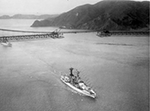 | 809k | California (BB-44) passing under the Golden Gate Bridge, under construction on 11 October 1936. | Photo i.d. courtesy of Richard Jensen. National Archives # 80-CF-2055-8. | ||||||||||||||||||||||||||||||||||||||||||||||||||||||||||||||||||||||||||||||||||||||||||||||||||||||||||||||||||||||||||||||||||||||||||||||||||||||||||||||||||||||||||||||||||||||||||||||||||||||||||||||||||||||||||||||||||||||||||||||||||||||||||||||||||||||||||||||||||||||||||||||||||||||||||||||||||||||||||||||||||||||||||||||||||||||||||||||||||||||||||||||||||||||||||||||||||||||||||||||||||||||||||||||||||||||||||||||||||||||||||||||||||||||||||||||||||||||||||||||||||||||||||||||||||||||||||||||||||||||||||||||||||||||||||||||||||||||||||||||||||||||||||||||||||||||||||
 | 49k | A postcard of the California (BB-44) passing under the Brooklyn Bridge, note the Curtiss SOC-3 floatplane atop the turret # 3 catapult, 1938. | Courtesy of Richard Leonhardt. | ||||||||||||||||||||||||||||||||||||||||||||||||||||||||||||||||||||||||||||||||||||||||||||||||||||||||||||||||||||||||||||||||||||||||||||||||||||||||||||||||||||||||||||||||||||||||||||||||||||||||||||||||||||||||||||||||||||||||||||||||||||||||||||||||||||||||||||||||||||||||||||||||||||||||||||||||||||||||||||||||||||||||||||||||||||||||||||||||||||||||||||||||||||||||||||||||||||||||||||||||||||||||||||||||||||||||||||||||||||||||||||||||||||||||||||||||||||||||||||||||||||||||||||||||||||||||||||||||||||||||||||||||||||||||||||||||||||||||||||||||||||||||||||||||||||||||||
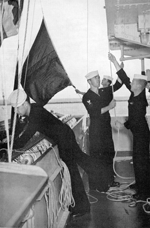 | 944k | The signal force of the California (BB-44) holding flag hoist drill. Navy Recruiting Bureau, N.Y. via USNIP, 1938. | USN photo courtesy of Pieter Bakels. | ||||||||||||||||||||||||||||||||||||||||||||||||||||||||||||||||||||||||||||||||||||||||||||||||||||||||||||||||||||||||||||||||||||||||||||||||||||||||||||||||||||||||||||||||||||||||||||||||||||||||||||||||||||||||||||||||||||||||||||||||||||||||||||||||||||||||||||||||||||||||||||||||||||||||||||||||||||||||||||||||||||||||||||||||||||||||||||||||||||||||||||||||||||||||||||||||||||||||||||||||||||||||||||||||||||||||||||||||||||||||||||||||||||||||||||||||||||||||||||||||||||||||||||||||||||||||||||||||||||||||||||||||||||||||||||||||||||||||||||||||||||||||||||||||||||||||||
 | 249k | California (BB-44) poses for a George Winstead photo in the late 1930's. | USN photo courtesy of Robert M. Cieri. | ||||||||||||||||||||||||||||||||||||||||||||||||||||||||||||||||||||||||||||||||||||||||||||||||||||||||||||||||||||||||||||||||||||||||||||||||||||||||||||||||||||||||||||||||||||||||||||||||||||||||||||||||||||||||||||||||||||||||||||||||||||||||||||||||||||||||||||||||||||||||||||||||||||||||||||||||||||||||||||||||||||||||||||||||||||||||||||||||||||||||||||||||||||||||||||||||||||||||||||||||||||||||||||||||||||||||||||||||||||||||||||||||||||||||||||||||||||||||||||||||||||||||||||||||||||||||||||||||||||||||||||||||||||||||||||||||||||||||||||||||||||||||||||||||||||||||||
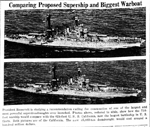 014436 |
NR | Comparing Proposed Supership and Biggest Warboat President Roosevelt is studying a recommendation calling for construction of one of the largest and most powerful superdreadnaughts ever launched. Photos above, reduced to scale, show how the 710-foot warship (North Carolina class) would compare with the 624-foot California (BB-44), now the largest battleship in U. S.fleet. Both pictures are of the California. The new 45,000-ton dreadnaught would cost around a hundred million dollars. |
Image and text provided by University of North Carolina at Chapel Hill Library, Chapel Hill, NC. Photo from The Times-News. [volume] (Hendersonville, N.C.) 1927-current, 19 December 1938, Image 6, via chroniclingamerica.loc.gov. | ||||||||||||||||||||||||||||||||||||||||||||||||||||||||||||||||||||||||||||||||||||||||||||||||||||||||||||||||||||||||||||||||||||||||||||||||||||||||||||||||||||||||||||||||||||||||||||||||||||||||||||||||||||||||||||||||||||||||||||||||||||||||||||||||||||||||||||||||||||||||||||||||||||||||||||||||||||||||||||||||||||||||||||||||||||||||||||||||||||||||||||||||||||||||||||||||||||||||||||||||||||||||||||||||||||||||||||||||||||||||||||||||||||||||||||||||||||||||||||||||||||||||||||||||||||||||||||||||||||||||||||||||||||||||||||||||||||||||||||||||||||||||||||||||||||||||||
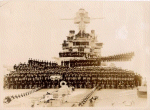 | 58k | Pre-WWII formal photo of the battleship California (BB-44) and her crew. | Contributed by Sharon Gavin. | ||||||||||||||||||||||||||||||||||||||||||||||||||||||||||||||||||||||||||||||||||||||||||||||||||||||||||||||||||||||||||||||||||||||||||||||||||||||||||||||||||||||||||||||||||||||||||||||||||||||||||||||||||||||||||||||||||||||||||||||||||||||||||||||||||||||||||||||||||||||||||||||||||||||||||||||||||||||||||||||||||||||||||||||||||||||||||||||||||||||||||||||||||||||||||||||||||||||||||||||||||||||||||||||||||||||||||||||||||||||||||||||||||||||||||||||||||||||||||||||||||||||||||||||||||||||||||||||||||||||||||||||||||||||||||||||||||||||||||||||||||||||||||||||||||||||||||
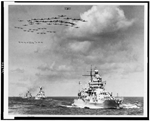 | 463k | Probable front and rear photos here and below showing formations of aircraft flying over U.S. Navy battleships during exercises at sea, 1938 / 1939. Pictured here is the New Mexico (BB-40) in the van with other battleships of the Pacific Fleet and a carrier air group, led by the Air Group Commander in a Curtiss SBC Helldiver. The aircraft following are: A torpedo squadron of eighteen Douglas TBD-1s; A bombing squadron of eighteen Northrop BT-1s; A scouting squadron eighteen Curtiss SBCs; A fighting squadron of eighteen Grumman F2F-1s or F3F-3s from either the Yorktown (CV-5) or F3F-2s from the Enterprise (CV-6), plus possibly nine additional aircraft. The Yorktown and Enterprise were the only two carriers whose bombing squadrons were equipped with the Northrop BT-1. The text for the photo reads: "The Navy uses enormous amounts of rubber. At least seventy-five tons of rubber, enough to makes 17,000 tires, are used in the construction of each of these battleships. Tons more are needed for the naval planes that are making history over the world. Medical and communication requirements--and countless other needs of the Navy--are met." The lead BB looks like Mississippi (BB-41) followed by Maryland (BB-46) (rangefinder on Turret II). My first impression of the Tennessee class (BB-43 /44) is the Tennessee (BB-43), but that is not a certain ID from this photo alone. Fourth is the Oklahoma (BB-37) (no birdbath). Aside from the DD now in the lead, I see nothing in the head-on shot aerial that positively differs from the ID's of the first 4 BB's in the first photo. Of course, in the aft aerial shot, BB #5 is the California (BB-44), ID'd by the enlarged flag bridge, lending support to BB #3 in the first photo being Tennessee. Everything I see supports these three photos all being part of the same operation with at least the first 5 BB's remaining in the same order. |
Photograph # LC-USE64 - DC-000944 & partial text courtesy of memory.loc.gov. Battleship i.d. & text courtesy of Richard Jensen. Aircraft i.d. & text & timeline courtesy of Alan Moore via the following sources: Airplane i.d.: Yorktown Class Carriers (Warship Pictorial No. 9) by Steve Wiper, Tucson, AZ: Classic Warships Publishing, 2000. & That Gallant Ship: U.S.S. Yorktown (CV-5) by Robert Cressman, Missoula, MT: Pictorial Histories Pub Co, 1985. Timeline from Battleship Arizona: An Illustrated History by Paul Stillwell, Annapolis, MD: Naval Institute Press, 1991. |
||||||||||||||||||||||||||||||||||||||||||||||||||||||||||||||||||||||||||||||||||||||||||||||||||||||||||||||||||||||||||||||||||||||||||||||||||||||||||||||||||||||||||||||||||||||||||||||||||||||||||||||||||||||||||||||||||||||||||||||||||||||||||||||||||||||||||||||||||||||||||||||||||||||||||||||||||||||||||||||||||||||||||||||||||||||||||||||||||||||||||||||||||||||||||||||||||||||||||||||||||||||||||||||||||||||||||||||||||||||||||||||||||||||||||||||||||||||||||||||||||||||||||||||||||||||||||||||||||||||||||||||||||||||||||||||||||||||||||||||||||||||||||||||||||||||||||
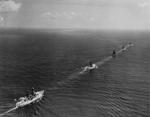 | 1.62k | Probable front and rear photos here and above showing formations of aircraft flying over U.S. Navy battleships during exercises at sea, 1938 / 1939. New Mexico (BB-40) is leading the BB column while the remaining battleships have dual masthead fire control structures. The air group formation in the two photos appears to be similar. The composition of 18 TBDs, 18 BT-1s, 18 SBCs, and 27 fighters is easier to distinguish in the front/surface view. I'm assuming, based on total aircraft count alone, that the formation in the rear/aerial view is the same. (The perspective makes it difficult to sort the monoplanes and biplanes into their respective types.) The only difference is that in the front/surface view the formation is lead by a Curtiss SBC Helldiver (likely the Air Group Commander) but in the rear/aerial view that lead Helldiver is not present. I suppose it's possible that the photographer was in that Helldiver's rear seat. What stands out for me is the presence of nine extra fighters beyond the normal squadron composition of 18, as seen in the other three squadrons in this formation. | Photo i.d courtesy of Chuck Haberlein, Richard Jensen, Aryeh Wetherhorn, & Tracy White @ Researcher @ Large. Battleship i.d. & text courtesy of Richard Jensen. Aircraft i.d. & text courtesy of Alan Moore. US Navy and Marine Corps Museum/Naval Aviation Museum, photo No. 2008.104.001.234. | ||||||||||||||||||||||||||||||||||||||||||||||||||||||||||||||||||||||||||||||||||||||||||||||||||||||||||||||||||||||||||||||||||||||||||||||||||||||||||||||||||||||||||||||||||||||||||||||||||||||||||||||||||||||||||||||||||||||||||||||||||||||||||||||||||||||||||||||||||||||||||||||||||||||||||||||||||||||||||||||||||||||||||||||||||||||||||||||||||||||||||||||||||||||||||||||||||||||||||||||||||||||||||||||||||||||||||||||||||||||||||||||||||||||||||||||||||||||||||||||||||||||||||||||||||||||||||||||||||||||||||||||||||||||||||||||||||||||||||||||||||||||||||||||||||||||||||
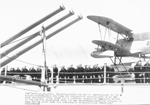 | 398k | ALL DRESSED UP AND SOMEWHERE TO GO Sailors on the surprise orders came from the Navy Department at Washington battleship California (BB-44), lined up on deck at Hampton Roads after turning the United States fleet back to the Pacific Coast. Norfolk VA., 16 April 1939."Guns, planes & men of war." Sailors on the California neat and trim for perspective review, line up on the deck yesterday after orders for a surprise journey and immediate return to the Pacific coast, came from the War Department. Above, the sailors on deck, neath, shiny guns and airplanes (on catapult). | A.P. Wirephoto from the collection of Michael Strout, courtesy of Jonathan Eno. Image and text provided by Library of Congress, Washington, DC. Photo from Evening Star. [volume] (Washington, D.C.) 1854-1972, 16 April 1939, Image 3, via chroniclingamerica.loc.gov. |
||||||||||||||||||||||||||||||||||||||||||||||||||||||||||||||||||||||||||||||||||||||||||||||||||||||||||||||||||||||||||||||||||||||||||||||||||||||||||||||||||||||||||||||||||||||||||||||||||||||||||||||||||||||||||||||||||||||||||||||||||||||||||||||||||||||||||||||||||||||||||||||||||||||||||||||||||||||||||||||||||||||||||||||||||||||||||||||||||||||||||||||||||||||||||||||||||||||||||||||||||||||||||||||||||||||||||||||||||||||||||||||||||||||||||||||||||||||||||||||||||||||||||||||||||||||||||||||||||||||||||||||||||||||||||||||||||||||||||||||||||||||||||||||||||||||||||
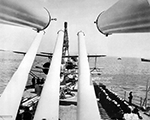 | 619k | Guns of the battleship California (BB-44) and some sailors of the crew lined up on deck. Norfolk, Virginia, April 1939. | Photo by Mondadori Portfolio via Getty Images, courtesy of gettyimages.com. | ||||||||||||||||||||||||||||||||||||||||||||||||||||||||||||||||||||||||||||||||||||||||||||||||||||||||||||||||||||||||||||||||||||||||||||||||||||||||||||||||||||||||||||||||||||||||||||||||||||||||||||||||||||||||||||||||||||||||||||||||||||||||||||||||||||||||||||||||||||||||||||||||||||||||||||||||||||||||||||||||||||||||||||||||||||||||||||||||||||||||||||||||||||||||||||||||||||||||||||||||||||||||||||||||||||||||||||||||||||||||||||||||||||||||||||||||||||||||||||||||||||||||||||||||||||||||||||||||||||||||||||||||||||||||||||||||||||||||||||||||||||||||||||||||||||||||||
 | 853k | 15 April 1939 photograph of the California (BB-44) in Hampton Roads, Virginia. | Photo from The Virginian-Pilot Photograph Collection / SMC Photograph Collection from the Norfolk Public Library (Va.) via Andrew Payne. | ||||||||||||||||||||||||||||||||||||||||||||||||||||||||||||||||||||||||||||||||||||||||||||||||||||||||||||||||||||||||||||||||||||||||||||||||||||||||||||||||||||||||||||||||||||||||||||||||||||||||||||||||||||||||||||||||||||||||||||||||||||||||||||||||||||||||||||||||||||||||||||||||||||||||||||||||||||||||||||||||||||||||||||||||||||||||||||||||||||||||||||||||||||||||||||||||||||||||||||||||||||||||||||||||||||||||||||||||||||||||||||||||||||||||||||||||||||||||||||||||||||||||||||||||||||||||||||||||||||||||||||||||||||||||||||||||||||||||||||||||||||||||||||||||||||||||||
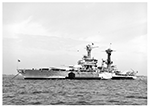 | 706k | YF 226 buoys the California (BB-44) in Hampton Roads, Virginia. | Photo from The Virginian-Pilot Photograph Collection / SMC Photograph Collection from the Norfolk Public Library (Va.) via Andrew Payne. | ||||||||||||||||||||||||||||||||||||||||||||||||||||||||||||||||||||||||||||||||||||||||||||||||||||||||||||||||||||||||||||||||||||||||||||||||||||||||||||||||||||||||||||||||||||||||||||||||||||||||||||||||||||||||||||||||||||||||||||||||||||||||||||||||||||||||||||||||||||||||||||||||||||||||||||||||||||||||||||||||||||||||||||||||||||||||||||||||||||||||||||||||||||||||||||||||||||||||||||||||||||||||||||||||||||||||||||||||||||||||||||||||||||||||||||||||||||||||||||||||||||||||||||||||||||||||||||||||||||||||||||||||||||||||||||||||||||||||||||||||||||||||||||||||||||||||||
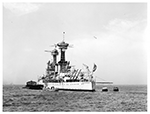 | 789k | Stern view of the California (BB-44) in Hampton Roads, Virginia. | Photo from The Virginian-Pilot Photograph Collection / SMC Photograph Collection from the Norfolk Public Library (Va.) via Andrew Payne. | ||||||||||||||||||||||||||||||||||||||||||||||||||||||||||||||||||||||||||||||||||||||||||||||||||||||||||||||||||||||||||||||||||||||||||||||||||||||||||||||||||||||||||||||||||||||||||||||||||||||||||||||||||||||||||||||||||||||||||||||||||||||||||||||||||||||||||||||||||||||||||||||||||||||||||||||||||||||||||||||||||||||||||||||||||||||||||||||||||||||||||||||||||||||||||||||||||||||||||||||||||||||||||||||||||||||||||||||||||||||||||||||||||||||||||||||||||||||||||||||||||||||||||||||||||||||||||||||||||||||||||||||||||||||||||||||||||||||||||||||||||||||||||||||||||||||||||
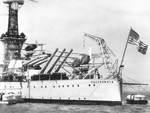 | 493k | Norfolk VA., 16 April 1939. "Under sailing orders." Members of the crew of the California (BB-44) are drawn up on the deck of the vessel shortly after receipt of the surprise order yesterday for an immediate return of the Fleet to the Pacific. Over them look planes and guns, grim evidence of the warship's efficency. | A.P. Wirephoto from the collection of Michael Strout, courtesy of Jonathan Eno. | ||||||||||||||||||||||||||||||||||||||||||||||||||||||||||||||||||||||||||||||||||||||||||||||||||||||||||||||||||||||||||||||||||||||||||||||||||||||||||||||||||||||||||||||||||||||||||||||||||||||||||||||||||||||||||||||||||||||||||||||||||||||||||||||||||||||||||||||||||||||||||||||||||||||||||||||||||||||||||||||||||||||||||||||||||||||||||||||||||||||||||||||||||||||||||||||||||||||||||||||||||||||||||||||||||||||||||||||||||||||||||||||||||||||||||||||||||||||||||||||||||||||||||||||||||||||||||||||||||||||||||||||||||||||||||||||||||||||||||||||||||||||||||||||||||||||||||
 | 78k | Liberty party prepares to go ashore, 1940. Note very large letters "CAL" painted on the whaleboat at left. Three Curtiss SOC-3 floatplanes are visible, parked atop the turret # 3 catapult and on the after catapult. The aircraft with the dark fuselage is the "Flag Plane" of Commander, Battle Force, U.S. Fleet. Its color scheme was dark blue and silver. Boat in the foreground is from Detroit (CL-8). | Official USN photo Naval History and Heritage Command # NH 80516, from the collections of the Naval Historical Center. | ||||||||||||||||||||||||||||||||||||||||||||||||||||||||||||||||||||||||||||||||||||||||||||||||||||||||||||||||||||||||||||||||||||||||||||||||||||||||||||||||||||||||||||||||||||||||||||||||||||||||||||||||||||||||||||||||||||||||||||||||||||||||||||||||||||||||||||||||||||||||||||||||||||||||||||||||||||||||||||||||||||||||||||||||||||||||||||||||||||||||||||||||||||||||||||||||||||||||||||||||||||||||||||||||||||||||||||||||||||||||||||||||||||||||||||||||||||||||||||||||||||||||||||||||||||||||||||||||||||||||||||||||||||||||||||||||||||||||||||||||||||||||||||||||||||||||||
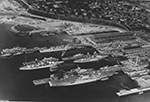 | 465k | View of the U.S. Puget Sound Navy Yard, Bremerton, Washington, in 1940. Identifiable ships include (front to back): the aircraft carrier Lexington (CV-2); a New Orleans-class heavy cruiser; a Tennessee class (BB-43 / 44) battleship (left); a Nevada-class (BB-36 / 37) battleship; a Brooklyn-class light cruiser; two Farragut-class destroyers; a Northampton-class heavy cruiser is in a drydock; one of the destroyers in the foreground is probably Charles F. Hughes (DD-428) which was built at the Puget Sound Naval Shipyard and commissioned on 5 September 1940. The other could be Monssen (DD-436), commissioned on 14 March 1941. The construction of Drydock No. 5 was started in the background. | National Archives Identifier: 6036986 Photo courtesy of catalog.archives.gov |
||||||||||||||||||||||||||||||||||||||||||||||||||||||||||||||||||||||||||||||||||||||||||||||||||||||||||||||||||||||||||||||||||||||||||||||||||||||||||||||||||||||||||||||||||||||||||||||||||||||||||||||||||||||||||||||||||||||||||||||||||||||||||||||||||||||||||||||||||||||||||||||||||||||||||||||||||||||||||||||||||||||||||||||||||||||||||||||||||||||||||||||||||||||||||||||||||||||||||||||||||||||||||||||||||||||||||||||||||||||||||||||||||||||||||||||||||||||||||||||||||||||||||||||||||||||||||||||||||||||||||||||||||||||||||||||||||||||||||||||||||||||||||||||||||||||||||
 | 859k | Photo of part of the Pacific Fleet in 1940 at Lahaina, Maui. It is possible that the battleship on the left is the California (BB-44). If you look at the top of the armored conning tower there is a thin vertical structure at the rear on top of the conning tower, just in front of the superstructure. The center battleship is definitely Oklahoma because of the higher platform. I believe the rightmost battleship is a Pennsylvania class (BB-38/39) because the height of the forward superstructure beneath the foremast is higher than the middle battleship, as shown by the fact that it's roughly the same height as the top of the stack, which was true of the Pennsylvania's after their rebuild. I also believe that this can be narrowed down to be Pennsylvania rather than Arizona (BB-39) because of the height of the armored conning tower in front of the superstructure and behind turret 2. As can be seen in this picture of the Pennsylvania, which was taken at nearly the same angle, the conning tower is one deck higher than on the Arizona, shown here | Partial text i.d. courtesy of Tracy White @ Researcher @ Large. Photo courtesy of Floyd Proffitt via Brad Proffitt. Photo i.d. courtesy of Ron Nash. | ||||||||||||||||||||||||||||||||||||||||||||||||||||||||||||||||||||||||||||||||||||||||||||||||||||||||||||||||||||||||||||||||||||||||||||||||||||||||||||||||||||||||||||||||||||||||||||||||||||||||||||||||||||||||||||||||||||||||||||||||||||||||||||||||||||||||||||||||||||||||||||||||||||||||||||||||||||||||||||||||||||||||||||||||||||||||||||||||||||||||||||||||||||||||||||||||||||||||||||||||||||||||||||||||||||||||||||||||||||||||||||||||||||||||||||||||||||||||||||||||||||||||||||||||||||||||||||||||||||||||||||||||||||||||||||||||||||||||||||||||||||||||||||||||||||||||||
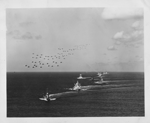 | 1.31k | Between 9 & 13 September 1940 the Arizona (BB-39) was under way with other ships of the US Fleet for simulated fleet engagement. She is pictured here in company with other ships of the Pacific Fleet taken during Fleet Ops. and at least one carrier air group. | US Navy and Marine Corps Museum/Naval Aviation Museum, Photo No. 2008.104.001.235 courtesy of Alan Moore. Text & photo i.d. courtesy of Alan Moore via Battleship Arizona: An Illustrated History by Paul Stillwell, Annapolis, MD: Naval Institute Press, 1991. | ||||||||||||||||||||||||||||||||||||||||||||||||||||||||||||||||||||||||||||||||||||||||||||||||||||||||||||||||||||||||||||||||||||||||||||||||||||||||||||||||||||||||||||||||||||||||||||||||||||||||||||||||||||||||||||||||||||||||||||||||||||||||||||||||||||||||||||||||||||||||||||||||||||||||||||||||||||||||||||||||||||||||||||||||||||||||||||||||||||||||||||||||||||||||||||||||||||||||||||||||||||||||||||||||||||||||||||||||||||||||||||||||||||||||||||||||||||||||||||||||||||||||||||||||||||||||||||||||||||||||||||||||||||||||||||||||||||||||||||||||||||||||||||||||||||||||||
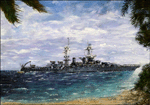 |
271k | Oil on canvas painting by the artist Wayne Scarpaci entitled Ready For War, showing the California (BB-44) in November 1941. | Painting courtesy of artbywayne.com | ||||||||||||||||||||||||||||||||||||||||||||||||||||||||||||||||||||||||||||||||||||||||||||||||||||||||||||||||||||||||||||||||||||||||||||||||||||||||||||||||||||||||||||||||||||||||||||||||||||||||||||||||||||||||||||||||||||||||||||||||||||||||||||||||||||||||||||||||||||||||||||||||||||||||||||||||||||||||||||||||||||||||||||||||||||||||||||||||||||||||||||||||||||||||||||||||||||||||||||||||||||||||||||||||||||||||||||||||||||||||||||||||||||||||||||||||||||||||||||||||||||||||||||||||||||||||||||||||||||||||||||||||||||||||||||||||||||||||||||||||||||||||||||||||||||||||||
| Attack on Pearl Harbor |
|||||||||||||||||||||||||||||||||||||||||||||||||||||||||||||||||||||||||||||||||||||||||||||||||||||||||||||||||||||||||||||||||||||||||||||||||||||||||||||||||||||||||||||||||||||||||||||||||||||||||||||||||||||||||||||||||||||||||||||||||||||||||||||||||||||||||||||||||||||||||||||||||||||||||||||||||||||||||||||||||||||||||||||||||||||||||||||||||||||||||||||||||||||||||||||||||||||||||||||||||||||||||||||||||||||||||||||||||||||||||||||||||||||||||||||||||||||||||||||||||||||||||||||||||||||||||||||||||||||||||||||||||||||||||||||||||||||||||||||||||||||||||||||||||||||||||||||
 |
2.94k | Japanese Attack on Pearl Harbor, 7 December 1941. Imperial Japanese Navy aircraft carriers in dawn fly-off for Pearl Harbor. | Artwork by John Hamilton from his publication, "War at Sea," pg. 68-69. USN photo # 80-142-H, courtesy of the U.S. Navy Art Gallery from the National Museum of the U.S. Navy, courtesy of flickr.com. 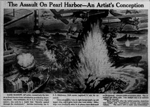 014325 NR |
The Assault On Pearl Harbor—An Artist's Conception |
HANK BARROW, AP artist, reconstructs the battle at Pearl Harbor from information provided by Secretary Knox. One battleship, the Arizona (BB-39), (right center), was sunk by a bomb that "literally passed through the smokestack." Another battleship, the Oklahoma (BB-37), (left center,capsized. It can be repaired. Three destroyers (one in right foreground), an old target ship, and a mine layer also went down. Other ships were damaged, many U. S. planes were destroyed on the ground. Almost 2,900 servicemen died The attackers lost three subs (one midget sub is at extreme right) & 41 aircraft. Knox said that after the initial surprise, American men fought with "magnificent courage and resourcefulness. The men's will to resist was tremendous... Image and text provided by University of Florida. | Photo from The Key West Citizen. [volume] (Key West, Fla.) 1879-current, 22 December 1941, Image 1, via chroniclingamerica.loc.gov. 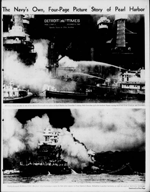 014316s 2.14k |
The Navy's Own, Four-Page Picture Story of Pearl Harbor |
Old Glory flying proudly in one of her darkest hours and over sailors at Pearl Harbor last 7 December risking their lives close up to the bomb-set flames roaring from both West Virginia (BB-48) and Tennessee (BB-43). Slightly-damaged 31,000-ton Maryland (BB-46) (first battleship to rejoin the fleet after repairs) in Pearl Harbor's flames. Behind her is another battleship, at right the capsized battleship Oklahoma (BB-37). Image and text provided by Central Michigan University, Clark Historical Library. | Photo from Detroit Evening Times. (Detroit, Mich) 1921-1958, 06 December 1942, FINAL, Images 21, 22, 23, & 24, via chroniclingamerica.loc.gov.  1.67k |
Battleship row in flames. |
Artwork by John Hamilton from his publication, "War at Sea," pg. 74-75. | USN photo # 80-142-I, courtesy of the U.S. Navy Art Gallery from the National Museum of the U.S. Navy, courtesy of flickr.com. 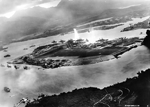 399k |
Photograph taken from a Japanese plane during the torpedo attack on ships moored on both sides of Ford Island shortly after the beginning of the Pearl Harbor attack. View looks about east, with the supply depot, submarine base and fuel tank farm in the right center distance. A torpedo has just hit West Virginia (BB-48) on the far side of Ford Island (center). Other battleships moored nearby are (from left): Nevada (BB-36), Arizona (BB-39), Tennessee (BB-43) (inboard of West Virginia), Oklahoma (BB-37) (torpedoed and listing) alongside Maryland (BB-46), and California (BB-44). On the near side of Ford Island, to the left, are light cruisers Detroit (CL-8) and Raleigh (CL-7), target and training ship Utah (BB-31) and seaplane tender Tangier (AV-8). Raleigh and Utah have been torpedoed, and Utah is listing sharply to port. Japanese planes are visible in the right center (over Ford Island) and over the Navy Yard at right. U.S. Navy planes on the seaplane ramp are on fire. Japanese writing in the lower right states that the photograph was reproduced by authorization of the Navy Ministry. |
Text courtesy of wikipedia.com. | Official USN photograph NH 50930. 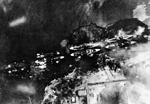 3.95k |
Vertical aerial view of "Battleship Row", beside Ford Island, during the early part of the horizontal bombing attack on the ships moored there. Photographed from a Japanese aircraft. Ships seen are (from left to right): Nevada (BB-36), Arizona (BB-39) with Vestal (AR-4) moored outboard; Tennessee (BB-43) with West Virginia (BB-48) moored outboard; Maryland (BB-46) with Oklahoma (BB-37) moored outboard; and Neosho (AO-23), only partially visible at the extreme right. A bomb has just hit Arizona near the stern, but she has not yet received the bomb that detonated her forward magazines. West Virginia and Oklahoma are gushing oil from their many torpedo hits and are listing to port. Oklahoma's port deck edge is already under water. Nevada has also been torpedoed. |
Japanese inscription in lower left states that the photograph has been officially released by the Navy Ministry. Also at NHHC as NH 50472. From the translated Japanese caption, "Alas, the spectacle of the American battleship Fleet in its Dying Gasp. The attack of our assault force was extremely accurate and achieved direct hits with all bombs. The leading ship of the Oklahoma Class is already half sunk. The Maryland type and the Pennsylvania type are blowing up from several direct hits. The ships crumble and their hulls are twisted and keeling over. Crude oil gushes forth fearfully. This view of the wretched enemy's capital ships which were converted into a sea hell was photographed from directly overhead by the heroes of our calm, valorous attack force." USN photo # 80-G-30551, courtesy of the National Museum of the U.S. Navy, via flickr.com.
| 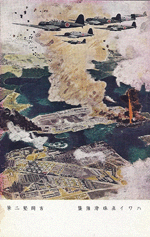 1.01k |
Japanese post card of bombers over Pearl Harbor, 7 December 1941. |
Photo courtesy of Arnold Putnam.
| 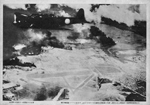 3.24k |
Japanese attack on Pearl Harbor - Hickam Field. |
Photo courtesy of Arnold Putnam.
| 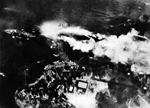 3.52k | Vertical aerial view of "Battleship Row", beside Ford Island, soon after Arizona (BB-39) was hit by bombs and her forward magazines exploded. Photographed from a Japanese aircraft. Ships seen are (from left to right): Nevada (BB-36); Arizona (burning intensely) with Vestal (AR-4) moored outboard; Tennessee (BB-43) with West Virginia (BB-48) moored outboard; and Maryland (BB-46) with Oklahoma (BB-37) capsized alongside. Smoke from bomb hits on Vestal and West Virginia is also visible. |
Japanese inscription in lower left states that the photograph has been reproduced under Navy Ministry authorization. Also at NHHC as NH 30552. Translated Japanese caption reads, "Capsizing, Sinking, Burning, the anchorage of the American capital ships is changed to a scene of carnage. In rapid succession, the enemy war vessels were set ablaze by the violent bombing attacks which followed the torpedo attacks. The special service ship in the capital ship anchorage has already been sunk. The violent smoke from the exploding powder magazine is rising from a vessel of the Oklahoma Class alongside. A Pennsylvania class ship, capsized and sinking, shows its bottom. Two ships the California class and the Maryland class are in flames from direct bomb hits. In the upper right-hand part of the photograph are what appear to be several rescue ships, darting right and left. USN photo # 80-G-30552, courtesy of the National Museum of the U.S. Navy, via flickr.com.
|  912k | Oil on canvas painting by the artist Anthony Saunders entitled Pearl Harbor, California (BB-44).
At dawn on the 7th December 1941, 350 Japanese warplanes flew from their carriers and attacked the US pacific fleet at Pearl harbor, on the Hawaiian island of Oahu. the attack concentrated on "Battleship Row" which included California (Left) and Nevada (BB-36) (Right) which was the only battleship to get underway during the attack. However coming under intense bomb attack she was later beached. For the Japanese the success was not total. as the US carrier fleet was out on manoeuvres on the day of the attack.
| Text and drawing courtesy of naval-art.com | 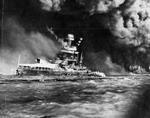 1.41k | Crew abandoning the damaged California (BB-44) as burning oil drifts down on the ship. | USN photo courtesy of Scott Koen & ussnewyork.com.
|
|
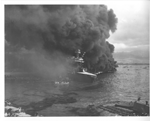 014432 5.63k | Crew abandoning the damaged California (BB-44) as burning oil drifts down on the ship, at about 1000 hrs on the morning of 7 December 1941, shortly after the end of the Japanese raid. The capsized hull of Oklahoma (BB-37) is visible at the right. | National Archives Identifier: 12009031. | Photo courtesy of catalog.archives.gov, via Daniel Hacker. 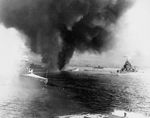 1.22k | California (BB-44) left, being abandoned by her crew, Oklahoma (BB-37) (Center). The larger ship (at right) is St. Louis (CL-49) (note the twin 5"/38 mountings). Smaller one (in distance, between Oklahoma & St. Louis) is a single-stack destroyer. | Photo i.d. courtesy of Chuck Haberlein. |
Photo courtesy of Scott Koen & ussnewyork.com. 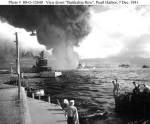 97k | View looking down "Battleship Row" from Ford Island Naval Air Station,shortly after the Japanese torpedo plane attack. California (BB-44) is at left, listing to port after receiving two torpedo hits. In the center are Maryland (BB-46) with the capsized Oklahoma (BB-37) alongside. Neosho (AO-23) is at right, backing clear of the area. Most smoke is from Arizona (BB-39). | Submitted by Scott Dyben. |
Official USN photo Naval History and Heritage Command # 80-G-32640, from the collections of the Naval Historical Center. 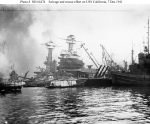 101k | Tugs and other ships trying to keep California (BB-44) afloat, soon after the Japanese torpedoed and bombed her at Pearl Harbor, 7 December 1941. | Official USN photo Naval History and Heritage Command # NH 64474, from the collections of the Naval Historical Center. |
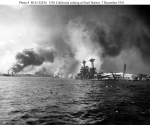 95k | California (BB-44) slowly sinking alongside Ford Island as a result of bomb and torpedo damage, 7 December 1941. Shaw (DD-373) is burning in the floating dry dock YFD-2 in the left distance. Nevada (BB-36) is beached in the left-center distance. | Official USN photo Naval History and Heritage Command # 80-G-32456, now in the collections of the National Archives. |
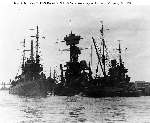 95k | View of California (BB-44), taken a day or two after the Japanese raid. Bobolink (AM-20), at left, Vireo (AM-52) and YW-10 are off the battleship's stern, assisting with efforts to keep her afloat. | Note the caption reads West Virginia (BB-48) instead of California. U.S. Naval Historical Center Photograph # NH 95569. Collection of Vice Admiral Homer N. Wallin, USN (Retired), 1975. |
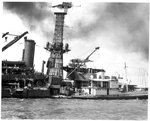 765k | View of sailors on board the battleship California (BB-44) following the Japanese attack on Pearl Harbor, 1941. | Photo courtesy of the National Naval Aviation Museum via Bill Gonyo. | 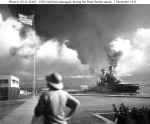 79k | Scene on the southeastern part of Ford Island, looking northeasterly, with California (BB-44) in right center, listing to port after being hit by Japanese aerial torpedoes and bombs. | Official USN photo Naval History and Heritage Command # 80-G-32463, now in the collections of the National Archives. |
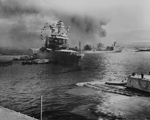 889k | Neosho (AO-23), cautiously backs away from her berth (right center) in a successful effort to escape the Japanese attack on Pearl Harbor, 7 December 1941. At left the battleship California (BB-44) lists after aerial blows. Other crippled warships and part of the hull of the capsized Oklahoma (BB-37) may be seen in the background. | USN photo , available from the United States Library of Congress's Prints and Photographs division under the digital ID fsa.8e01821, courtesy of Robert Hurst via Gary Priolo. |
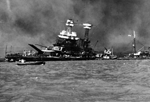 1.13k |
California (BB-44) after the attack. |
USN photo # 80-G-32740, courtesy of the U.S. Navy Art Gallery from the National Museum of the U.S. Navy, courtesy of flickr.com.
|  1.00k | The national ensign waves from the stern view of the California (BB-44) listing to her port side enveloped. Most of the smoke rising off her bow is from the wreck of the Arizona (BB-39). | USN photo courtesy of Richard Leonhardt, (USN retired). |
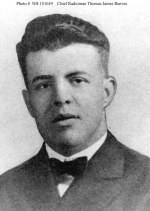 95k | Chief Radioman Thomas James Reeves, USN, who was awarded the Medal of Honor, posthumously, for heroism while serving on board California (BB-44) during the 7 December 1941 Japanese raid on Pearl Harbor. Halftone reproduction, copied from the official publication "Medal of Honor, 1861-1948, The Navy", page 248. |
Naval History and Heritage Command # NH 101649 |  95k | Surrounded by boats and yard craft, the California (BB-44) struggles to stay afloat. She remained afloat for three days before being allowed to settle into the muddy bottom. |
USN photo. | 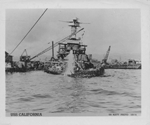 649k | The California (BB-44) resting on the bottom on an even keel. | USN official photo # 100-14, courtesy of the USS California Association via Tommy Trampp. |  132k | Port broadside view of the California (BB-44) on the bottom. The scarred and blistered paint at the waterline is probably where she was struck by a torpedo. | USN photo. | Salvage & Repair |
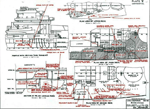 833k |
California (BB-44) bomb damage diagram from 7 December, 1941 at Pearl Harbor. |
Source: United States Navy Department Bureau of Ships via Mike Green.
|
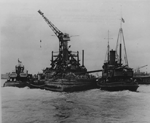 457k | California (BB-44) is shown being towed to dry dock at Pearl Harbor T.H. This ship was raised from her shallow resting place by means of cofferdams. | Photo 66-316(5) courtesy of fdrlibrary.marist.edu |
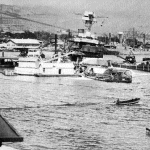 136k | Bow on view of the California (BB-44) undergoing salvage. Her cage mainmast and all six 14" forward guns were removed to facilitate her refloating. | USN photo. |  128k | Close up of the California (BB-44) resting on the bottom undergoing salvage. She still has her gun barrels and mainmast in place so this is probably at the start of the salvage operations. | USN photo. | 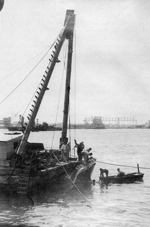 164k | The patch on the port bow of the California (BB-44) goes into the water on 25 January 1942. In the background is the rebuilt Shaw DD-373), waiting to enter the floating dry dock the next day. Also visible is the mast of the Raleigh (CL-7) in Dry Dock 1 and the Saratoga (CV-3), undergoing torpedo damage repair in Dry Dock 2. | Photo from the book "Resurrection-Salvaging the Battle Fleet at Pearl Harbor", by Dan Madsen, courtesy of Mike Green. | 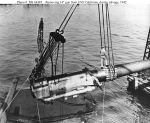 118k | Removal of one of the sunken battleship's 14"/50 guns from turret # 3, circa early February 1942. View looks aft, with the ship's fantail aircraft crane in the left middle distance. | Official USN photo Naval History and Heritage Command # NH 64487, from the collections of the Naval Historical Center. |
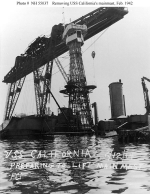 122k | Preparing to lift the sunken battleship's "basket" mainmast, using a large floating crane, while she was under salvage at Pearl Harbor on 12 February 1942. | Official USN photo Naval History and Heritage Command # NH 55037, from the collections of the Naval Historical Center. |
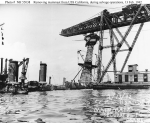 117k | Floating crane removes the sunken battleship's "basket" mainmast, while she was under salvage at Pearl Harbor on 13 February 1942. | Official USN photo Naval History and Heritage Command # NH 55038, from the collections of the Naval Historical Center. |
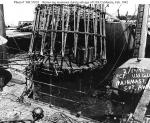 165k | The sunken battleship's "basket" mainmast is lifted free after it had been cut away during salvage operations at Pearl Harbor, 13 February 1942. | Official USN photo Naval History and Heritage Command # NH 55035, from the collections of the Naval Historical Center. |
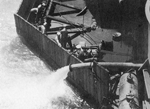 219k | 27 February 1942 photo of the unwatering of the forecastle of the California (BB-44). Sandbags are used to help counteract the buoyancy of the wood shoring. | Photo from the book "Resurrection-Salvaging the Battle Fleet at Pearl Harbor", by Dan Madsen, courtesy of Mike Green. |  114k | 10 March 1942 photo of #3 turret, with guns removed and covered in canvas. Cofferdam shoring is visible in this photo.
| Photo from the book "Resurrection-Salvaging the Battle Fleet at
Pearl Harbor", by Dan Madsen, courtesy of Mike Green. | 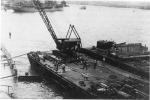 108k | 10 March 1942 photo of the construction of California's (BB-44) port-side quarter deck cofferdam. Divers are bolting the latest section to the ship, while Pacific Bridge carpenters begin shoring it to the ship's superstructure.
| Photo from the book "Resurrection-Salvaging the Battle Fleet at
Pearl Harbor", by Dan Madsen, courtesy of Mike Green. | 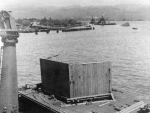 134k | 10 March 1942 photo with the remnants of Battleship Row lying in the distance, the stern section of the California's (BB-44)cofferdam sits on a barge waiting placement in front of the stern crane.
| Photo from the book "Resurrection-Salvaging the Battle Fleet at
Pearl Harbor", by Dan Madsen, courtesy of Mike Green. | 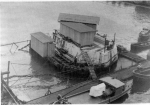 105k | The forward quay of the California's (BB-44) F-3 anchorage is seen with shower and restroom facilities mounted atop and around it. Securing anchor chains still hold the ship in place and a causeway, leading to salvage crew living quarters is in the foreground.
| Photo from the book "Resurrection-Salvaging the Battle Fleet at
Pearl Harbor", by Dan Madsen, courtesy of Mike Green. | 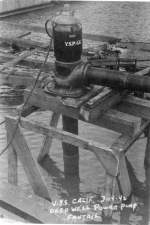 93k | Sitting atop scaffolding erected on the California's (BB-44) fantail, a Pomona deep-well power pump is seen pumping out the battleship's lower decks. Photo taken on 14 March 1942.
| Photo from the book "Resurrection-Salvaging the Battle Fleet at
Pearl Harbor", by Dan Madsen, courtesy of Mike Green. | 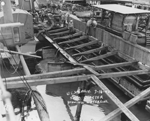 179k | Unwatering the cofferdam (1.1 inch Tub). Photograph taken 16 March 1942. | Photo Source: NARA San Francisco, Pearl Harbor Navy Yard General Correspondence files 1941-45. | Photo courtesy of Tracy White @ Researcher @ Large. 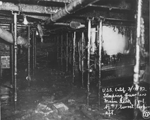 114k | The California's (BB-44) port-side main deck berthing area as seen on 19 March 1942 as the ship was re-floated. In addition to the debris cleanup, body retrieval began two days later, as the crews continued in their efforts.
| Text from "Resurrection-Salvaging the Battle Fleet at
Pearl Harbor", written by Dan Madsen. | Source: San Francisco NARA, Pearl Harbor Navy Yard General Correspondence 1941-45 Photo courtesy of Tracy White @ Researcher @ Large. 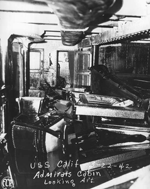 123k | Admiral's cabin looking aft as seen on 22 March 1942.
| Source: San Francisco NARA, Pearl Harbor Navy Yard General Correspondence 1941-45. | Photo courtesy of Tracy White @ Researcher @ Large. 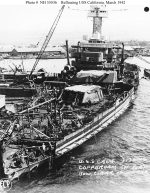 156k | Re-floating operations, while the ship was under salvage at Pearl Harbor on 30 March 1942. Note cofferdam installed along her port bow and forward turrets with guns removed. | Official USN photo Naval History and Heritage Command # NH 55036, from the collections of the Naval Historical Center. |
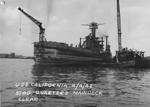 128k | The California (BB-44) comes up: - the oil line on the fence-type cofferdam around her quarterdeck shows how deep the wreck was submerged. Photograph taken 4 April 1942. | Photo Source: NARA San Francisco, Pearl Harbor Navy Yard General Correspondence files 1941-45. | Photo courtesy of Tracy White @ Researcher @ Large. 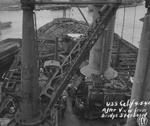 123k | The California (BB-44) aft cofferdam after unwatering. Photograph taken 4 April 1942. | Photo Source: NARA San Francisco, Pearl Harbor Navy Yard General Correspondence files 1941-45. | Photo courtesy of Tracy White @ Researcher @ Large. 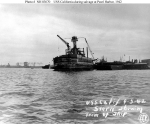 103k | View from astern after the ship had been refloated, showing the ship's slight trim to port and the extensive wooden cofferdam erected around her quarterdeck, 5 April 1942. Lexington (CV-2) is visible in the left distance, drydocked at the Pearl Harbor Navy Yard. | Official USN photo Naval History and Heritage Command # NH 83070, from the collections of the Naval Historical Center. |
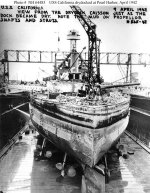 95k | California (BB-44) just after she was placed in the Pearl Harbor Navy Yard's Drydock Number Two, 9 April 1942. California had been sunk as a result of the 7 December 1941 Japanese air raid and was refloated on 24 March 1942. Note the mud on the ship's propeller shafts and struts and on the drydock floor below them. | Official USN photo Naval History and Heritage Command # NH 64483, from the collections of the Naval Historical Center. |
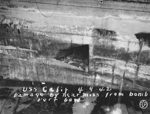 109k | Damage from a near miss on the bow. Photograph taken 9 April 1942. | Photo Source: NARA San Francisco, Pearl Harbor Navy Yard General Correspondence files 1941-45. | Photo courtesy of Tracy White @ Researcher @ Large. 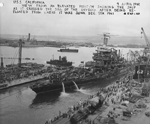 172k | View from an elevated position showing the California (BB-44) as it crossed the sill of the drydock after being refloated. Photograph taken 9 April 1942. | Photo Source: NARA San Francisco, Pearl Harbor Navy Yard General Correspondence files 1941-45. | Photo courtesy of Tracy White @ Researcher @ Large. 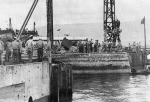 148k | 9 April 1942 photo of the California's (BB-44) stern crossing the sill of Dry-dock #2, four months after she settled to the bottom of Pearl Harbor.
| Photo from the book "Resurrection-Salvaging the Battle Fleet at
Pearl Harbor", by Dan Madsen, courtesy of Mike Green. | 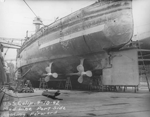 95k | Mud Line port side looking forward from the stern. Photograph taken 9 April 1942. | Photo Source: NARA San Francisco, Pearl Harbor Navy Yard General Correspondence files 1941-45. | Photo courtesy of Tracy White @ Researcher @ Large. 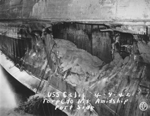 115k | Port Side Torpedo Damage. Photograph taken 9 April 1942. | Photo Source: NARA San Francisco, Pearl Harbor Navy Yard General Correspondence files 1941-45. | Photo courtesy of Tracy White @ Researcher @ Large. 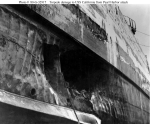 84k | Torpedo damage to the hull of California (BB-44), photographed at the Pearl Harbor Navy Yard in April 1942, soon after the ship had been drydocked for repairs. This is California's forward torpedo hole, centered at about Frame 52. Note armor belt at the top of the hole and bilge keel below it. | Official USN photo Naval History and Heritage Command # 80-G-32917, now in the collections of the National Archives. |
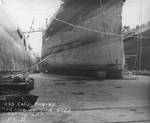 92k | Mud Line Bow. Photograph taken 10 April 1942. | Photo Source: NARA San Francisco, Pearl Harbor Navy Yard General Correspondence files 1941-45. | Photo courtesy of Tracy White @ Researcher @ Large. 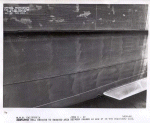 71k | Completed hull repairs to damaged area between frames 49 - 57 on the starboard side. 6 June 1942. | Seattle NARA photo # 1603-42. Record Group 181, 13th Naval District, Records of the Naval District & Shore Establishments. |
Photo courtesy of Tracy White @ Researcher @ Large. 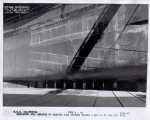 115k | Completed hull repairs to damaged area between frames 6 - 21 on the port side. 6 June 1942. | Seattle NARA photo # 1606-42. Record Group 181, 13th Naval District, Records of the Naval District & Shore Establishments. |
Photo courtesy of Tracy White @ Researcher @ Large. 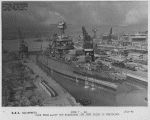 52k | California (BB-44), 7 June 1942, view from aloft off starboard bow, just prior to undocking. | Seattle NARA photo # 1614-42. Record Group 181, 13th Naval District, Records of the Naval District & Shore Establishments. |
Photo courtesy of Tracy White @ Researcher @ Large. 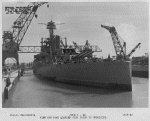 53k | California (BB-44), 7 June 1942, view of the off port quarter, just prior to undocking. | Seattle NARA photo # 1618-42. Record Group 181, 13th Naval District, Records of the Naval District & Shore Establishments. |
Photo courtesy of Tracy White @ Researcher @ Large. 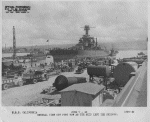 57k | 7 June 1942, general view off port bow, as the California (BB-44) left the drydock. | Seattle NARA photo # 1620-42. Record Group 181, 13th Naval District, Records of the Naval District & Shore Establishments. |
Photo courtesy of Tracy White @ Researcher @ Large. 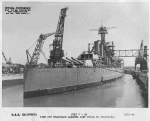 47k | 7 June 1942, View off starboard quarter just prior to undocking. | Seattle NARA photo # 1610-42. Record Group 181, 13th Naval District, Records of the Naval District & Shore Establishments. |
Photo courtesy of Tracy White @ Researcher @ Large. 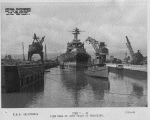 45k | 7 June 1942, View head on just prior to undocking. | Seattle NARA photo # 1615-42. Record Group 181, 13th Naval District, Records of the Naval District & Shore Establishments. |
Photo courtesy of Tracy White @ Researcher @ Large. 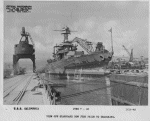 51k | 7 June 1942, View off starboard bow just prior to undocking. | Seattle NARA photo # 1616-42. Record Group 181, 13th Naval District, Records of the Naval District & Shore Establishments. |
Photo courtesy of Tracy White @ Researcher @ Large. 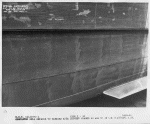 57k | 9 June 1942, completed hull repairs to damaged area between frames # 49 - 57 on the starboard side. | Seattle NARA photo # 1603-42. Record Group 181, 13th Naval District, Records of the Naval District & Shore Establishments. |
Photo courtesy of Tracy White @ Researcher @ Large. 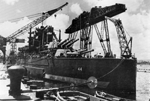 569k | Taken at Pearl Harbor Navy Yard, circa mid-1942. The fact that 14" guns are installed, and the general condition of the ship, indicates to me that it was taken fairly late in the initial repair period ... probably in September or early October 1942. | Photo i.d. & text courtesy of Chris Hoen & Chuck Haberlein. | USN photo courtesy of Scott Koen & ussnewyork.com. 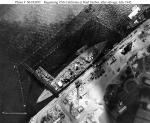 154k | At the Pearl Harbor Navy Yard, 18 July 1942, during re-installation of her 14"/50 main battery guns. A large floating crane is alongside her starboard bow, placing a gun in Turret # 1. Guns are also visible in Turret # 3, whose top has not yet been put in place. Note anti-torpedo nets protecting the ship. | Official USN photo Naval History and Heritage Command # NH 83997, from the collections of the Naval Historical Center. |
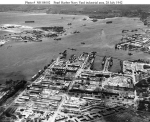 106k | Pearl Harbor, Oahu, Territory of Hawaii view looking northward, with the Navy Yard industrial area in the foreground and the Marine Barracks in the lower right, 28 July 1942. Ford Island is at left, with Oklahoma (BB-37) and Arizona (BB-39) under salvage nearby. San Diego (CL-53) is in the upper center. | West Virginia (BB-48) is in Drydock Number One, in the lower left, and California (BB-44) is alongside the wharf at the extreme right. Cruisers alongside the pier in right center are Northampton (CA-26) (left) and Pensacola (CA-24). Submarines alongside 1010 Dock, just beyond Drydock # 1, are Trout (SS-202), Pollack (SS-180), Dolphin (SS-169) and Cachalot (SS-170). Note camouflage on many of the Navy Yard's buildings. Courtesy of the Naval Historical Foundation. Collection of The Honorable James V. Forrestal. |
Official USN photo NH 84002, from the collections of the Naval Historical Center.  116k | Drawing prepared by the Bureau of Ships for Camouflage Measure 32, Design 16D intended for battleships of the Tennessee class (BB-43 /44) . | This plan, dated 20 December 1943, shows the ship's starboard side, superstructure ends and exposed decks. It was approved by Captain Henry A. Ingram, USN. California (BB-44) is known to have worn this camouflage design. Official USN photo # 80-G-162038, now in the collections of the National Archives. |
 77k | Drawing prepared by the Bureau of Ships for Camouflage Measure 32, Design 16D intended for battleships of the Tennessee class (BB-43 /44) . | This plan, dated 20 December 1943, shows the ship's port side. It was approved by Captain Henry A. Ingram, USN. California (BB-44) is known to have worn this camouflage design. Official USN photo # 80-G-162039, now in the collections of the National Archives. |
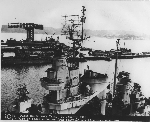 332k | View of California's (BB-44) radar antennas from elevated view of port bow while in Puget Sound Navy Yard, 10 January 1944. | USN photo & text courtesy of Pieter Bakels. | 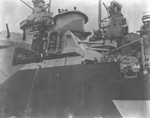 865k | California's (BB-44) new 5". | USN photo courtesy of Scott Koen & ussnewyork.com.
| 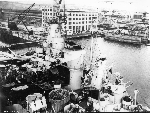 367k | View of California's (BB-44) radar antennas in Puget Sound Navy Yard, 10 January 1944. | USN photo & text courtesy of Pieter Bakels. | 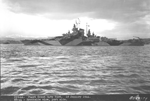 513k | Series of 6 photos taken from various angles at Puget Sound, 18 January 1944 wearing measure 32/16D camouflage. Broadside view, port side. | Bureau of Ships photo # 59019 courtesy of David Buell.
| 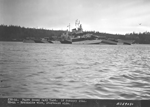 418k | Broadside view, starboard side. | Bureau of Ships photos # 59080 courtesy of David Buell.
| 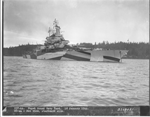 544k | Bow view, starboard side. | Bureau of Ships photos # 64081 courtesy of David Buell. | 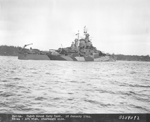 401k | Aft view, starboard side. | Bureau of Ships photos # 59082 courtesy of David Buell. | 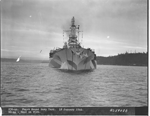 593k | Head on view. | Bureau of Ships photos # 59083 courtesy of David Buell. | 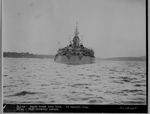 401k | View directly astern. | Bureau of Ships photos # 59084 courtesy of David Buell. | 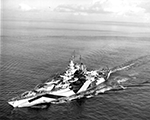 794k | California (BB-44) taken on 25 January 1944 after her overhaul at Puget Sound Navy Yard. | USN photo # 80-G-211931 TH from the files of the Vallejo Naval & Historical Museum via Darryl L. Baker. | 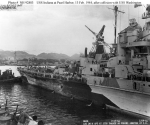 68k | Indiana (BB-58) at Pearl Harbor on 13 February 1944, showing damage to her starboard side received in collision with Washington (BB-56) on 1 February 1944. Tug YT-471 is assisting. Note the "cage" mast mounted ashore in the left distance. It was removed from California (BB-44) while she was being salvaged following the 7 December 1941 Japanese attack on Pearl Harbor.
| Official USN photo Naval History and Heritage Command # NH 92883, from the collections of the Naval Historical Center. |  144k | Close up of the damage from her collision with her sister Tennessee (BB-43). On 24 August 1944, she arrived at Espiritu Santo for repairs to her port bow damaged in a collision with Tennessee. | USN photo. | 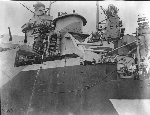 274k | August 1944-Damage. | USN photo & text courtesy of Pieter Bakels. |  392k | Photo taken 8 September 1944 as repairs to the ship near completion. Scaffolding along the port side of the ship shows the damaged area. The ship is docked in Floating Dry-dock ABSD-1 at Espiritu Santo. | USN photo submitted by Pieter Bakels. |
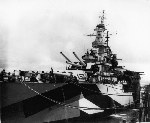 245k | California (BB-44) in September 1944 with a relatively simple electronic suite. | USN photo & text courtesy of Pieter Bakels. |  1.19k | A class act: Tennessee (BB-43) & California (BB-44). | Official USN photo courtesy The Ships and Aircraft of the United States Fleet by Admiral James C. Fahey, courtesy of Tommy Trampp.
|  114k | A line drawing by A.L. Raven of the California (BB-44) in 1945. | USN photo. |
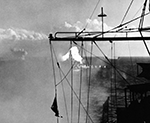 508k | California (BB-44) is hit by a Japanese Nakajima J1N bomber, Irving in a suicide crash in the Gulf. Photographed by Pennsylvania (BB-38), released: 6 January 1945. | Official USN photograph # 80-G-273028 courtesy of National Museum of the U.S. Navy via flickr.com.
| 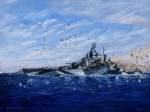 43k | The California (BB-44) undergoing a kamikaze attack on 6 January 1945. | Painting courtesy of artbywayne.com
|  30k | Damage from a kamikaze attack on the California (BB-44), 6 January 1945. | Photo from WWII Damage Reports, courtesy of NavSea / dcfp.navy.mil. |
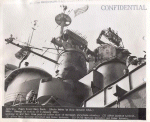 118k
| Puget Sound Navy Yard, (Photo taken by Ship, January 1945) Damaged in action of 6 January 1945. Looking up & forward, from port after side of Mainmast Structure showing: | 1, After Surface Lookout. 2, After Main Battery Director and Radar Antenna. 3, 5"/38 Battery Director & Radar Antenna. Seattle NARA photo # 1494-45. Record Group 181, 13th Naval District,
Records of the Naval District & Shore Establishments, Photo courtesy of Tracy White @ Researcher @ Large. |
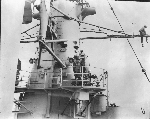 234k
| Puget Sound Navy Yard, (Photo taken by Ship, January 1945) Damaged in action of 6 January 1945. Looking up & aft at forward side of Mainmast Structure. | Seattle NARA photo # 1499-45. Record Group 181, 13th Naval District,
Records of the Naval District & Shore Establishments, courtesy of Tracy White & Pieter Bakels.
|
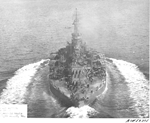 711k | Stern view at 20 knots, taken at Puget Sound Navy Yard 20 April 1945.
| USN photo , BuShips # 83308, courtesy of David Buell. |
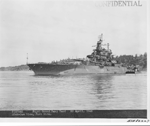 585k | Taken at Puget Sound Navy Yard 28 April 1945. Note that the California's (BB-44)
union jack and national ensign are at half-staff for the recent death of President Franklin D. Roosevelt.
| USN photo , BuShips # 82227 courtesy of David Buell. |
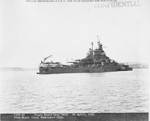 545k | Stern view, starboard side taken at Puget Sound Navy Yard 28 April 1945. The barge alongside is YC-800. | The YC "Open Lighter" is a non-self-propelled steel barge designed to transport cargo in rivers, harbors or other protected waters. The craft is divided into watertight compartments. Access to these compartments is through manholes. USN photo , BuShips # 2106-45, courtesy of David Buell. | Barge text courtesy of peoships.crane.navy. 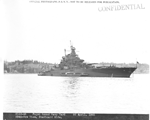 351k | Bow view, starboard side taken at Puget Sound Navy Yard 28 April 1945. Note that the California's (BB-44) union jack and national ensign are at half-staff for the recent death of President Franklin D. Roosevelt.
| USN photo , BuShips # 2113-45, courtesy of David Buell. |  82k | Pearl Harbor Veterans, the California (BB-44) Tennessee (BB-43) and Nevada (BB-36) steam out of Buckner Bay, Okinawa on 17 July 1945. All had been sunk or damaged during the attack on Pearl Harbor. | USN photo. | 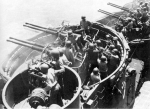 83k | Dated 29 July 1945. Close up of two quad 40mm Bofors mounts with their Mk.51 director visible in the foreground. | USN photo. |
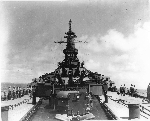 361k | August 1945. Note AS-56 on both yardarms and IR beacons, skipole IFF antennas on both sides of the foretop and fighting lights left and right of the Mk.8 radar. | USN photo & text courtesy of Pieter Bakels. | 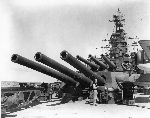 367k | August 1945. Note SC-1 Seahawk, the SP fighter control set atop her mainmast, the TBS on the yardarms and the Nancy infrared beacons. Also note the Mk.34 antenna for GFCS. Mk.57 in front of her #4 Mk.37 director. | USN photo & text courtesy of Pieter Bakels. | 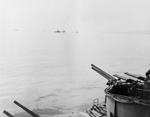 769k | 40mm gun crew on California (BB-44), with the Maryland (BB-46) & West Virginia (BB-48) in the distant background. | USN photo # USN N-3180 courtesy of Scott Koen & ussnewyork.com.
| Post War / Scrapping |
 18k | Post card dated 25 October 1945; "Homeward Bound. Because of the "Blisters" added to our sides during refitting after Pearl Harbor, we can't navigate the Canal, so we are on a different course. Arrived at Singapore today." | Courtesy of Richard Leonhardt. |
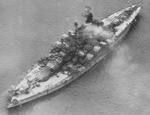 452k | Dated 7 December 1945 as California (BB-44) arrives in Philadelphia for layup.
| AP Wirephoto courtesy of David Buell. |
 97k | A post card of the California (BB-44) from the Mare Island Fighting Ships series, 1946. | Photo courtesy of Darryl L. Baker. |
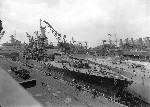 667k | Photo taken from Bldg. 620 of Drydock # 5 at Philadelphia Naval Shipyard. | The Tennessee (BB-43) in the foreground and the fore section of the California (BB-44) outboard at the Philadelphia Naval Shipyard sometime after 8 May 1946. Note that they are both still flying their ensigns and jacks, so both are still in commission. The South Dakota (BB-57) is in the left background. Across the pier past the California are two 4-stack cruisers of the Omaha class. Stripping is apparently underway on the CLs, with at least one smokestack (on the nearest -- inboard -- ship) removed. Some of the stacks on the outboard ship are hidden behind those of the inboard ship. It appears that the cruisers might be painted in measure MS-21 camouflage, but only two appear to have ended the war in this pattern: Detroit (CL-8) and Trenton (CL-11). Seven of these cruisers were decommissioned and sold for scrap at the Phila. Navy Yard: (1) Omaha (CL-4) scrapped beginning 2/46. (MS-22) dated 1945. (2) Cincinnati (CL-6) scrapping beginning 2/27/46. (MS-22) dated 1945. (3) Raleigh (CL-7) scrapping beginning 2/27/46. (MS32/1D) dated 1944. (4) Detroit scrapping beginning 2/27/46. (MS22 & MS21) dated 1945. (5) Concord (CL-10) scrapping beginning 2/27/47. (MS33/2F) dated 1944. (6) Trenton (CL-11) scrapping beginning 12/29/46. (MS21) dated 1945. (7) Marblehead (CL-12) scrapping beginning 2/27/46.(MS22) dated 1945. It is possible that the outboard cruiser (further from the camera) may not be in measure 21. The stack appears a bit lighter and that would mean cruisers in measure 22 would also have to be included. Note that #4 stack of the outboard cruiser is obscured by #3 of the inboard ship (which also looks a little bit lighter?). In any case both Richmond (CL-9) and Memphis (CL-13) would also have to be considered. This is especially true since Richmond was in MS 21 in late 1945. Also in the background is the former Olympia (ex-C-6) (IX-40). Notice the flatcar going to the storage yards on other side of the lift bridge to Bldg. 750. It is full of single barrel 20mm A.A. mounts is in the foreground on the train/trolley tracks. USN photo courtesy of Pieter Bakels. Partial text and photo i.d. and a lot of homework courtesy of Mike Green, Aryeh Wetterhorn, Chuck Haberlein, Tracy White @ Researcher @ Large. & Joe Lewis & Ron Reeves (of blessed memory), (HTC) USNR (ret.) |
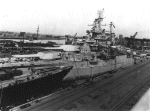 330k | California (BB-44) in the foreground and the fore section of the Tennessee (BB-43) outboard at the Philadelphia Naval Shipyard sometime after 8 May 1946. | USN photo courtesy of floatingdrydock.com. & submitted by David Buell. Photo i.d. courtesy of Joe Lewis. |
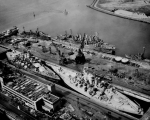 102k | Battleships in dry-dock; Tennessee (BB-43) & California (BB-44) taken between 8 May and 27 October 1946. | This photo comes from the U.S.Naval Institute and has an accompanying photocopy identifying all of the surrounding ships. It does identify the two cruisers as Detroit (CL-8) (inboard) and Trenton (CL-11)(outboard). It also identifies two returned U.K. DEs: HMS Rupert (DE-96) outboard of Olympia (ex-C-6) (IX-40), and HMS Berry (DE-3) ahead of the cruisers, and visible in the California's photo (it's still wearing its British hull #--K312). The Naval Institute photo was taken at a later date, as more of the "packaging" on the two battleships had been completed. According to Tennessee's deck logs, she entered Drydock #5 with California on 8 May 1946. South Dakota (BB-57) (mid-stern section visible at upper left of photo) subsequently entered Drydock #4--the 1946 "Navy Day" program from the shipyard indicates that this had taken place by 27th October of that year. The four CLs that were scrapped in Drydock #4 at the Philadelphia NSY were: Omaha (CL-4), Cincinnati (CL-6), Raleigh (CL-7) and Marblehead (CL-12). I have two documents from the 4th Naval District, and of course they give different completion dates for the scrapping of these ships. The first document (dated 1 Apr 46) indicates that scrapping was completed on 27 February of that year; the second document (also dated 1 April 46) gives the completion date as 10 March 1946. (My notes also indicate that scrapping was completed at the yard on nine ex-destroyer types as of 29 March 46: Litchfield (DD-336), Pruitt (DD-347), Jouett (DD-396), Clark (DD-361), Balch (DD-363), Sampson(DD-394), Schley (DD-103), Stringham (DD-83) and Whipple (DD-217). The remaining CLs; Detroit (CL-8), Trenton (CL-11), Richmond (CL-9), Concord (CL-10) and Memphis (CL-13) were all sold to the Patapsco Scrap Co. of Baltimore. The sales bid (B-76-47AV T) was opened on 6 December 46; the five ships were sold for $336,140 (or $67,228 each), and custody of the ships was transferred to Patapsco between 27 December 46 and 21 January 47. Note also that the attached photo distinctly shows that both cruisers have all four funnels--I think it's an optical illusion that either of these had had any of them removed. The "light colored objects" in front of the two cruisers might "possibly" be barbettes from the Illinois (BB-65). According to drawings in the 1945 "Gun Mount and Turret Catalog", these two items appear to be about the same diameter as the barbettes for the two BBs' Tennessee & California; 14"/50 triple gun turrets; inside diameter 31 feet, from the same source -- outside diameter would have been about 33 feet. The Illinois barbettes would have an inside diameter about 37 1/4 feet, outside diameter rather over 39 feet. USN photo submitted by Joe Lewis, courtesy of U.S.Naval Institute. Majority text by Joe Lewis. |
Chuck Haberlein contributed to the (BB-65) i.d. with text. 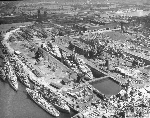 216k |
The US armed forces ship storage yard at Philadelphia, PA, 29 August 1946. |
The battleship South Dakota (BB-57) is in the foreground. The Tennessee (BB-43) is to the upper left and the California (BB-44) is to the lower right. Note also the two unidentified Light Cruisers of the Cleveland Class (CL-55 / 106); possibly Columbia (CL-56), Montpelier(CL-57) or Denver(CL-58) in Drydock # 4. Photographer: Sam Shere, courtesy of time.com. via / images.google.com & Life. | Photo i.d. courtesy of Ron Reeves (of blessed memory), (HTC) USNR (ret.) 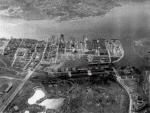 103k |
The Philadelphia Naval Shipyard in 1947. On the upper right side near the channel entrance, the mothballed battleships Tennessee (BB-43) and California (BB-44) are in a drydock.
|
USN photo courtesy of Joe MacDonald. |
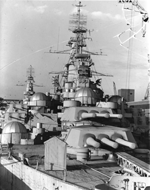 247k | The Tennessee (BB-43) & California (BB-44) at the Philadelphia Navy Base Shipyard, 1949. | USN photo courtesy of Scott Koen & ussnewyork.com. |
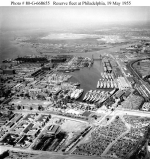 138k | Reserve Fleet Basin, Philadelphia Naval Shipyard, Pennsylvania. Photographed on 19 May 1955 with numerous cruisers, escort carriers, and auxiliaries in reserve. The nearest ship is the never-completed Hawaii (CB-3), which lacks its previously-installed three 12" gun turrets. | The cruisers outboard of Hawaii are (in unknown order) Honolulu (CL-48), Columbia (CL-56), Denver (CL-58), Galveston (CL-93), and Portsmouth (CL-102). To their left are Tranquility (AH-14), Sanctuary (AH-17), and Pocono (AGC-16). Behind Hawaii (from left to right) are Montpelier (CL-57), Houston (CL-81), Huntington (CL-107), Savannah (CL-42), Cleveland (CL-55), and Wilkes-Barre (CL-103). Beyond them (from left to right) are Wichita (CA-45), Oregon City (CA-122), Chester (CA-27), and New Orleans (CA-32). The cruisers on the left side of the basin (from front to rear) are Minneapolis (CA-36), Tuscaloosa (CA-37), San Francisco (CA-38), Augusta (CA-31), Louisville (CA-28), and Portland (CA-33). Among the other ships in reserve in the basin are Fomalhaut (AE-20), Webster (ARV-2), Albemarle (AV-5), Tangier (AV-8), Pocomoke (AV-9), Chandeleur (AV-10), Abatan (AW-4), Mission, San Carlos (AO-120), Prince William (CVE-31), Anzio (CVE-57), Block Island (CVE-106), Palau (CVE-122), and San Carlos (AVP-51). Moored in the shipyard at the extreme left are Tennessee (BB-43), California (BB-44), and Cabot (CVL-28). Official USN photo Naval History and Heritage Command # 80-G-668655, now in the collections of the National Archives. |
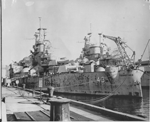 611k | On Inactive Duty: The Tennessee (BB-43) & California (BB-44), right background, two of the eight U.S. battleships bombed by the Japanese in their surprise attack on Pearl Harbor 15 years ago, ride quietly at anchor in the "mothball fleet" at the Philadelphia Navy Base Shipyard, 6 December 1956. | AP Wirephoto courtesy of David Buell. | 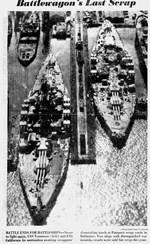 2.34k |
The Tennessee (BB-43)& California (BB-44) awaiting scrapping by Bethlehem Steel Co. 1959. |
Photo courtesy of The San Francisco Examiner 22 October 1959, via Joe MacDonald. |
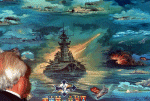 926k | A guest studies a painting depicting the history of battleships. The artwork was painted by George Skybeck and presented to the Pearl Harbor Survivors Association during their annual banquet at Honolulu, Hawaii, on 8 December 1991.
| USN photo # DN-SC-92-05391, by PHC Carolyn Harris, courtesy of dodmedia.osd.mil, Defense Visual Information Center. |
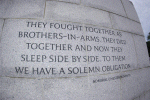 371k | A quote made by Fleet Adm. Chester W. Nimitz is inscribed on a granite wall at the National World War II Memorial located on the National Mall in Washington, D.C. Fleet Adm. Nimitz was the United States signatory to the surrender terms aboard the battleship Missouri (BB-63) in Tokyo Bay, Japan on 2 September 1945, thus ending World War II. Established by the American Battle Monuments Commission, the memorial honors all military veterans of World War II, the citizens on the home front, the nation at large, and the high moral purpose and idealism that motivated the nation's call to arms. On 29 May 2004, the memorial was formally dedicated with an estimated 200,000 people expected to attend, and includes 100,000 visiting veterans of all wars. | USN photo # N-0295M-011 by Photographer's Mate 2nd Class Daniel J. McLain, courtesy of news.navy.mil. | 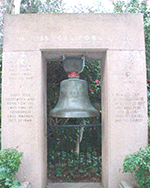 330k | California's (BB-44) bell on display at the California State Capitol Museum. Photo taken on 2 February 2006 by Isaac Crumm.
| Photo courtesy of Robert Hurst. | | ||||||||||||||||||||||||||||||||||||||||||||||||||||||||||||||||||||||||||||||||||||||||||||||||||||||||||||||||||||||||||||||||||||||||||||||||||||||||||||||||||||||||||||||||||||||||||||||||||||||||||||||||||||||||||||||||||||||||||||||
| Commanding Officers | ||
| 01 | CAPT. Ziegemeier, Henry Joseph, USN (USNA 1890) :RADM | 10.08.1921 - 04.08.1922 |
| 02 | CAPT. Bostwick, Lucius Allyn, USN (USNA 1890) :RADM | 04.08.1922 - 20.06.1923 |
| 03 | CAPT. Christy, Harley Hannibal, USN (USNA 1891) :VADM | 20.06.1923 - 15.07.1924 |
| 04 | CAPT. Hasbrouck, Raymond DeLancey, USN (USNA 1892) | 15.07.1924 - 22.01.1926 |
| 05 | CDR. Joyce, Charles Sheridan, USN | 22.01.1926 - 16.02.1926 |
| 06 | CAPT. Standley, William Harrison, USN (USNA 1895) :ADM | 16.02.1926 - 11.10.1927 |
| 07 | CAPT. Bloch, Claude Charles, USN (USNA 1899) :ADM | 11.10.1927 - 08.06.1929 |
| 08 | CAPT. Kalbfus, Edward Clifford (Dutch), USN (USNA 1899) :ADM | 08.06.1929 - 22.05.1930 |
| 09 | CAPT. Lackey, Henry Ellis, USN (USNA 1899) :RADM | 22.05.1930 - 16.01.1932 |
| 10 | CAPT. Brown Jr., Wilson, USN (USNA 1902} :VADM | 16.01.1932 - 31.07.1933 |
| 11 | CAPT. Rowan, Stephen Clegg | 31.07.1933 - 01.04.1935 |
| 12 | CAPT. Blackburn, Paul Pritchard | 01.04.1935 - 04.04.1936 |
| 13 | CAPT. MacFall, Roscoe Conkling | 04.04.1936 - 05.06.1937 |
| 14 | CAPT. Calhoun, William Lowndes, USN (USNA 1906) :ADM | 05.06.1937 - 27.01.1938 |
| 15 | CAPT. Washburn Jr., Edward Davis, USN (USNA 1906) | 27.01.1938 - 15.06.1939 |
| 16 | CAPT. Bemis, Harold Medberry, USN (USNA 1907) :RADM | 15.06.1939 - 19.12.1940 |
| 17 | CDR. Carney, Robert Bostwick (Mick), USN (USNA 1916) :ADM | 19.12.1940 - 31.12.1940 |
| 18 | CAPT. Bunkley, Joel William, USN (USNA 1909) :RADM | 31.12.1940 - 19.02.1942 |
| 19 | LCDR. Peterson, Charles A. | 19.02.1942 - 20.03.1942 |
| 20 | CDR. Warris, John Ford, USN | 20.03.1942 - 20.04.1943 |
| 21 | CDR. Wadell, Robert Paul, USN (USNA 1923) | 20.04.1943 - 01.11.1943 |
| 22 | CAPT. Burnett, Henry Poynter, USN (USNA 1915) | 01.11.1943 - 28.11.1944 |
| 23 | CAPT. Brewer, Samuel Bragg, USN (USNA 1917) | 28.11.1944 - 01.10.1945 |
| 24 | CAPT. Mason Jr., Lunsford Yandell, USN (USNA 1920) | 01.10.1945 - 28.03.1946 |
| 25 | CDR. Price, Forrest Marion | 28.03.1946 - 17.10.1946 |
| 26 | CDR. Lindner, Philip Francis, USNR | 17.10.1946 - 14.02.1947 |
The contact listed, Was the contact at the time for this ship when located. If another person now is the contact, E-mail me and I will update this entry. These contacts are compiled from various sources over a long period of time and may or may not be correct. Every effort has been made to list the newest contact if more than one contact was found.
| Back To The Main Photo Index | Back To The Battleship Photo Index Page |